Customer Service Experience: Definition, Tips, & Examples

Your company's customer service experience can make or break your relationship with your customers. Most businesses start to panic as soon as anything goes awry with a product, assuming that they'll begin to immediately lose customers with every outage or issue.
However, the fact that bad stuff happens isn't the problem: It's how you deal with it. That's where providing an excellent customer service experience comes in. You can turn a bad day into a good one by dealing with customer questions and issues effectively.
Here's how to create an excellent customer service experience that can win over any customer.

What is customer service experience?
Customer service experience is how customers feel when they get help from your company. Are they satisfied with the response they received? Did they get a timely answer? Was it frustrating to contact you? All of these aspects and more combine to become the customer service experience.
Providing an excellent customer service experience is essential for the success of your business. HubSpot found that "93% of customers are likely to make repeat purchases with companies who offer excellent customer service." Glance reports that 78% of customers have backed out of a purchase they had previously committed to due to a poor customer service experience.
Fortunately, customers are pretty transparent about what they want when they need help. Following the steps below, you can develop a customer service experience that wins over customers.
Inspiring customer service experience examples
Before we get into the details of how your company can build an excellent customer service experience, let's look at a couple examples of what happens when you get it right.
BarkBox goes head and tails above and beyond
When Melissa's dog Cricket managed to chew his way through a BarkBox toy meant for heavy chewers, she was upset. Cricket got sick from ingesting pieces of the toy, resulting in a hefty veterinarian bill — not to mention a sad pup!
But when Melissa contacted BarkBox, they completely turned the situation around. They immediately refunded her money, sent a new super-chewer toy, and apologized. But they took it even one step further.
Showing concern for the health of Cricket, they asked to see the veterinarian bill and reimbursed Melissa directly. Now she's a delighted customer.
"I have been very impressed with the way they have handled the whole situation. They have been very compassionate and fair and wanted to make sure they did everything possible to ensure Cricket was OK. Thank you BarkBox for stepping up and taking care of this."
The post on Facebook has been shared over 78,000 times and has over 100,000 likes! Not only is Melissa a happy customer, but other pet owners also know that BarkBox is a great company to purchase from.

Source Audio beats expectations
When Reddit user hekabip had a hardware and a software issue with their new guitar pedal, they contacted Source Audio through a form on the company's website. Then they sat back to wait, expecting a response in two or three business days.
Instead, Source Audio responded within 20 minutes, accurately troubleshooting the software issue and shipping out a replacement part for the hardware issue.
"The point is they just really did a great job addressing my issue fairly and timely," said user hekabip.
They posted their experience on Reddit, and other users added their own great Source Audio stories. This kind of advocacy is invaluable, especially on a subreddit targeted at guitar players.
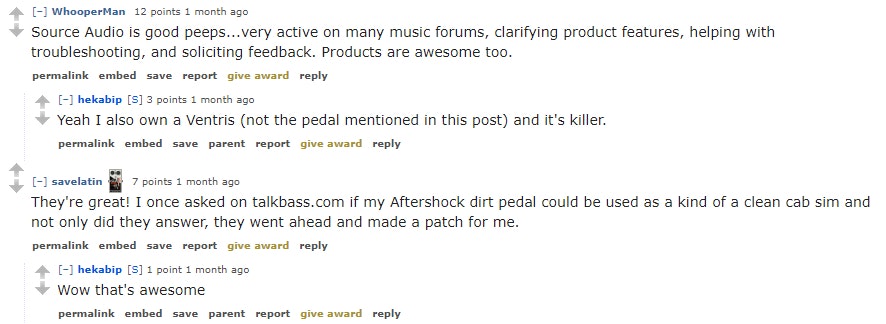
How to create an excellent customer service experience
There's a common misconception that you can break down customer experience into three key components: discovery, engagement, and delivery. While that may be true at the most basic level, those things need more individualized attention if you hope to create memorable, meaningful experiences like the ones above.
1. Ask for customer feedback
When providing a great customer experience, only one opinion matters: the customer’s. Even if you think you're doing everything right, if the customer isn't satisfied with the service, they won't continue to do business with you. Gathering business feedback from your customers is the best way to help shape and improve your customer experience — not only does this make current customers feel heard, but it also enhances the product to attract future customers better.
The best way to determine if you're meeting your customers' expectations is to ask them!
Customer satisfaction (CSAT) surveys are a straightforward way of asking your customers for their opinions. After each customer service interaction, a survey is sent to the customer requesting feedback on the support they received. Most CSAT surveys also include a follow-up question asking for more detail.

Beyond CSAT — a great way to understand customer needs at the transactional service level — NPS (net promoter score) is a solid indicator of how engaged a customer is with your brand.
Responses to these surveys show you where you're missing the mark when trying to meet your customers' needs. If you're responding too slowly, your tone doesn't sit right with the customer, or you haven't fully resolved their issue, they will let you know.
2. Offer different methods of communication
If you ask ten different customers how they want to contact you, you might get ten different answers. From email to phone to messaging platforms, customers correspond with businesses in an unprecedented number of ways.
Customers believe having options is an integral part of a good customer service experience.
NICE inContact found that "90% of consumers are more likely to consider doing business with a company that offers multiple ways to communicate." Furthermore, when CMO Council asked customers which channels they expected businesses to offer, a large number of customers expected to see at least the following five channels :
Email (86% of respondents)
Telephone (65%)
Website (53%)
In-person (48%)
One glaring omission from this list is social media: a channel that is growing in importance as crucial customer demographics shift. Social media support differs from website or app support in that it is very immediate and public — mistakes your team makes are immediately evident and hard to recover from.
Though the channel can be tricky, ensuring that your team knows when it’s time to bring a support conversation to a more private venue, such as direct messaging , can help provide a better customer service experience on social.
You may also want to consider implementing a multichannel support strategy. Multichannel allows your customer to switch quickly from one channel to the other with minimal effort — from social media support to email or phone support, for instance. This can be made easier by using support software that integrates with the social media platforms your customers prefer.
When you're able to offer more options, your customers have a better experience.
The Complete Guide to Getting Started with Social Media Support
Discover the benefits of supporting customers on social and get the tools you need to set a social media support strategy in motion.

3. Make it easy to get help
Sometimes the best customer service experience is the one that you don't even notice. We call these " boring customer service stories ." They don't sound like much, and often we don't even remember that they happened.
But customers don't want to have to jump through hoops to get help. In fact, 96% of customers who've had a high-effort experience report being disloyal in the future (compared to just 4% of customers who found it easy to get help).
It's easy to put up barriers between you and your customers through complex contact forms, policies, and escalations. Removing any obstacles can help provide a better experience.
Here are a few ideas on how to get started:
Create a helpful knowledge base that customers can search to help themselves.
Make it easy for customers to contact you through in-app support like live chat , and include your contact information in easy-to-find locations .
Find ways to eliminate restrictive policies that make customers work harder to change their accounts.
Self-service is a great way to empower your customers to get their answers without even needing to talk to a human, but it can be alienating for some. Make it easy for your users to find any self-service functionality you have and get additional assistance if self-service doesn't work for them. Nothing creates a worse experience than trying to provide something smooth and easy and having it be more challenging work — like needing to reach out to support after spending time searching through a help center article.
4. Respond quickly
No matter what study you look at, a quick response tops the list of what customers require for a good service experience. SAP Hybris found that 52% of customers chose quick replies as the most critical attribute of good customer service. In a Forrester study, 77% of customers responded that valuing their time is the most important thing a company needs to do.
There are several ways that you can help to decrease response time:
Hire additional staff
Work with a BPO (business process outsourcer)
Implement chatbots
Create self-service options
Utilize an AI to suggest documentation
These options, especially bots, can be incredibly impactful, but they can ruin a customer’s experience if something goes awry. Always implement functionality with your customer experience in mind. Don’t build something out just to make it easier for your team members to respond quickly — they also need to respond correctly and considerately.
Your customers don't want to wait around for help. Focus on reducing first reply time and making sure your customers feel like a priority. It's one of the most important things you can do to provide excellent customer service .
5. Build a culture of caring
Ultimately, providing a great customer experience comes down to the people. If the employees in your company aren't engaged and motivated to care about customers, any other initiatives will fall flat.
In PwC's Future of Customer Experience survey , 80% of Americans identified friendly service as one of the most essential elements of a positive customer service experience.
But even beyond being friendly, building a customer-centric culture has a ripple effect across all decisions. To create a culture of caring:
Build customer-centric culture questions into your hiring process. How have candidates improved the lives of their customers in the past? How do they respond to an angry customer in sample interactions?
Consider launching whole company support to shrink the distance between customers and internal employees. When everyone has a chance to hear how their actions impact customers, they become more customer focused in their day-to-day work.
6. Create multiple touchpoints
The point when your customers reach out to your customer service team isn't the only time they will consider when thinking about the experience you've provided. Attention to detail should be woven throughout multiple touchpoints within the customer journey.
Here are some touchpoints you might consider:
When a user first visits your site.
When they first create an account.
When they add a new user.
When they pay for a subscription.
Purchase anniversaries
The customer journey is super important to the customer experience. Ensure that you are hyper-focused on customer experience as you craft each step of their journey. If you provide an excellent customer service experience but they have a terrible time trying to purchase, all your hard work will be for nothing!
Develop a customer service experience worth shouting about
Your customer service experience can save the day when customers run into trouble. By providing quick, helpful service that gets your customers back on their feet, you can create brand advocates for life.
Like what you see? Share with a friend.
Sarah chambers.
Sarah is a customer service consultant and the founder of Supported Content . When she’s not arguing about customer service, she’s usually outdoors rock climbing or snowboarding. Follow her on Twitter to keep up with her adventures.

Get Started
Learn the platform in less than an hour. Become a power user in less than a day.
We've got more to share
The Supportive Weekly
For the customer service obsessed
In the Works
For founders and growing companies
Your privacy matters! Help Scout only uses this info to send content and updates. You may unsubscribe anytime. View our privacy policy for more.
Customer Experience
11 great customer service examples in 2023
Excellent customer service is essential for business. In fact, consumers are willing to spend 17 percent more with companies that deliver great customer service, according to American Express .
Unfortunately, it’s true that bad news travels faster than good news, especially in the age of social media. Most customer service stories online are about a bad customer service experience, and consequently, you don’t always hear about companies who are achieving customer satisfaction.
Keep scrolling to find customer service examples that will inspire, as well as tips for improving your customer experience.
What does excellent customer service look like?
The definition of “good” customer service is flexible, because it entirely depends on the level of expectation that customers have for your brand. This can be affected by variables such as your industry, product cost, brand reputation and more.
For example, if you’re flying in Economy, you don’t expect a 5* service with champagne and snacks - but if you were flying Business class, you’d be annoyed if those things weren’t provided for the higher cost of your seat.
What consumers expect from your customer service experience is the key factor in whether they perceive your brand to be great or terrible. Do they want to be able to resolve issues on multiple channels, or do they go to one channel for specific problems? Is your average response time more important to them, or is it how many self-service options you provide that matters? Is poor customer service the main reason why they might try a competitor?
Your support teams are your front line, shaping customer experience on a day-to-day basis. They can be proactively helpful in providing customer service that’s memorable, and turn a bad customer service experience around.
Investing in great service is worth your while. Don’t lose customers and brand loyalty by failing to meet and exceed expectations - grow your business’ revenue by ensuring that your excellent service keeps customers coming back.
Examples of good customer service experiences are more often than not the result of a kind, customer-centric service agents who are good at the following things:
Good customer service examples
- Responding quickly: A customer will appreciate fast response times when they want to ask a question or highlight a problem.
- Acting on customer feedback: When a customer support agent acts on the feedback they’ve received, it shows them that their opinion mattered.
- Showing empathy: Employees that try to understand a customer’s point of view make a customer feel valued, and can turn an angry customer into a happy one.
- Maintaining customer self-service options: Sometimes customers would prefer to find their own answer to problems rather than getting in touch with your customer service center. Having an up-to-date FAQ page or knowledge article base can be very helpful.
- Providing omnichannel support: Different communication channels can support customers that have busy schedules or want flexibility in how they connect with businesses. Your customer service teams need to be prepared to offer support through email, phone, live chat, and social media.
- Going the extra mile: When an employee is able to deliver excellent customer service beyond the customer’s expectations or adds a personal touch to the service experience, it can leave a positive impression and increase customer loyalty.
A less generalized amd more specific example of enhancing customer satisfaction and building loyalty is by offering discounts and coupons (depending on your industry and needs).
Why is delivering excellent customer service important?
There are several reasons why great customer service is important for your business. Below we list the most important ones.
Satisfied customers will spend more
According to Hubspot , 68 percent of consumers are willing to pay more for products and services from brands associated with excellent customer service. When you invest in delivering great customer service, you’re creating happy customers but also generating enough brand equity to charge a premium for your offering.
Your ROI will improve and profits will increase
Deloitte found that brands that were customer-centric were 60 percent more profitable when they were compared to companies that neglected to focus on customer experience. Your support team should be empowered to provide excellent customer service, not just for the customer’s benefit, but for your brand’s financial benefit as well.
Customers are more likely to forgive you
If you provide good customer service, you can convince customers to return, even if something didn’t go as they expected. Salesforce found that 78 percent of consumers will do business with a brand again after a mistake is made if the customer service is excellent.
Customer loyalty improves with great customer service
Microsoft says that a whopping 96 percent of customers believe customer service is vital when they’re choosing to be loyal to a brand. If you don’t provide customer service that meets expectations when dealing with an upset customer, you risk alienating them from returning to spend more. Quality service will help you to increase customer lifetime value.
A great customer experience means a higher chance of recommendations
Consumers who have a good customer service experience are more likely to recommend your brand to other people. Our own XM Institute found that consumers who rate a brand’s service as “good” are 38% more likely to recommend that company to others.
Real-life examples of great customer service
It's one thing to talk about what good customer service is in theory, and another to apply it to real-world companies. Below are eleven customer service examples from companies that go above and beyond, as well as the customer service tips we’ve taken from their stories.
- JetBlue - Thank frequent customers with small gestures
- Tesla - Meet your customers where they're at
- Adobe - Respond to customer service complaints before they happen
- Trader Joe's - Help those in time of need
- Coca-Cola - Get involved in social causes
- Zappos - Personally reply to every email
- Us! - Provide an exceptional event experience
- Sainsbury’s – Don't be afraid to change everything
- American Express – Give customers benefits that can be used globally
- Walmart - Invite customers into the company family
- The Ritz-Carlton Hotel Company – Turn customer errors into service opportunities
1. JetBlue - Thank frequent customers with small gestures
Paul Brown was flying JetBlue airlines when he casually tweeted that he couldn’t grab his Starbucks coffee before boarding the plane because he was flying out of the smaller terminal at Boston’s Logan airport. Within seconds of seeing the tweet, JetBlue sprang to action and the airport customer service reps delivered a Starbucks venti mocha to his seat on the plane. Brown was elated and raved about JetBlue on Twitter.
Good customer service takeaway : This is definitely one of those great customer examples other companies can learn from. The main takeaway? Your customers don’t always need large gestures, but just want to know they’re appreciated. In fact, 68 percent of customers leave because they perceive you don’t appreciate them. I’m sure after knowing his request was heard, Mr. Brown feels appreciated and he’ll be a loyal customer for a long time. Keep your company at the top of your customer’s mind, with good customer care by doing small acts for more people, instead of a few large things for a lot of people. Believe it or not, it's the simple things that count and produce loyal and happy customers.
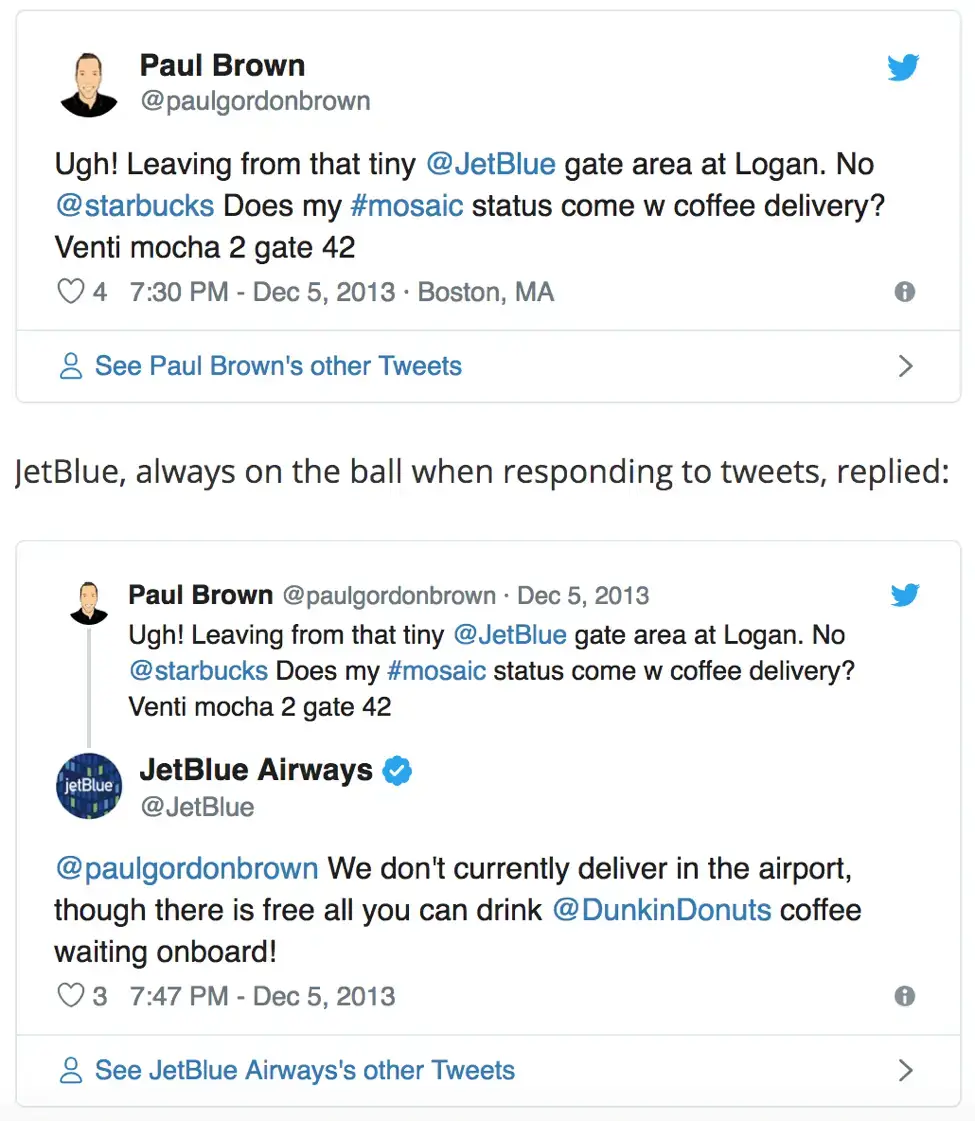
2. Tesla - Meet your customers where they’re at
Tesla literally meets customers where they’re at by going to the customer’s home and fixing issues on their car. It’s convenient for the customer because they don’t have to sit around a repair shop and it can be scheduled on their own time. This is an example of excellent customer service.
Flat tire on Sunday. Called Tesla, git a loaner tire within 40 minutes. Today they came to my house to replace the tire in 10 minutes. scheduled to come back to fix a small issue next week. What other car company does this? @elonmusk @TeslaModel3 @Tesla #mobileservice pic.twitter.com/GiNwOM3RJZ — Chris Kern (@cjk7216) October 31, 2018
3. Adobe - Respond to customer service complaints before they happen
When Adobe had an outage due to an issue with Amazon Web Services, they posted a tweet about it before they started getting customer complaints. The tweet contained a video of a puppy stampede as a distraction and lightened the mood. While there were some comments asking when the program would be running again, many replies focused on the adorable puppies.
Hi all, some Adobe services are down due to the AWS outage: https://t.co/U2qtybaT8J Here's a puppy stampede to take your mind off of it. ? pic.twitter.com/Glv6Anavje — Adobe Customer Care (@AdobeCare) February 28, 2017
4. Trader Joe's - Help those in time of need
An 89-year-old man was stuck in his house during a snowstorm and his granddaughter was worried he wouldn’t have enough food. She called around to several grocery stores and asked if they would deliver, to no avail. Finally, Trader Joe’s said they normally don’t deliver, but they would help. She read off a big list to the store and they delivered the entire order and more within 30 minutes, free of charge.
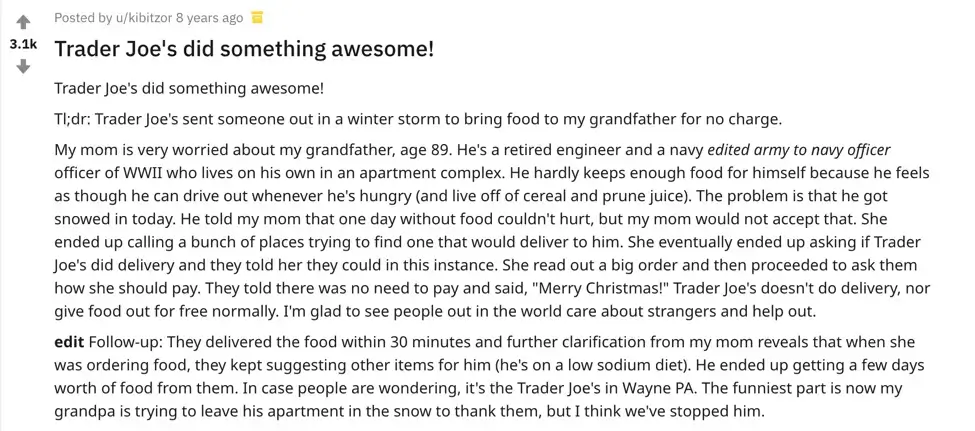
5. Coca-Cola - Get involved in social causes
Since 1984, Coke has given back more than $1 billion through the Coca-Cola Foundation. What’s great is they give back at the local level and not just to large organizations. For instance, Coke in Ireland initiated the Coca-Cola Thank You Fund , which gives €100K annually to local charities that empower young people, foster sustainability, and encourage diversity and inclusion.
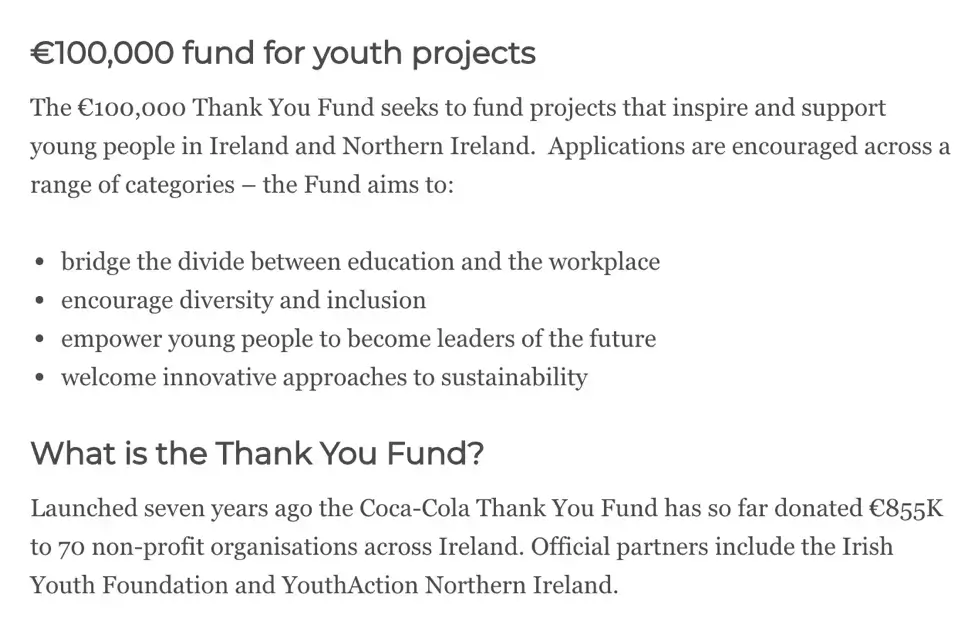
6. Zappos - Personally reply to every email
Zappos responds to every email it receives, even if it’s addressed to the CEO. In this case, a woman sent a request to Tony Hsieh and even though he was unavailable, his representative sent a humorous and engaging email back.
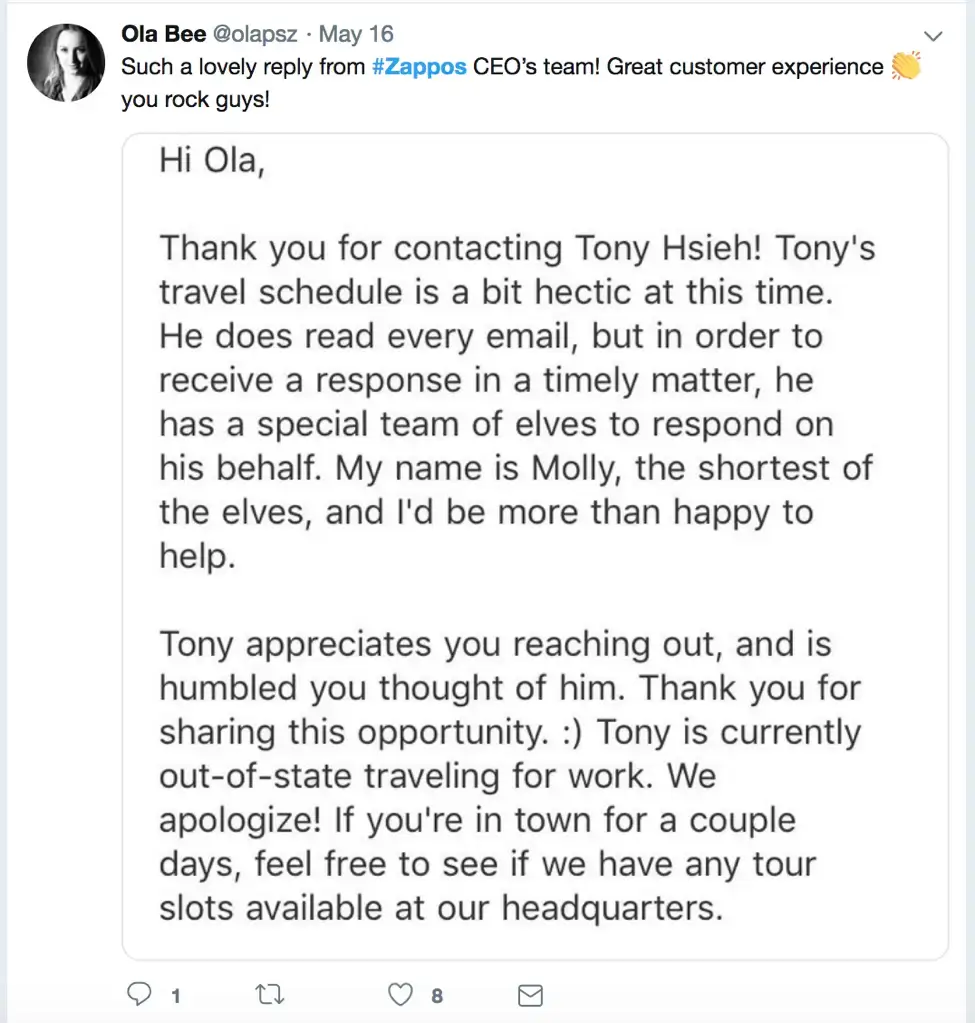
7. Us! - Provide an exceptional event experience
During many conferences that we attend, we send our “Qualtrics Dream Team” to fulfill customers' needs and wishes to make the event a truly exceptional experience. From food and drinks, to swag, to even vacations and massages, our team tries to fulfill as many requests as possible. They also collect customer feedback and make changes for a better event experience, such as room temperature and providing phone chargers.
Not a legal comment, but every other company listed here has some example of a customer thanking them for good customer service. I think our example would be stronger if we had something like that.
Curious to know how we run the Dream Team using our own software, or why we bring it to events like #CXOLeadersSummit ? Stop by our booth and we'll share all the secrets! Our team is here till 4pm AEST. pic.twitter.com/pEjfd2Jl8K — Qualtrics (@Qualtrics) August 8, 2018
8. Sainsbury’s – Don't be afraid to change everything
When Sainsbury’s, a UK supermarket chain, received a letter from three-and-a-half-year-old Lily Robinson, they ended up rebranding one of their products entirely. Lily thought their "tiger bread" didn’t resemble a tiger’s stripes at all – it looked more like the pattern on a giraffe. Sainsbury’s responded that the little girl was right and made new labels to share Lily's insight with other customers.
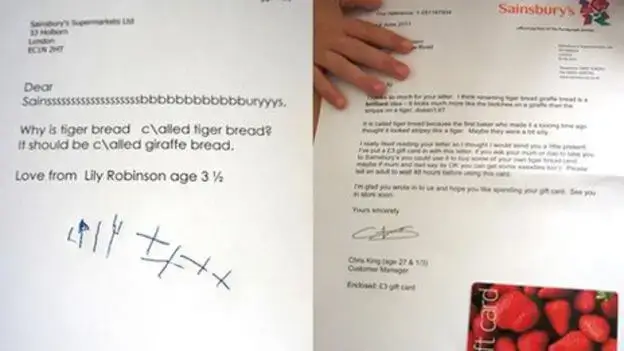
9. American Express – Give customers benefits that can be used globally
American Express maintains their position as a top-tier credit card company by offering its customers plenty of extra benefits: complimentary travel flight credit, insurance, and access to airline lounges to name a few. Combine these worldwide benefits with American Express's 24/7 support line and its global partners network and you have a company that truly connects with you wherever you are.

10. Walmart - Invite customers into the company family
Walmart has a reputation for being focused on providing value to everyday families. They live out their family focus through the way they treat their employees. When one of their associates turned 101 years old, they shared the news on Facebook and invited customers to participate in the celebration.

11. The Ritz-Carlton Hotel Company – Turn customer errors into service opportunities
Ritz-Carlton employees are allowed up to $2,000 to fix any guest problem, no questions asked. One example was told by customer John DiJulius, who left his charger behind at The Ritz-Carlton Sarasota. He received a next-day air package with his charger and a note saying ‘Mr. DiJulius, I wanted to make sure we got this to you right away. I am sure you need it, and, just in case, I sent you an extra charger for your laptop.’
How to provide great customer service
The best way to provide a good customer service experience is to gather feedback, set metrics and take action on your overall customer experience (CX) .
Why not check out our free survey template to collect feedback for customer service and contact centers? You can download it here.
With Qualtrics, you can track key metrics with a customer service benchmark report to help you to understand how your service is improving over time. Track interactions and feedback across the customer journey and customer service experience, and set action into motion to gain customer trust and loyalty.
Best customer service practices: Improving agent effectiveness
Diana Kaemingk
Diana Kaemingk is a contributor to the Qualtrics blog.
Related Articles
August 16, 2023
Seats upright, trays stowed: Virgin Australia takes off with customer-led innovation
Patient-centric innovation isn’t a numbers game – it’s a people game.
August 14, 2023
Who’s responsible: You or the machine? Everything you should consider about AI
August 7, 2023
Artificial Intelligence has already disrupted the contact center – it’s time to embrace it
August 6, 2023
From the showroom to the home and beyond: How Freedom united its entire team to deliver better CX
August 2, 2023
Creating value with CX is a team sport
July 21, 2023
How Rivian is revolutionizing the EV purchasing experience
June 20, 2023
How Xero inspired a CX transformation to win more hearts
Stay up to date with the latest xm thought leadership, tips and news., request demo.
Ready to learn more about Qualtrics?
- Online Degree Explore Bachelor’s & Master’s degrees
- MasterTrack™ Earn credit towards a Master’s degree
- University Certificates Advance your career with graduate-level learning
- Top Courses
- Join for Free
10 Customer Service Skills for Success in Any Job
Boost your business by mastering the most effective customer service skills.
![customer service experience assignment [Featured Image] Two women sit chatting and laughing at work, hunched over computers.](https://d3njjcbhbojbot.cloudfront.net/api/utilities/v1/imageproxy/https://images.ctfassets.net/wp1lcwdav1p1/4TbYnm3KPpcTDJdyAZUc4h/8be9166b06e2fa48a4b59be3d578aec9/GettyImages-1146500478.jpg?w=1500&h=680&q=60&fit=fill&f=faces&fm=jpg&fl=progressive&auto=format%2Ccompress&dpr=1&w=1000)
When you walk into a cosmetics shop, and the salesperson asks if you need any help, that is customer service. When you call your credit card company to dispute a charge and speak with a representative, that’s customer service, too.
Customer service plays an important role in attracting and retaining customers. Businesses can leverage good customer service to boost sales. Empathy, good communication, and problem-solving are core skills in providing excellent customer service.
In this article, you’ll learn customer service, its importance, and the top 10 customer service skills for a thriving business.
What is customer service?
Customer service is supporting customers before, during, and after their purchase. Someone providing customer service helps the customer navigate how to use the product or service and troubleshoot any errors or defects that may arise. The response is positive when a business is hospitable and puts customers first.
Today, businesses also need to meet customers where they are shopping. E-commerce sales in the UK are higher than in any other country, making up nearly one-third of the retail market [ 1 ]. That means customer service should consider how to meet online customers at every touchpoint, in addition to in-person or phone interactions, to foster a holistic customer experience.
Whether you are a restaurant owner, waiter, technology start-up founder, or UX designer, delivering good customer service requires a human-centric approach. Though it can vary by industry, here are some common examples of good customer service attributes:
Speed: Customer receives a quick response and positive engagement.
Multi-channel communication: Customer service is available on multiple platforms, such as telephone, social media messaging, or live chat.
Personalised: Customer service is tailored to each customer.
Proactive: Answers, such as FAQs and product information, are available without the need to contact the business. Any other needs or desires are anticipated and addressed.
Why is customer service important?
Good customer service can improve a company’s sales and brand reputation. Customers tend to spend more money if they feel special and the service is tailored to their needs. According to the UK Customer Satisfaction Index report from The Institute of Customer Service, 35 percent of customers in the UK were willing to pay more for excellent service [ 2 ]. This, in turn, helps develop a positive brand association for future purchasing decisions.
Beyond a business’s bottom line, strong customer service skills can yield benefits internally. Informal feedback generated from customer interactions can be an invaluable resource for improving user experience (UX) and product design. Furthermore, hiring respectful, empathetic employees can enhance team collaboration and well-being.
Brands known for customer service
Some of the biggest brands use customer service tactics to become associated with the brand. Apple is known for its personalised support portal, which allows you to view every product you’ve ever bought. It is linked to the Apple Genius bar, so you can easily book an appointment when you need support.
Ikea offers a 365-day return policy for every unopened purchase and 180 days for open shop-bought items, allowing customers to comfortably try out new items and decide whether to exchange for alternate products. Starbucks quickly replaces spilled drinks, and customers love seeing their names scrawled on the side of their coffee cups.
10 customer service skills for success
Anyone can learn these skills to build customer loyalty and foster strong relationships among employees and teams. You likely already possess some of these skills or need some practice to sharpen them.
Empathy is the ability to understand another person’s emotions and perspective. Delivering a good customer experience requires tapping into their headspace to fulfill their needs. It means reading cues and anticipating what they want. The outcome of empathy can look like treating customers kindly when they enter your restaurant, allowing for refunds within 30 days, and assisting them in their decision-making process.
Example: A customer calls their internet service provider complaining that their WiFi has been spotty over the past week. The representative says, “I understand how frustrating that can be. Let me do some tests to troubleshoot the issue.”
2. Problem-solving
Being able to solve problems is key to customer service. If a customer contacts the business with an issue or complaint, the employee needs to figure out why they are experiencing the problem and how to fix it. Solving the problem may require you to be patient and respectful as they explain the problem. You should be able to have the necessary technical knowledge to help the customer resolve the issue and help them prevent it in the future.
Example: Over live chat, a customer cannot reset their password to log into their account. The representative performs a manual reset and then walks the customer through how to reset their password in the future.
3. Communication
Communication can occur in many forms, through various channels, penetrating customers through in-person interactions, the instruction manual, and social media copy. Effective communication is utilising clear and concise language when educating customers on products and company policies so that they feel confident making a purchase and feel that they’ll be supported even after the purchase. When speaking with customers in person, body language should be positive, refraining from mumbling or crossing the arms and looking bored.
Example: A customer calls a local cafe to inquire about opening hours. The barista on the phone responds quickly and cheerfully instead of muttering incoherently and placing them on hold.
4. Active listening
Every conversation requires a listener and a speaker. Listening to a customer’s questions and concerns and responding in a way that makes them feel heard paves the way to a solution. Verbal cues like “mmm,” paraphrasing, and clarifying questions are all part of the practice of active listening.
Example: When a customer calls a restaurant to make a reservation, the host listens and then repeats, “You’re all set! To confirm, your reservation is 7 p.m. on Saturday at our London location.”
5. Technical knowledge
As a customer service professional, you’ll want to be familiar with technical and industry knowledge to help customers make informed decisions and troubleshoot any issues. Representatives should be up-to-date on all product specifications, purchasing processes, product or service usage, and company policies. Plus, technical knowledge is helpful if you’re trying to upsell a product or service because you’ll be able to list out the features of the newest edition.
A good practice for businesses is to list FAQs on their websites to empower customers to find information without contacting the support team.
Example: An electronics sales representative helps customers decide which mechanical keyboard to purchase by explaining every model, brand, and key type. They even convince the customer to opt for the pricier but higher-quality option.
6. Patience
Patience is handy when dealing with customers, especially if they are angry, resentful, or rude. A heated argument with a customer can diminish your brand reputation, especially given the star rating systems on Google Maps, Yelp, or Glassdoor, where your business might be listed. Practising compassion can help you deliver a positive customer experience. Your presence and actions can lift someone’s spirits instead of worsening a bad situation.
Example: A customer drops her umbrella while leaving the nail salon, ruining her just-polished nails. The nail technician calls her back with a smile and repaints the ruined nails.
7. Tenacity
Tenacity, the ability to remain doggedly persistent throughout a difficult situation, is a quality often overlooked but very important in customer service. Along with patience and developing a thick skin, tenacity is required to get the job done thoroughly and accurately. Customers appreciate it when service professionals walk them through the process when they need help. They are more likely to continue doing business with you if you have ensured customer satisfaction.
Example: A new landscaper makes a mistake when tending the lawn and accidentally cuts the client’s beloved rose bush. The next day, he drives several hours to find the same plant to replace it.
8. Adaptability
Customers want to be able to reach a business on nearly every platform. Their channel of communication might change depending on the situation. That means your customer service needs to be adaptable. Sometimes, the same customer contacts a business through different channels. Integrating customer information with a customer relationship management (CRM) system helps to streamline inquiries from multiple channels. It also helps to accommodate your customers' different backgrounds and personalities.
Example: A customer contacts a dermatologist by phone (with a headset) if they’re in the car and running late for their appointment but prefers to email or text for appointment confirmations and administrative questions.
9. Resourcefulness
Resourcefulness is a useful customer service skill in problem-solving. Finding innovative and quick ways to solve a problem can decrease time with each customer so that you can help more customers in a day. It requires familiarity with different departments within a business and referring customers if needed. Developing creative approaches to problem-solving is a skill that can be sharpened while on the job.
Example: An Australian company requires customers to pay for return shipping. Due to an uptick in complaints, the CEO decided to experiment with free shipping for two months to maintain the status quo. Five-star ratings increased shortly after that.
10. Positive attitude
Maintaining a positive approach to customer service can be difficult if your customers are frustrated with your product or service. A rule of thumb is to stay calm and try to meet the customer where they are, to empathise with their situation and why they might be upset. Driving customers away with a negative attitude will only cause more pain for the business, as it can lead to a poor reputation and a decrease in sales.
Example: A customer who bought a board game from the shop is upset because some important pieces are missing. The employee thanks the customer for their patience and understanding as they mail the missing pieces to them within one week.
Enhance customer service skills with Coursera.
Customer service skills are important across many industries and can help create a positive work environment for you, your colleagues, and your customers. With Knowledge Accelerators’ course Customer Service Fundamentals on Coursera, you’ll learn the necessary skills to give you an edge in the in-demand IT customer service industry, such as communication skills, empathetic behaviour, and problem-solving.
If you’re seeking a job in IT support, you’ll learn how to perform tasks such as computer assembly, wireless networking, program installation, and customer service with the Google IT Support Professional Certificate . Get started today and complete your programme in six months or less.
Give your team access to 8,000+ engaging courses and hands-on Guided Projects to help them develop impactful skills. Learn more about Coursera for Business .
Article sources
International Trade Administration. “ United Kingdom - Country Commercial Guide , https://www.trade.gov/country-commercial-guides/united-kingdom-ecommerce#:~:text=The%20biggest%20player%20in%20the,revenue%20in%20the%20United%20Kingdom.” Accessed May 22, 2024.
The Institute of Customer Service. “ UK Customer Satisfaction Index (UKCSI) , https://www.instituteofcustomerservice.com/research-insight/ukcsi/.” Accessed May 22, 2024.
Keep reading
Coursera staff.
Editorial Team
Coursera’s editorial team is comprised of highly experienced professional editors, writers, and fact...
This content has been made available for informational purposes only. Learners are advised to conduct additional research to ensure that courses and other credentials pursued meet their personal, professional, and financial goals.
How to answer "What is your experience with customer service?" (with sample answers)

Why Employers Ask This
Employers ask about your experience with customer service because it is an essential skill in many job roles. Whether you are working in retail, food service, hospitality, or any other customer-facing industry, you need to be able to communicate effectively with customers. Companies want to hire individuals who can provide excellent customer service, resolve issues efficiently, and create a positive experience for customers.
In addition, employers want to gauge your experience with difficult customers. Customer service can be challenging, and customers can be demanding, angry, and even abusive sometimes. Therefore, employers want to assess your ability to handle pressure and manage customer's needs and expectations.
How to Answer the Question
When answering the question, "What is your experience with customer service?" in a job interview, keep the following tips in mind:
- Highlight your relevant experience: Discuss any previous job roles where you have interacted with customers and provided excellent service. Provide examples of a time when you handled customer complaints and resolved issues to the customer's satisfaction.
- Show your communication skills: Customer service requires excellent communication skills, both verbal and written. Talk about how you addressed customers' concerns and effectively communicated with them, even in challenging situations.
- Discuss your ability to handle pressure: The interviewer may want to assess your ability to handle stress, particularly when dealing with difficult customers. Mention how you remained calm, empathetic, and professional in resolving the customer's concerns.
- Emphasize your ability to work in a team: Customer service is often a team effort. Bring up any instances where you collaborated with colleagues or worked in a team to provide seamless customer service experience.
Remember to be honest and concise in your response. Provide specific examples to back up your claims, and avoid generalities. Your answer should demonstrate that you have the skills and experience needed to excel in a customer-focused role.
Sample answers:
"I've never worked in customer service before, but I'm really good with people. I think I could figure it out pretty quickly."
This answer is bad because it doesn't address the question directly. The interviewer wants to know if you have experience in customer service and how it relates to the job you're applying for. Saying that you've never worked in customer service isn't a good start, and then trying to pivot to a vague positive is unlikely to impress the interviewer.
"I've had some limited experience with customer service in my previous role, where I occasionally had to help field customer complaints. I found that I really enjoyed the opportunity to help solve problems and make customers happy."
This answer is okay, but it could be stronger. It does address the question by acknowledging some customer service experience, but it doesn't provide much detail about what the experience was or how it relates to the job being applied for.
"I've worked in customer service for the past two years in a call center, where I handled an average of 50 calls a day. I'm experienced in de-escalating tense situations, solving customer problems, and ensuring customer satisfaction. I understand that each customer is unique, with their own problems and concerns, and I always strive to listen and address their needs."
This answer is great because it directly and specifically addresses the question while also highlighting the applicant's experience and skills. By providing concrete details about the type of customer service work they've done, the applicant demonstrates their competency and experience in the field. This answer also shows the interviewer that the applicant has a customer-focused approach and has experience dealing with difficult situations.
"I have over five years of experience in customer service across various industries, including retail, hospitality, and healthcare. In my role as a customer service manager at XYZ company, I oversaw a team of 12 customer service representatives and implemented a new training program that resulted in a 25% increase in customer satisfaction ratings. I'm passionate about delivering exceptional customer service and I believe that my experience and skills would enable me to thrive in this role."
This answer is great because it not only directly answers the question, but it also goes above and beyond by offering specific examples of the applicant's experience managing customer service teams and implementing successful initiatives. By highlighting their passion for customer service, the applicant shows that they are not only skilled but also enthusiastic about the work. This answer would likely leave a positive impression on the interviewer.
You’re using an older browser version. Update to the latest version of Google Chrome , Safari , Mozilla Firefox , or Microsoft Edge for the best site experience.
- eLearning Blog
- eLearning Basics
- Instructional Design
- Corporate Training
- Course Selling
- Manufacturing
- Products iSpring Suite iSpring Learn
- Use Cases Onboarding Compliance Training Induction Training Product Training Channel Partner Training Sales Training Microlearning Mobile Learning
- Company About Us Case Studies Customers Partnership Course Development Contact Us
- Knowledge Hub Knowledge Hub Academy Webinars Articles Guides Experts on iSpring
- Language EN English Français Deutsch Español Italiano Nederlands Português Polski 中文 日本語 العربية Indonesia
- Shopping Cart
13 Customer Service Role-Play Scenarios: (+Scripts to Master)

Table of Contents

As illustrated in the mind map above, each type of scenario branches into multiple options. For example, if a customer is having an issue with a product, the first step toward resolving it is determining who is responsible.
As shown above, if the issue originates from the company’s side, it requires different responses compared to when it stems from the client’s end.
However, how do you express all these different options in a way that allows your employees to navigate this naturally in a virtual environment?
Well, with iSpring Suite , you can build a dialog tree, a well-organized structure that you can manipulate with a single mouse click .
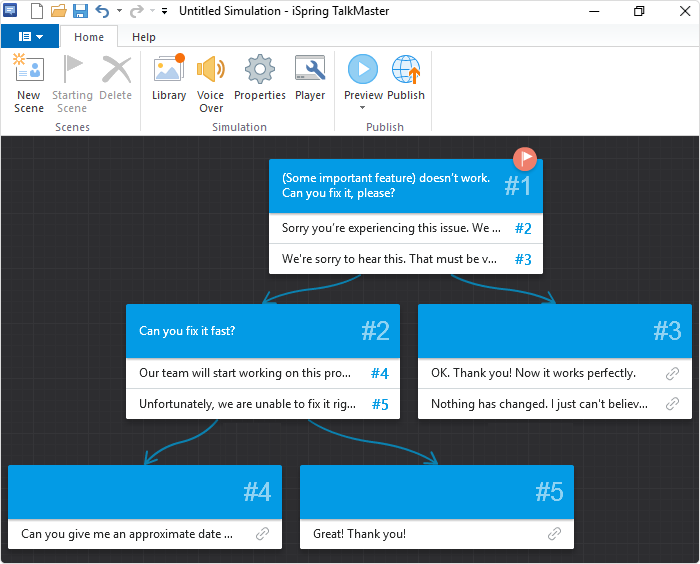
To make the conversation even more complex and realistic, you can add locations and characters. You can upload your own images or use the built-in collection. Content Library , which comes with an iSpring Suite Max subscription , offers a wide range of characters from various ages, ethnicities, and professions, along with an extensive selection of backgrounds appropriate for business, manufacturing, education, medical, and travel settings.
Check out this iSpring demo to get a better idea of what these powerful scenarios look like .
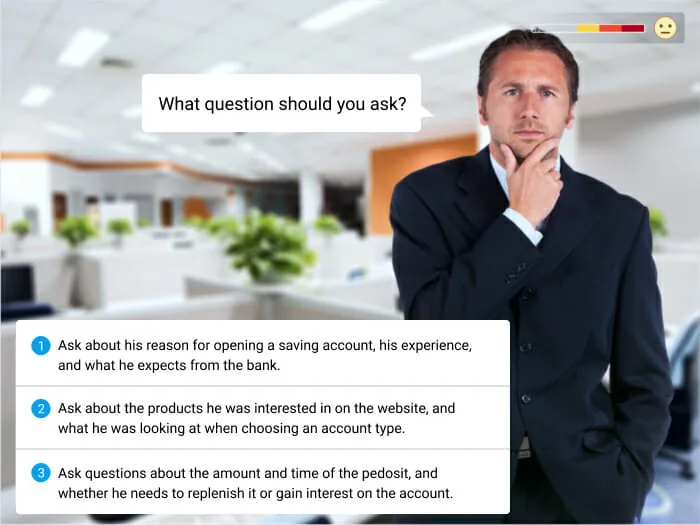
While these dialogue simulations might look technologically sophisticated, they are quite easy to navigate with the right software and guidance.
Read our article on how to improve your employees’ communication and negotiation skills using dialogue simulations .
The best part of online customer service scenarios is that your employees can dive deep into a simulation while selecting responses that naturally align with how they would act in real life. Based on their responses and your predesigned branched scenarios, they’ll be able to experience the productive and counterproductive consequences of actions and responses chosen in a risk-free environment and receive positive feedback on their progress .
Customer service is core to the success of any thriving business. You should never underestimate the power of a happy customer, negative press, or word of mouth.
The way your employees interact with customers can make or break your business reputation. That’s why you should never take employee training for customer service lightly.
As people learn best through experience, creating a virtual environment that’s immersive, engaging, and risk-free is the best approach.
If you’d like to create customer service scenarios, interview questions and answers, or simulate situations surrounding software troubleshooting, sales techniques, and more, then you can get started today by downloading a free trial of iSpring Suite !
Fast course authoring toolkit
Create online courses and assessments in record time.

Content creator:
Sydney Mansaray
Sydney is an Instructional Designer with over 8 years of experience developing online courses and training programs for companies and educational institutions. Her focus is designing engaging learning experiences that marry storytelling with technology.
You might also like this

Subscribe to our blog
Stay tuned to get our latest eLearning tips and tricks!
By clicking “Subscribe”, you agree to our Privacy Policy . All emails include an unsubscribe link, so that you can opt-out at any time.
We use cookies to give you the best possible experience on our website and also for analytics and marketing purposes. You can enable or disable optional cookies as desired. See our Cookie Policy for more details.
Manage your cookies
Essential cookies are always on. You can turn off other cookies if you wish.
Essential cookies
Analytics cookies
Social media cookies
Get 25% off all test packages.
Get 25% off all test packages!
Click below to get 25% off all test packages.

Customer Service Assessment Tests
- 264 questions
A majority of jobs include working with customers or clients in some capacity, so many people find themselves in need of the skills necessary for these roles. This guide details the kind of tests that may be required when applying for a customer service role, and how best to prepare for them.
What is a customer service aptitude test?
Customer service teams are essential in providing excellent customer service and customer satisfaction. To be successful in this type of role, there are skills and behavioural traits that an employer can assess to accurately predict how well employees will perform in a customer service role.
A customer service test helps identify candidates with those important customer service skills needed to be successful. You’ll find that most exams assess skills like communication, comprehension , logic , and personality traits .
Why do employers use customer service assessment tests?
While experience is valuable in customer facing roles, using aptitude tests focused on the skills needed for excellent customer service are an effective way to assess someone’s skills and potential. This is especially helpful when recruiting for a role that garners a lot of competition between similarly qualified candidates, since the tests give more data that employers can use to rank applicants.
Customer service roles also require a certain kind of person who has the right kind of temperament and interpersonal skills; without significant time spent with someone, it is hard to gauge these during the recruitment process.
By using customer service skill tests that include sections like a personality test, employers can get a more accurate understanding of you as a person and whether you will be a good fit for the company in a less time-intensive way.
What skills do customer service assistants typically need?
While customer service roles do not typically require specific technical skills and qualifications, there are still traits required to thrive in this sector. These are just a few of the most important ones that employers will look for when you apply for these roles:
Communication skills
The first skill is one of the most important: strong communication. While this is vital for any job, customer service is almost entirely about working directly with customers and clients, such as on the shop floor, when answering on the phone and dealing with customer support queries.
As a customer service assistant, you are the main representative of the company to the public, and therefore you must be able to communicate professionally in all kinds of situations.
Comprehension skills
Related to your communication skills is your comprehension ability, which is how well you process and relay information. General reading and writing skills are essential to everyday life, but working in customer service means processing a lot more information than most on a daily basis, so you need to show that you are capable of this.
Problem solving and decision making
In customer service roles, you typically deal with customers and their issues immediately, meaning that unexpected situations occur suddenly and can require you to make quick decisions.
While you may not always be able to solve an issue on the spot, showing that you follow a logical process and understand how to make the most progress you can at the time is a vital workplace skill.
Roles like customer care representatives and customer support agents will need excellent problem solving skills since their interactions with customers are continuous and require immediate action.
Adaptability
Adaptability is hugely important when working with people, as you have to be able to deal with any situation that is put in front of you. Customer service is a fast-paced sector and often no two days are the same, so being open to change in routine and taking on varied tasks is part of the job.
When dealing directly with customers your ability to come across as friendly and empathic will have a big effect on how well you are received. Depending on the industry that you work in, you may be dealing with something very personal to your customers and have to be understanding of every single person’s situation. Being empathetic will ensure you receive positive customer feedback.
Ability to work under pressure
When things get busy, customer service roles like retail can be stressful environments to function in. The ability to keep calm and professional under pressure is important to keep things moving, and make sure that you still provide the quality of service that the customers expect from the company.
How are these key skills measured?
There are a number of tests that are used to assess your skills and cognitive abilities. Aptitude tests give recruiters objective data that they can use to compare candidates: therefore, your score on these tests will have a big influence on whether or not you get hired.
For the more subjective tests like personality assessments, they are typically measured against the answers of current employees and the company’s ethics and values, to show how closely you align.
Writing task
In order to test your communication skills, including general literacy and comprehension skills , you may be asked to complete a written task . There are a few different kinds of written exercises that are used for different types of jobs, but the most common are writing a formal letter, an email, or proofreading a piece of text.
By doing this, employers can see your communication style, your level of grammar and spelling, and how well you understand context and tone when communicating.
Verbal reasoning test
A verbal reasoning test differs from a writing task because it does not ask you to craft anything, but instead focuses on your comprehension and logic skills.
The typical verbal reasoning question will present you with a passage of text and then you will be asked to answer questions based on the information given, usually in the style of true/false/cannot say , which show how well you filter key information and follow a logical process.
Situational judgement test
Many of the skills that employers are looking for when it comes to customer service are best gauged through a situational judgement test . Here you will be presented with work-related scenarios and asked to pick or rank responses according to what you think is most appropriate to the situation.
This can give a very accurate insight into your working style; for example if you are confrontational or how well you work in a team.
Personality tests
Personality tests are the aptitude test that most people are familiar with. They are a broader and more in-depth look into your behaviour than situational judgement tests, which give you limited parameters in which to answer.
A personality test can assess all kinds of aspects that are much harder to gauge during the limited contact of the recruitment process such as: your working style, how you build relationships, your values and ethics, how you see yourself, etc.
E-tray exercise
To assess how you might perform when actually on the job, employers like to use an e-tray exercise to simulate real-life working scenarios. You will be given a selection of different tasks that might be expected of you during an average day and then assessed on how well you deal with the workload.
This means it is not just about doing the tasks well, but also showing that you understand how to prioritise tasks, manage your time, and perform under pressure.
Prepare yourself for leading employers

Top tips for customer service tests
1. research the company.
While this is always important, it can be particularly helpful when applying for customer service positions, since you are expected to be the face of the company and are often the only representative that a customer will talk to. Make sure to research how the company operates, so you can learn what kind of service style it looks for on the situational judgement and personality tests, which are where you will show if you are a good cultural fit.
2. Take a personality test
More subjective aptitude tests like personality and situational judgement tests can feel daunting, as they do not have right or wrong answers. However, by taking personality tests beforehand you can get an understanding for the answers you naturally gravitate towards and what kind of results you get.
3. Get used to the pressure
One of the most difficult aspects of test-taking is the time pressure, so it is very important to get used to performing well under timed conditions. Try to complete as many practice assessments under exam conditions as possible, to show how well you work in stressful situations.
4. Be confident
A key part of customer service is confidence in your skills - you will likely be dealing with a range of different scenarios such as angry customers, customer support queries and customer complaints. You’ll need to be confident for taking the test as well. Trust your experience and knowledge to show that you understand expectations and have the skills needed to excel in the role.
5. Be customer obsessed
Exceptional customer service skills are critical to being successful. Gaining customer loyalty and serving people to the best of your ability means you have to be customer obsessed. Approaching the exam within mindset can help with the answers you select.
Sample Customer Service Assessment Tests question Test your knowledge!
A customer service department tracks the resolution time for customer inquiries. If the inquiries follow a pattern where each subsequent inquiry takes 5 minutes longer to resolve than the previous one, and the first inquiry takes 10 minutes, how long will the 4th inquiry take to resolve?
An online retailer’s customer service team receives an average of 120 inquiries per hour. During a peak season, this average increases by 20%. How many inquiries does the team receive on average per hour during the peak season?
- 144 inquiries
- 140 inquiries
- 150 inquiries
- 130 inquiries
If a customer service team handles a call every 6 minutes, how many calls can they handle in a 3-hour shift?
A team of 8 customer service agents working 8 hours a day resolves an average of 128 tickets daily. If 3 new agents are added to the team, how many tickets can be expected to be resolved each day, assuming each agent’s productivity remains the same?
- 176 tickets
- 150 tickets
- 200 tickets
- 160 tickets
During a new promotional campaign, email support inquiries to customer service increase by 25%. If the team typically received 80 emails per day, how many emails are received per day after the promotion begins?
Start your success journey
Access one of our Customer Service tests for FREE.
I could prepare for specific companies and industries. It’s been an invaluable resource.
Sean used Practice Aptitude Tests to prepare for his upcoming job applications.

Hire better talent
At Neuroworx we help companies build perfect teams

Customer Service Assessment Tests Tips
1 familiarize yourself.
Get to know the format of customer service aptitude tests by previewing what you can expect. At Practice Aptitude Tests, you’ll find examples that show the style of questioning and the types of scenarios you’ll be tested on. Understanding the test layout and type of questions in advance can greatly reduce test-day anxiety and help you perform at your best.
2 Simulate Test Conditions
Creating an environment similar to the actual test setting can work wonders. Find a quiet place, set a timer, and take practice tests as if it’s the real deal. This method helps improve your time management skills and ensures you are comfortable and less stressed when taking the official test.
3 Reflect on Practice Test Results
After completing each practice test at Practice Aptitude Tests, spend time reviewing your answers, particularly the ones you got wrong. Understanding your mistakes is a pivotal step toward improvement. Reflecting on your results will help you learn and remember the right approach for future tests.
4 Work on Your Weak Spots
Identify the areas where you have room for improvement and make them your focus during your practice sessions. Use the tailored practice exams available to hone in on these weak spots. Consistent practice in areas that challenge you will build your confidence and skills, leading to better overall performance.
5 Stay Positive and Relaxed
A positive attitude and a relaxed mind can impact your performance significantly. Create a study schedule that allows for adequate rest and free time. This balance ensures that you’re well-rested and in the right mindset when you sit down to take both practice and actual customer service aptitude tests.
Prepare for your Customer Service Test
Immediate access. Cancel anytime.
- 30 Numerical reasoning tests
- 30 Verbal reasoning tests
- 30 Diagrammatic reasoning tests
- 30 Situational judgement tests
- 34 Publisher packages e.g. Watson Glaser
- 252 Employer packages e.g. HSBC
- 29 Extra packages e.g Mechanical
- Dashboard performance tracking
- Full solutions and explanations
- Tips, tricks, guides and resources
- Access to free tests
- Basic performance tracking
- Solutions & explanations
- Tips and resources
Customer Service Assessment Tests FAQs
How do i prepare for a customer service test.
A customer service test can include a wide variety of questions from all kinds of aptitude tests like verbal, personality and situational, so be prepared for this. The best way to prepare for any test is to practice; you can do practice customer service tests , but it is also a good idea to identify your weakest area and focus on that to potentially improve your score the most.
What skills do customer service assistants need?
It is a misconception that customer service is unskilled labor. It actually requires a number of skills that not everyone possesses. The main skills sought after in customer service assistants are:
- Strong written and verbal communication
- High stress tolerance
- Friendly and empathic
- Good intuition
How can I pass my customer service test?
Make sure that you are prepared by doing practice tests beforehand. Our resources page has loads of information about all the different kinds of aptitude tests and how best to prepare for them, so take a look through to find helpful tips and tricks that can help you to pass.
What questions are asked in a customer service test?
This is highly dependent on the sector that you are applying for, so the first thing to do is to make sure that you know the job and person specification in detail. For tests such as the situational judgement one, the questions will most likely ask you to respond to potential problems you might face such as:
- What to do when you are struggling to answer a customer’s questions
- How you would respond to a miscommunication with a colleague
- How you would work to implement better business practices
You can also try and find out the specific test publisher that the company uses for their tests, in which case you might be able to find their practice papers and get a better idea of how they typically structure their tests.
Reviews of our Customer Service tests
What our customers say about our Customer Service tests
Amelia Naranjo
United States of America
September 07, 2023
It was a challenge
I liked it a lot because I like the challenges but I do consider that calculations had to be done to know the exact values and there was not enough time (that dislikes to me) but I had to use logic to be able to answer
Starr Leonard
August 03, 2023
This test utilized a lot of math and analytics skills. I thought it would be more about people skills.
Sudharsan M
Good to practice and it inmproves our thinking
I like the way questions asked and what i dont like is a type of questions. it would be nice many other sections involved
June 23, 2023

Percentages
I like that the time is adequate however because the questions are math related, it was a bit difficult for me.
Aluko Samuel
A very good test to make one prepare for an interview
I enjoyed how difficult the questions were. And I’d love to take more so I can prepare fully for the test
Małgorzata Wawrzyniak
United Kingdom
June 22, 2023
Awe test was great 😃 just my internet connection was lost few times but its fantastic training Thanks 🙏
Disha Ganatra
April 25, 2023
Increases knowledge how to study graphs
Like the way the graphs were presented. Questions were not predictable. Though to give answer in limited time.
P Sachidananda Patro
March 02, 2023
Quite good of financial related
Quite good of financial related it will increase calculating mindset. Nothing to dislike I love the test I learned so many things
Annabella Losco
February 13, 2023
I found it surprising that the test was mainly focused on Maths rather than communication as I would have expected. Still, I found it extremely useful!
Babatunde Hassan
February 06, 2023
Quantitative Reasoning
It's a bit tough. Though, I wasn't expecting this kind of test that involves graphical representation. I was nearly caught unaware. I was unable to attempt all the questions.
By using our website you agree with our Cookie Policy.
- Customer service
15 Examples of Tricky Customer Service Scenarios + Ready-Made Answers
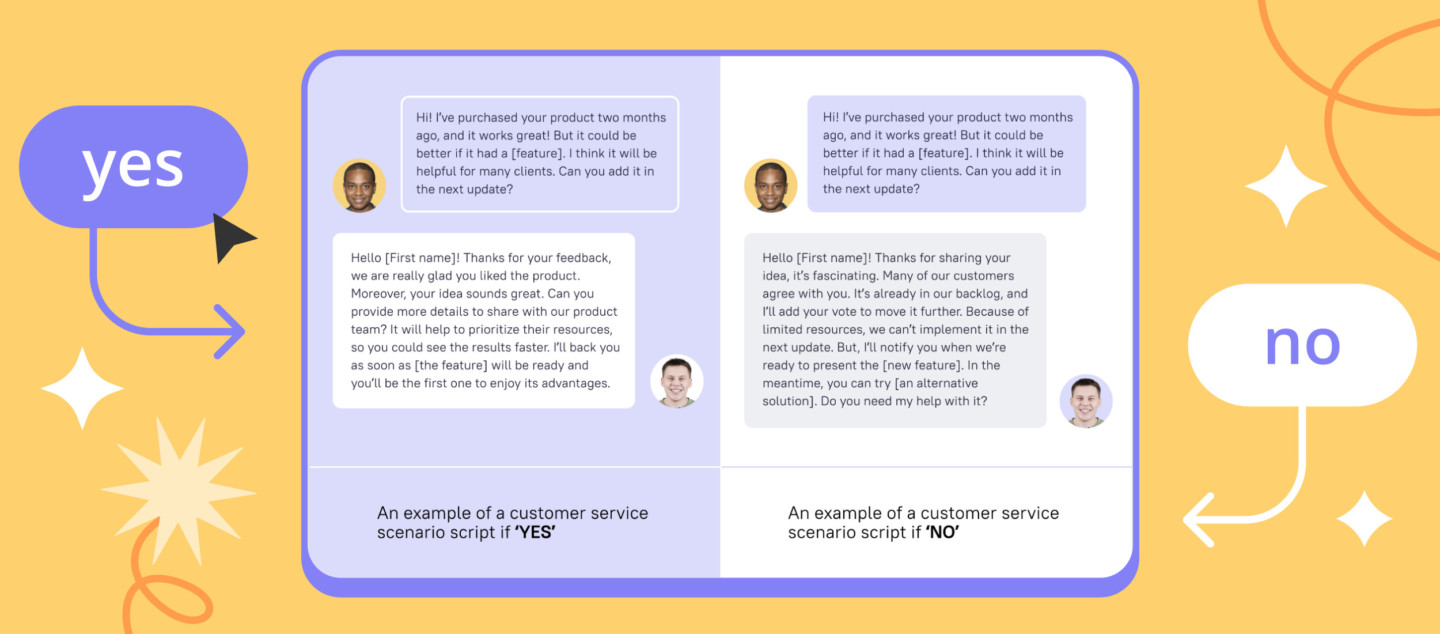
People can be jerks. But still… upset, disgruntled, angry ー even the most difficult client can be negotiated. It’s a lesson Kevin took this week, the hardest of his career in customer support. During these days, he handled 15 tricky customer service scenarios, most of which looked like lion-taming. Never once Kevin fell for the provocations, dodged all the client biting and scratching attempts without a shadow of fear.
How did he turn the lion’s roar into the kitten’s purr? Neither years of negotiator experience nor secret FBI methods of mind control nor superpowers are needed.
It’s just excellent training to answer all the same customer service scenario questions repeatedly. Since most are repetitive and fall into a finite number of categories, we’ve collected them into this guidance!
Here you’ll find examples of the most difficult cases for role-plays and free scripts for dealing with angry customers to provide excellent customer service.
Let’s dive into customer service scenarios and answers 👇
What Are Customer Service Scenarios?
You’ve probably had that déjà vu feeling when it seems you’ve been somewhere or done something before. Working with customers, you feel it daily. Most of the issues are typical situations. But putting them together, you’ll have a set of repeatable problems and a set of relevant replies accordingly.
Customer service scenario is a schematic script of pre-made actions and answers to solve an irate customer’s situation that you’re likely to encounter as a support manager.
Let’s say you’re starting your first shift. There’s one more customer ticket. But instead of ordinary sentences describing an issue, you see a crazy rant from an angry customer.
The longer it takes you to answer, the higher chances you can kiss that customer goodbye.
That’s when you’ll be thankful to have a list of ready-made reply options . It can be a flowchart describing possible questions and answers to them
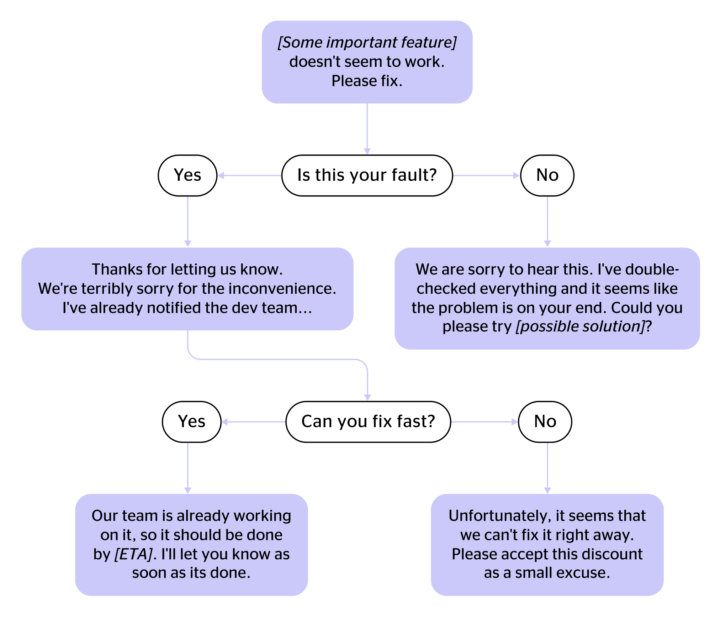
…or step-by-step role-play script on how to solve the problem. I say ‘a problem’ because dealing with difficult customers can drive you crazy. That’s why all the relevant content you may google concentrates on challenging situations first. Just like the ones Kevin had this week.
In case you don’t have time to read our customer service role play scenarios👇
Thanks! Now check your inbox
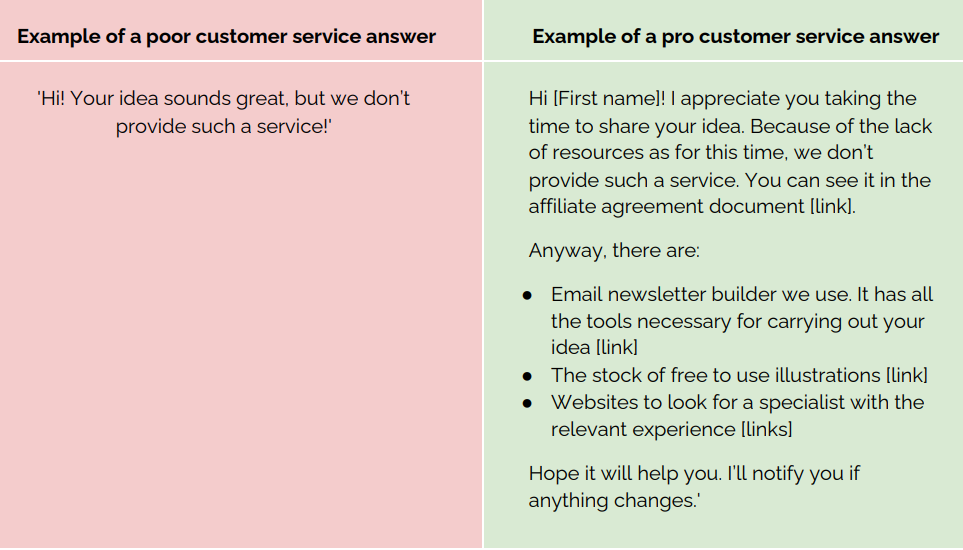
How can role-playing help to improve your customers’ experience?
The problem-solving skill that emerged through hands-on experience is a good advantage. The primary task here is not to lose your mind while learning. There is a kind of experience that is better to have in theory. Your nervous system will be thankful if you develop it through training exercises like customer service scenarios scripts. Consider role-playing scenarios if you don’t want nervous wreck crazies in your service team.
Customer service managers training via acting out roles in retail, pharmacy, SaaS, etc. scenarios are usual. That’s what helped Kevin to succeed. Each week he did role-playing exercises where you offer one-the-fly solutions to irate customer situations represented by a supervisor. It helps to fill the knowledge gaps and points them in the right direction.
Save your team time by delegating clients FAQs to Dashly AI chatbot. He can easily answer even difficult questions based on your knowledge base info
Customers service role-play is a quick way to:
- Test how newcomers would cope with typical client service scenarios in an interview
- Training your managers to deal with difficult customers
- Adopt the best customer communication practices
- Deal with business crisis scenarios (website crash, data loss, payment difficulty, etc.)
But the primary job it does is improving your service. Time to move to practice difficult customer service scenarios. So, let’s go back to Kevin.
15 tricky customer service cases to practice
Speaking about a rough week, I meant 15 customer service situations Kevin dialled with. It’ll be honest to nominate him for the title of customer support knight after this story. Believe me, there’s a lot to learn 👇
1. Customer requested a product feature
2. Customer asked for an item that is missing
3. When you have to transfer a call to another manager
4. Customer asked a question you can’t answer
5. Customer asked, ‘Why is your tool the best alternative? ’
6. When you have to say NO
7. Customer asks you to violate the company’s rules
8. Customer breaches company’s terms of use
9. When it was your fault
10. Angry customer asks for a manager
11. When the price is too high for a customer
12. Customer asks for a refund
13. Irate customer complaints about a shipping delay
14. Customers complain about a product quality
15. Angry customer is verbally abusive
Customer case 1: Feature request
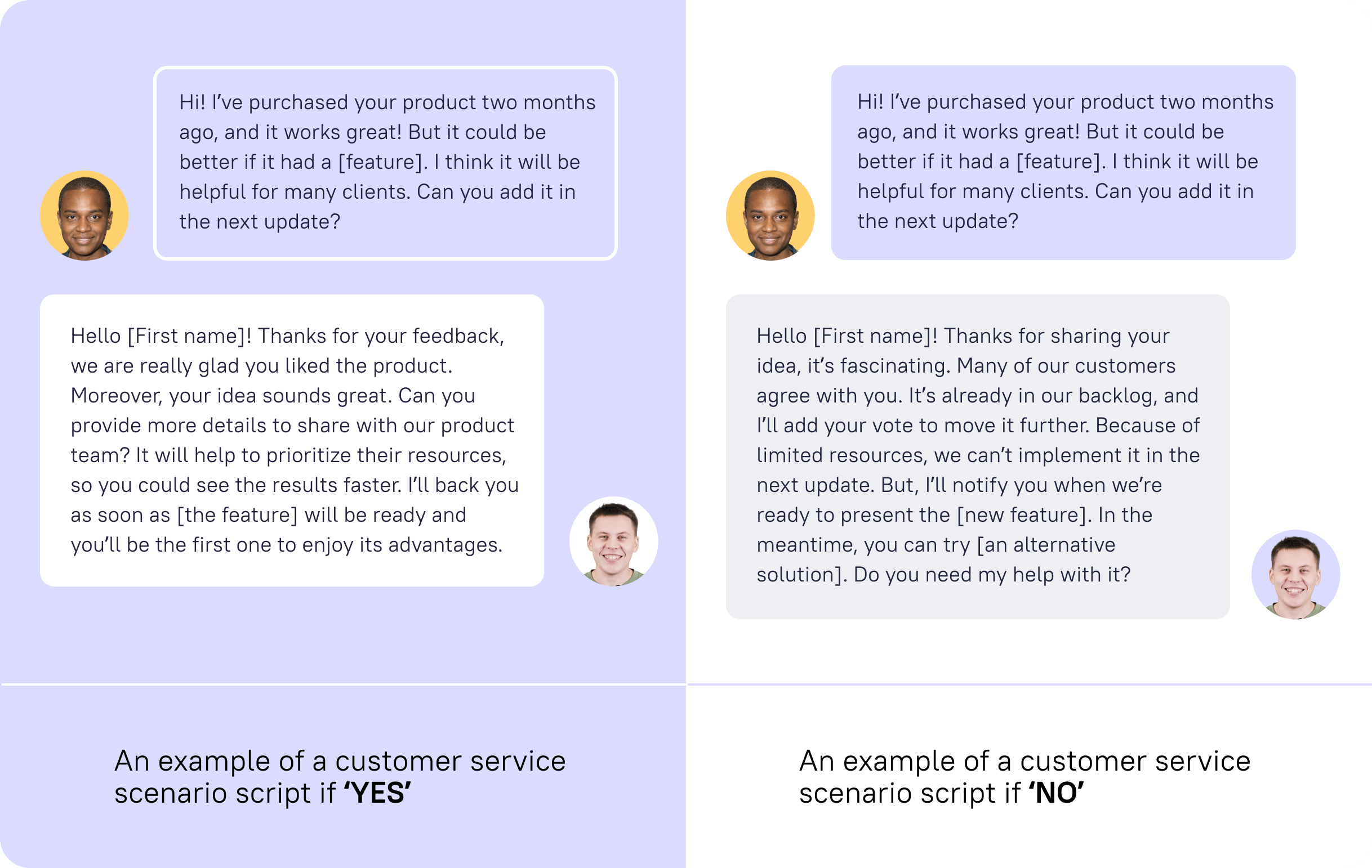
Customers are a precious source of ideas for business growth . That’s why this type of customer should be a priority for any company.
Client request example:
Hi! I purchased your tool two months ago, and it works great! But it could be better if it had a [feature]. I think it will be helpful for many clients. Can you add it in the next update?
But it’s problematic since a new feature implementation isn’t a matter of minutes. No false promises ─ the first rule here. Such tickets can make newbies nervous. But not Kevin. The first thing he thought about after reading the request for a specific feature was whether the business plans to add it.
An example of a customers service scenario script if ‘YES’
Hello [First name]! Thanks for your feedback, we are happy you liked the product. Moreover, your idea sounds great. Can you provide more details to share? It will help to prioritize their resources, so you can see the results faster. I’ll back you as soon as [the feature] is ready, and you’ll be the first to enjoy its advantages.
An example of a customer service scenario script if ‘NO’
Hello [First name]! Thanks for sharing your idea. It’s fascinating. Many of our customers agree with you. It’s already in our backlog, and I’ll add your vote to move it further. Because of limited resources, we can’t implement it in the next update. But I’ll notify you when we’re ready to present the [new feature]. In the meantime, you can try [an alternative solution]. Do you need my help with it?
Tips to keep in mind:
- Thank a prospect for the advice
- Explain when you are going to add the feature or why not
- Offer an alternative solution
Eliminate mistakes by delegating resolution of such requests to AI chatbot. Teach him based on scripts from this article or your knowledge base
Customer request 2. The asked item is missing
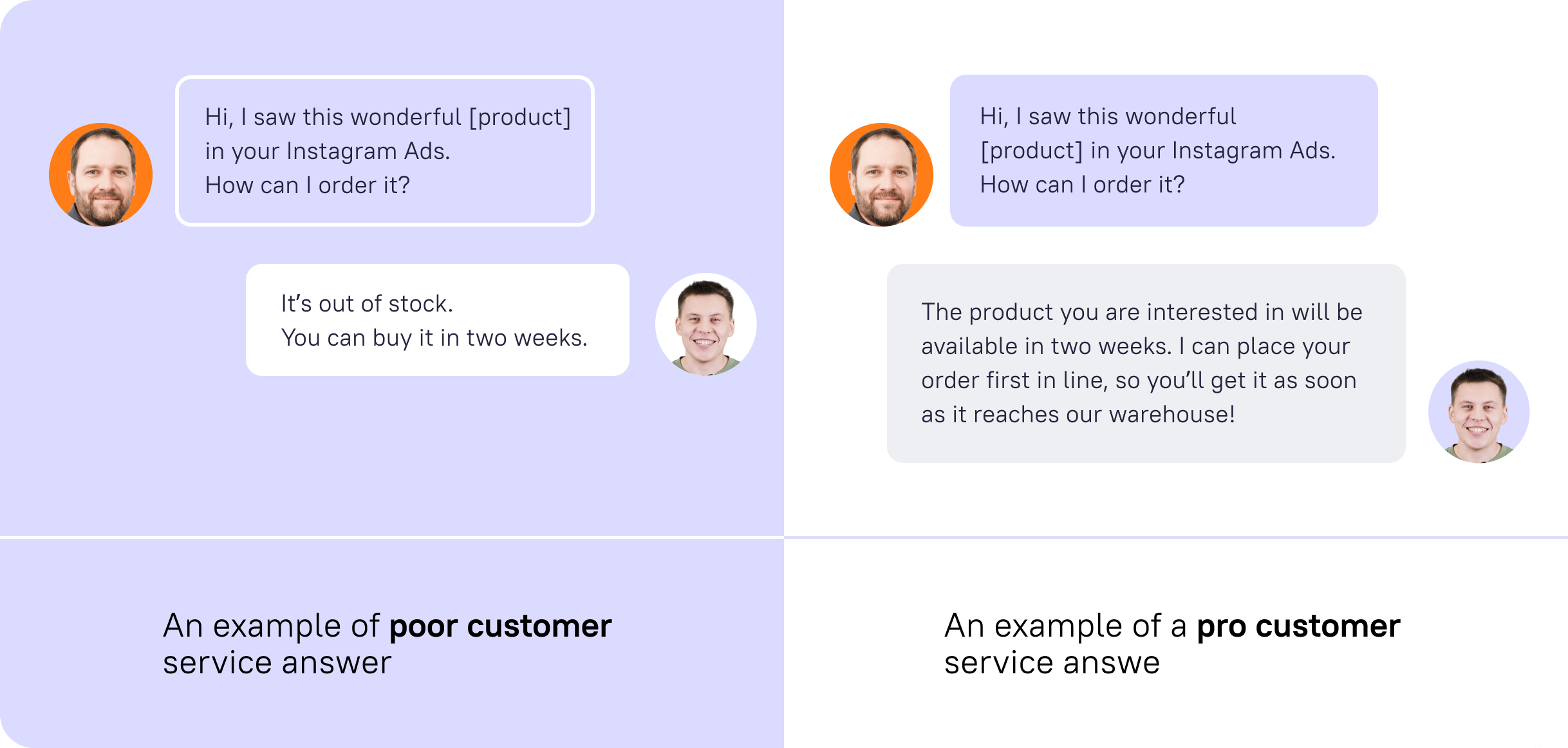
The following customer asked Kevin about a particular product. That isn’t a big thing, but…
Customer request example:
Hi, I saw this excellent [product] in your Instagram Ads. How can I order it?
Going to grant the request and close the deal, but he found it’s unavailable. There is still a chance to save the customer interest in saying when it will be in supply.
An example of a poor answer
It’s out of stock. You can buy it in two weeks
But usually, they don’t do that. At the end of this scenario, potential customers go to the next tab where the competitors’ website is already open.
An example of a pro answer
‘The item you are interested in will be available in two weeks. I can place your order first in line, so you’ll get it as soon as it reaches our warehouse! ’
Thus, you don’t ruin customers’ expectations but just postpone their realization. The tandem of positive connotation and VIP customer treatment does its job. Do you see the difference? Choosing the second scenario, Kevin provided a company with a new customer.
- Focus on positive things, offer the solution, say when the item will be available.
- Avoid negative language like ‘I can’t…’, ‘We don’t do that’.
Customer request 3. ‘Your call is transferred’
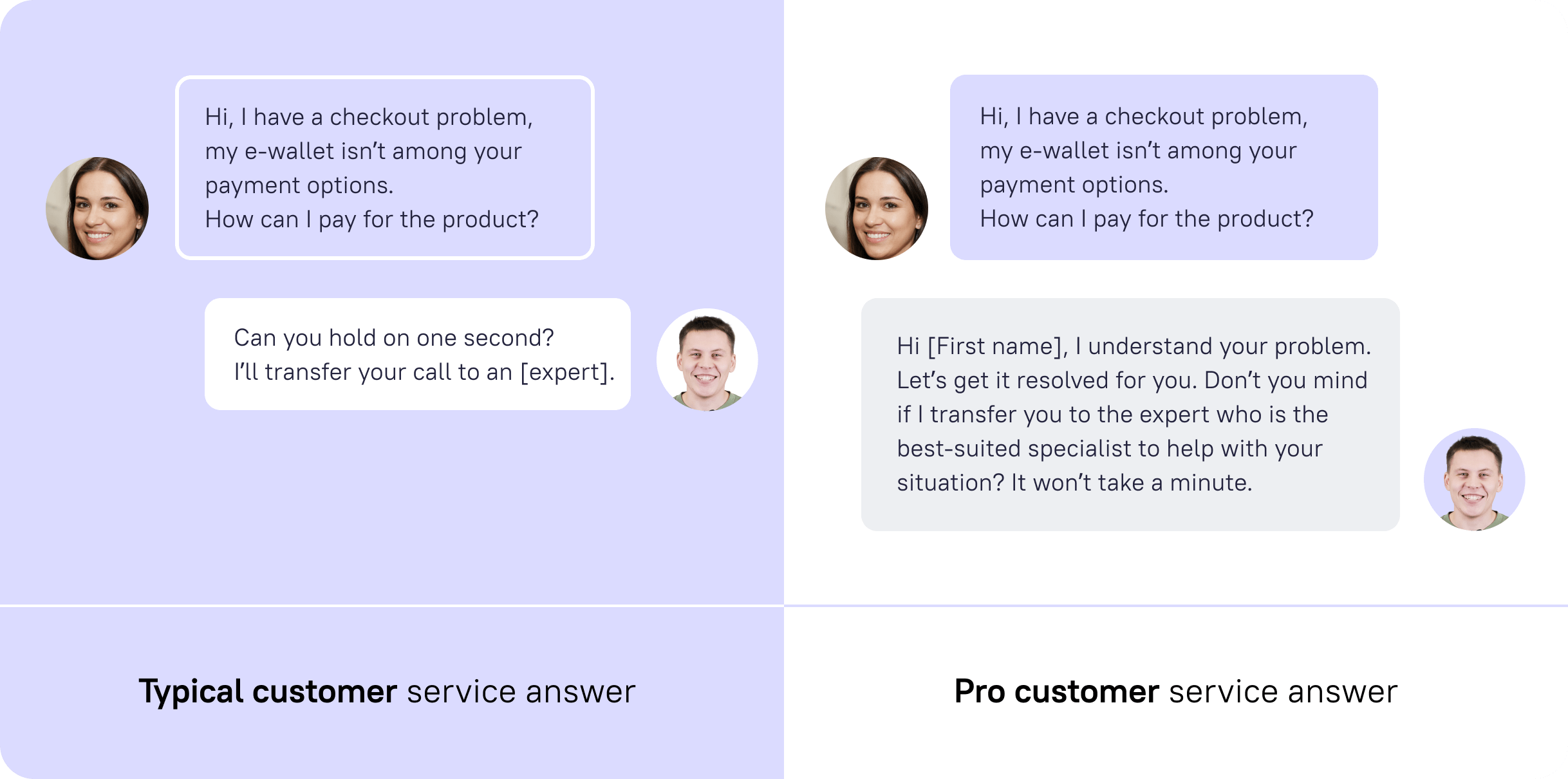
Forced meditation — here is how Kevin calls the time that customer is waiting for the transfer to the other manager. He doesn’t like to leave the potential customer with the vague ‘Hold on while I transfer you, please.’ But we are not Wikipedia to know everything. At least for now? Even if the customers’ question is way below his specialization, Kevin tries to provide them with the transfer details and prevent scenarios where:
- Customer hangs up
- Customer killing the expert/manager
So he did this time.
‘Hi, I have a checkout issue, my e-wallet isn’t among your payment options. How can I pay for the product? ’
An example of a typical answer:
Can you hold on for one second? I’ll transfer your call to an [expert].
That usually means that the manager is glad to hear from you. He has got your problem. Trying to save your time, he has found an expert who will do it better and faster. Unfortunately, consumers can’t read minds. They expect to get a response immediately. But… This phrase lacks the certainty that a manager has the customer’s problem in mind.
An example of a pro answer:
Hi [First name], I understand your problem. Let’s get it resolved for you. Don’t you mind if I transfer you to the expert who is the best-suited specialist to help with your situation? It won’t take a minute.
Sounds much better. Isn’t it? The expert is safe, and the customer is happy. Mission complete.
Tips to keep in mind:
- Explain the reasons for the call transfer
- Focus on the customer. Use more ‘you’ sentences and less ‘we/I’.
Scale your customer service with the power of generative AI, paired with your knowledge base and scripts. Sign up to see how this technology saves your agents time and increases customer loyalty
Customer request 4: The question you can’t answer
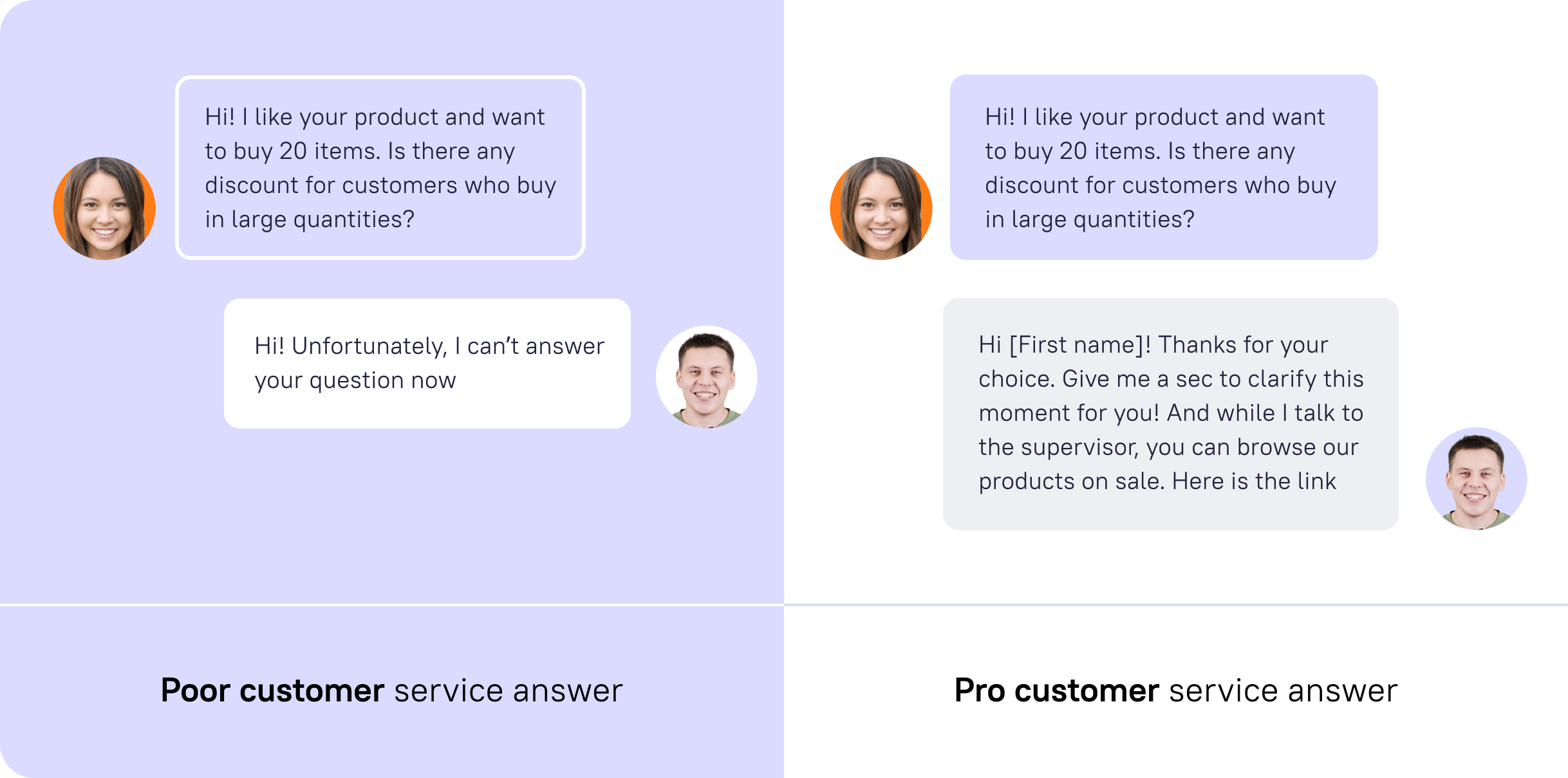
‘ I don’t know’ — the Phrase-That-Must-Not-Be-Said in your service. But Kevin really didn’t know how to resolve the customer’s question:
Hi! I like your brand and want to buy 20 items. Is there any discount for customers who buy in large quantities?
Yes, we are only humans: there may be a newcomer to the team, a poor announced update, etc. But customers don’t care. They need an answer. So, Kevin needed to do a little research. But first, he should respond.
An example of poor response (live chat or social media):
Hi! Unfortunately, I can’t process your question now.
A simple ‘ Can I call you back? ’ and more details could improve that scenario.
An example of a pro response (live chat):
Hi [First name]! Thanks for your choice. Give me a sec to clarify this moment for you! And while I talk to the supervisor, you can browse our products on sale. Here is the link
This shows that you understand the customers’ questions and will do whatever it takes to find out for them.
- Assure consumers you will get back to them with an answer.
- Before customers go elsewhere, recommend an alternative solution.
Customer request 5: ‘Why is your tool the best alternative? ’
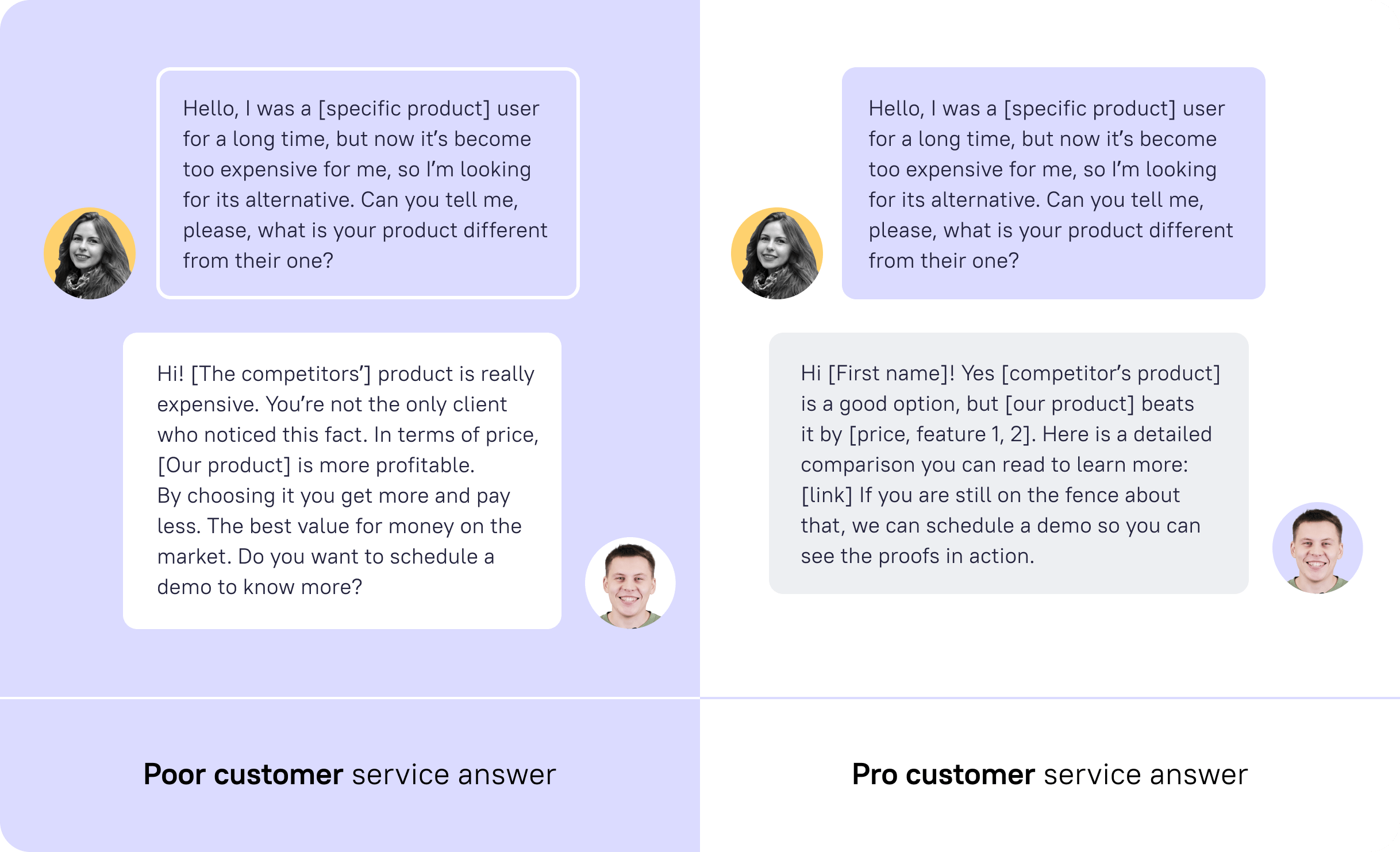
95% of all companies do not know what their competitive advantages are.
So how can customer service respond to this scenario? Empty phrases like ‘we have an excellent team’ don’t work here. Only proofs matter.
Hello, I was a [specific product] user for a long time, but now it’s become too expensive, so I’m looking for an alternative. Can you please tell me how your tool is different from theirs?
When a company hasn’t delivered this info to the team, managers may draw their conclusions (sometimes wrong) or use vague phrases and clichés to respond to this question. Like this one.
An example of poor answer:
Hi! [The competitors’] is really expensive. You’re not the only person who noticed this fact. In terms of price, [Our product] is more profitable. By choosing it, you get more and pay less. The best value for money on the market. Do you want to schedule a demo to know more?
Good thing Kevin was equipped with a relevant article explaining the difference. Moreover, he knew the competitors’ weak points and the business product.
Hi [First name]! Yes [competitor’s product] is a good option, but [our product] beats it by [price, feature 1, 2]. Here is a detailed comparison you can read for more: [link] If you are still on the fence about that, we can schedule a demo to see the proofs in action.
- Respect your competitors. Saying anything about them, you talk about the choice of your potential customer in this case. The comparison should be objective.
- Provide proof: facts, numbers. For example, instead of ‘[our product] is cheaper,’ use ‘Using [competitor’s product] for a month, you’ll pay only $$ while we offer wider functionality for half of this price. I mean, for $ you’ll get …’
- Ensure your agents get the results of the competitors’ reviews and know the advantages.
- Write an article comparing your solution with competitors. Choose the main one and write different comparisons with each of them. Then share it on demand.
Reduce your team’s workload and free your agents to address high-value tasks and complex customer issues with Dashly AI chatbot
Customer request 6: When a support manager has to say NO
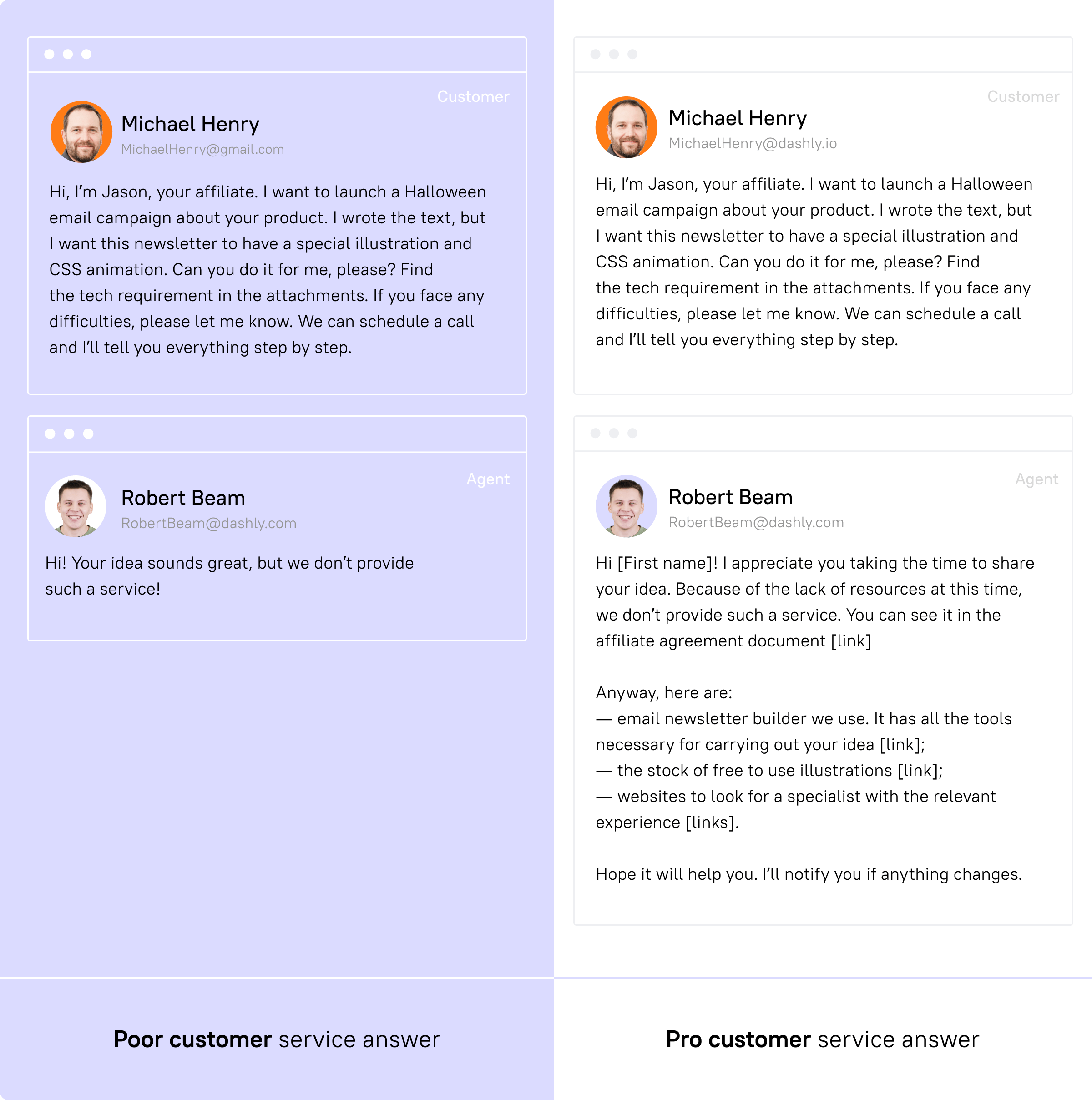
Do you know that awkward feeling when refusing somebody’s request? The same one felt Kevin talking to the loyal customer and affiliate who was asking for the s ervice the company doesn’t offer.
Customer request example:
Hi, I’m Jason, your affiliate. I want to launch a Halloween email campaign about your product. I wrote the text, but I want this newsletter to have a unique illustration and CSS animation. Can you do it for me, please? Find the tech requirement in the attachments. If you face any difficulties, please let me know. We can schedule a call, and I’ll tell you everything step by step.
But there is no such option. Kevin knew this man spent much time working on the idea and tech requirements, so he probably won’t be happy to know that. So, how to say NO and don’t lose the customer/affiliate?
An example of a poor answer:
Hi! Your idea sounds great, but we don’t provide such a service!
At the end of the dialog and disappointed the client. Can it be different? Yes.
‘Hi [First name]! I appreciate you taking the time to share your idea. Because of the lack of resources at this time, we don’t provide such a service. You can see it in the affiliate agreement document [link]. Anyway, here are: – Email newsletter builder we use. It has all the tools necessary for carrying out your idea [link] – The stock of free-to-use illustrations [link] – Websites to look for a specialist with relevant experience [links] Hope it will help you. I’ll notify you if anything changes.’
Of course, this isn’t the result that an affiliate is expected to get. But still, Kevin smoothed things over by offering an alternative solution.
- Don’t give a false hope
- Ask why when it isn’t clear
- Explain why not
- Express an empathy
Since you are in the middle of the article, it’s by far the last difficult customer example Kevin had to deal with.
Thanks! Your map with ready-made campaigns is already in your inbox

Customer request 7: Customer asks you to violate the company’s rules
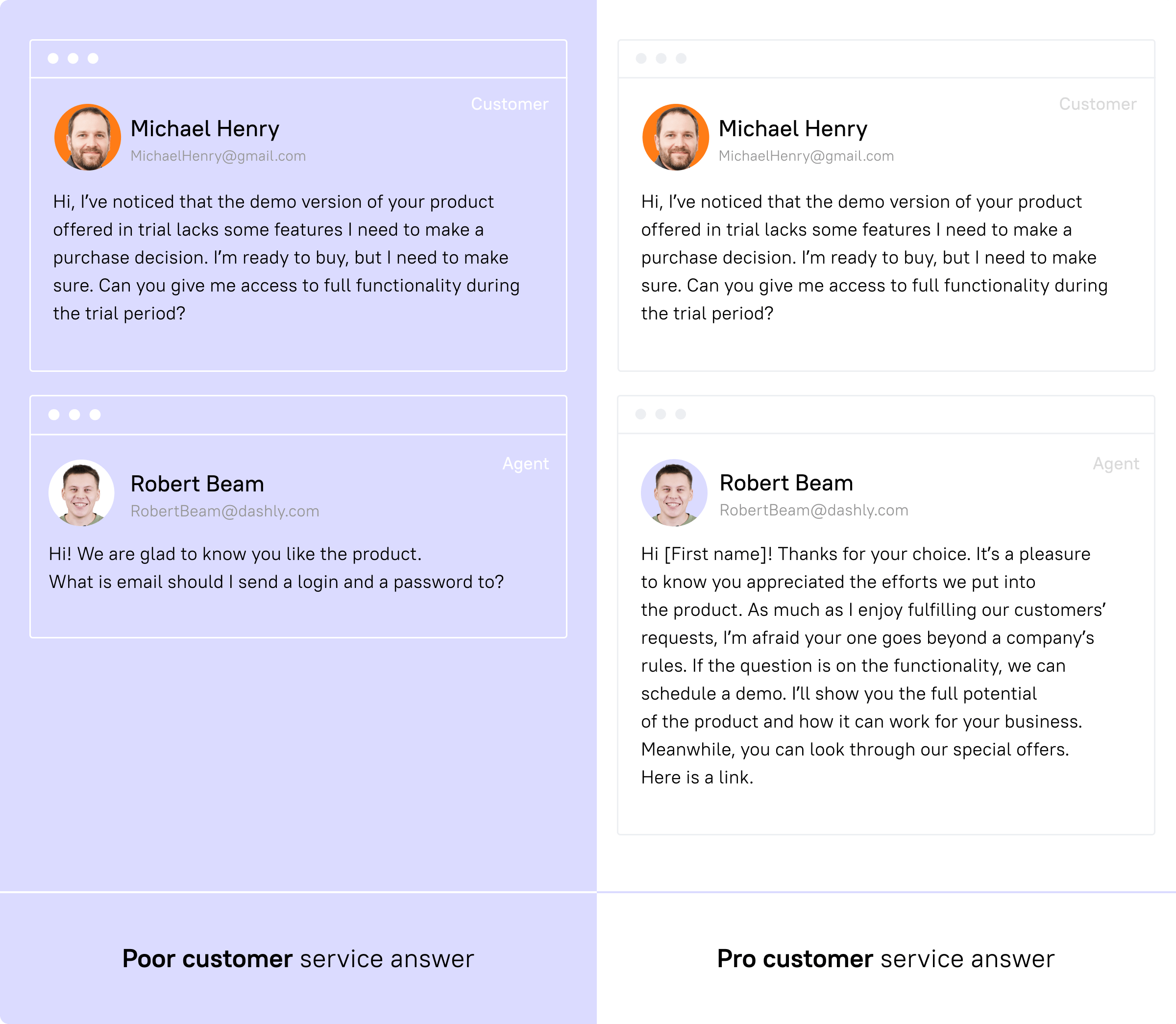
This time it’s a NO reply situation again. The only difference is a request. It was one of those customers who used to get ‘ an extra slice of a pickle ‘ for free. There is nothing terrible about filling a small request to please your customer. But what if it goes against the company rules?
Hi, I’ve noticed that the demo version lacks some features I need to make a purchase decision. I’m ready to buy, but I need to make sure. Can you give me access to full functionality during the trial period?
Nice try. But the pricing is clear about the trial version features. No exceptions. But this deal promised to be pretty big.
An example of a poor answer:
Hi! We are glad to know you like the product. What email should I send a login and a password to?
Sounds good, except for the part that violates your business rules.
Hi [First name]! Thanks for your choice. It’s a pleasure to know you appreciated our efforts on the product. As much as I enjoy fulfilling our customers’ requests, I’m afraid your one goes beyond a company’s rules. If the question is about the functionality, we can schedule a demo. I’ll show you the full potential of our solution and how it can work for your business. Meanwhile, you can look through our special offers. Here is a link.
Even if you have to respond negatively, the customer should be offered alternative solutions.
Tips to keep in mind when implementing customer service scenarios examples :
- Explain why not
- Make sure everyone knows a business Privacy Policy
That is the scenario you can control. But what would you do if someone had already done the illegal action?
Customer request 8: Account breaches company’s terms of use
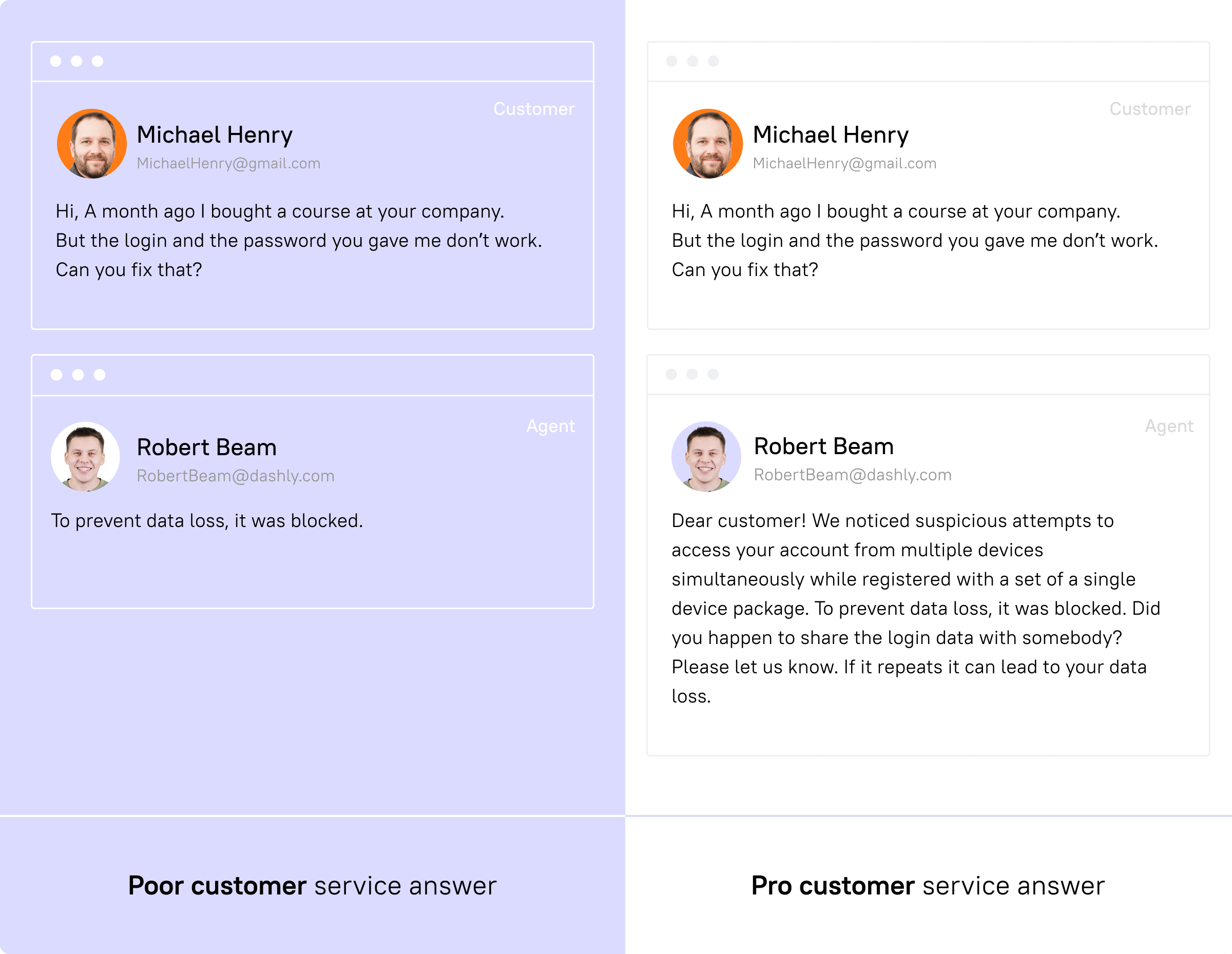
We like to judge. But nobody wants to be an executioner. Neither did Kevin. And he wasn’t. Even when the situation implied that.
Like when a customer purchases a course. The terms of use were clear a customer can’t share the content or the login data with others. Anyway, there were efforts to log in to the system under the same ID from multiple IP addresses and devices simultaneously. Since the customer can’t be in several countries simultaneously, his account was blocked. Not an hour passed like the owner noticed that.
Hi, A month ago I bought a course at your company. But the login and the password you gave me don’t work. Can you fix that?
Kevin was the one who had to clear things up.
An example of a poor message:
Hi! To prevent data loss, it was blocked.
Clear and understandable. But there’s no attempt to help, no empathy. It can be not a deliberate violation but a mistake. Remember about the presumption of innocence ☝️
An example of a pro message:
Dear customer! We noticed suspicious attempts to access your account from multiple devices simultaneously while registered with a set of a single device package. To prevent data loss, it was blocked. Did you happen to share the login data with somebody? Please let us know. If it repeats, it can lead to your data loss.
Sounds better, isn’t it? A detailed explanation of the situation and possible consequences. And notice, no threats.
- Determine the customer needs and try to fulfill them
- No blames without proof
Build better customers service and alleviate your agents’ workload with Dashly AI
Customer situation 9: It was your fault
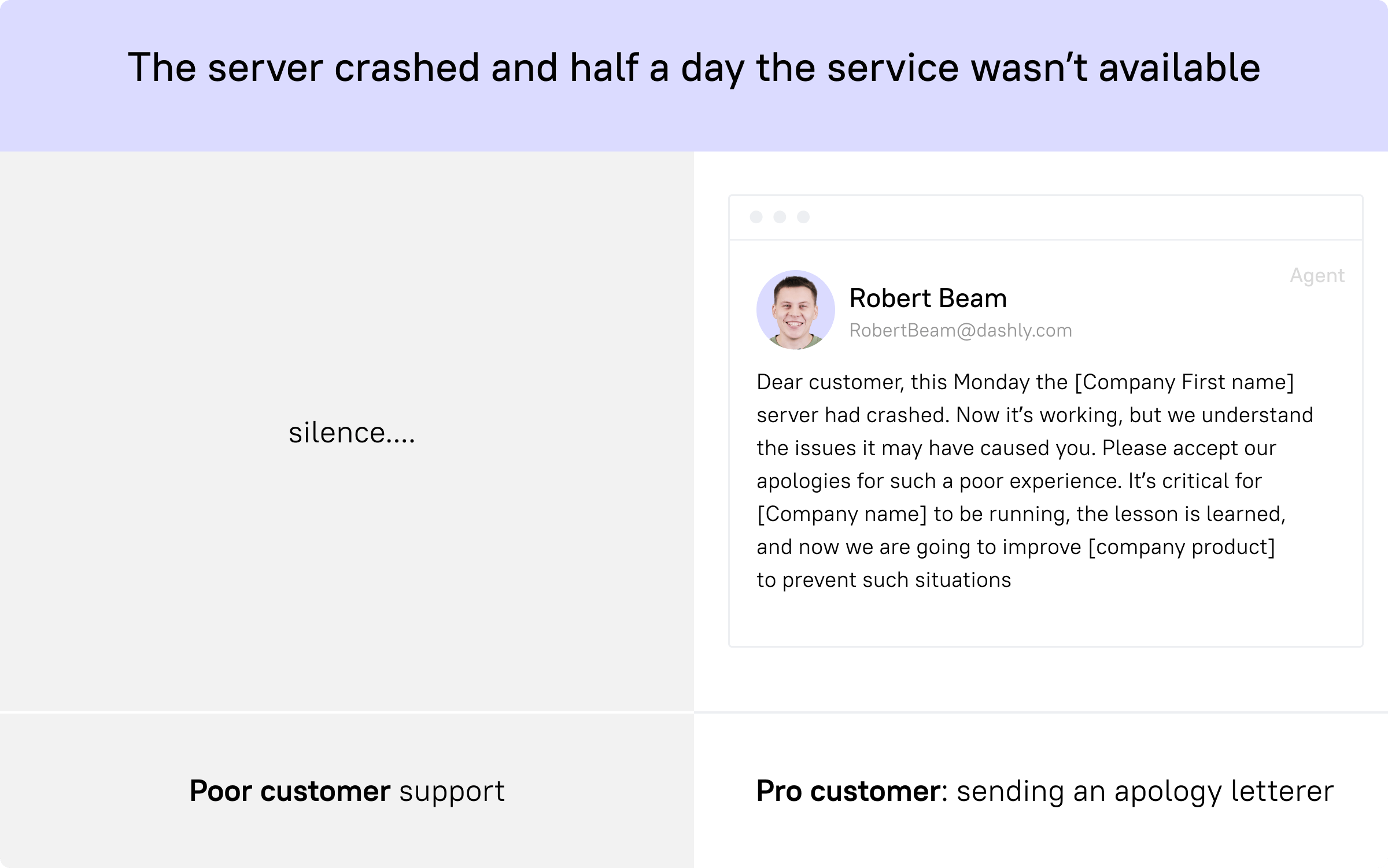
Talking with a previous customer was difficult, but who knew it could be worse? The server crashed, and for half a day, service wasn’t available. Guess who had to explain this to the customers? Everyone on the team, including Kevin, of course. Because of the specificity of the business, this caused many troubles for the customers. They deserve to be notified about the issue, at least. Better yet, an excuse.
An example of poor customer service:
Sticking the heads in the sand, hoping that nobody would notice.
Dear customer, this Monday the [Company First name] server crashed. Now it’s working, but we understand the issues it may have caused you. Please accept our apologies for such a poor experience. It’s critical for [Company name] to be running, the lesson is learned, and now we will improve [company product] to prevent such situations.
Nothing special, but instead of angry customers tickets, Kevin replied, ‘Thanks, it’s all right. You’re cool’ messages.
Customer service scenarios and answers tips to keep in mind:
- Own up to your mistakes
- Explain the plan
- Notify when it’ll be implemented
But nothing lasts forever, especially the good one. The next day Kevin received a ‘ Can I speak to your manager? ‘ message. And that wasn’t another meme in the company chat.
Customer request 10: Release The Kraken Manager
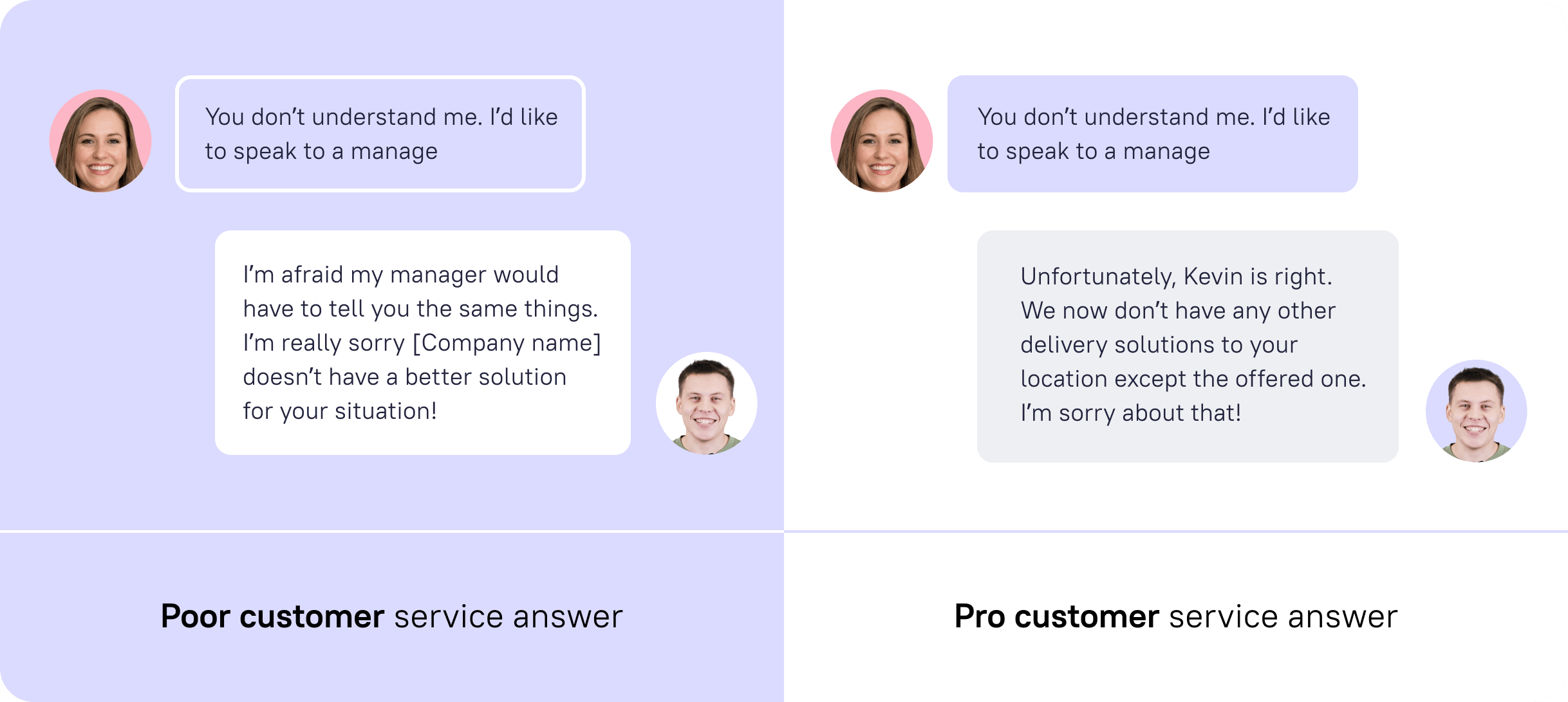
It was the 15th minute of Kevin explaining to an angry customer the delivery rules. The last one asked the same questions in different forms, but the client’s response was the same. Things got hairy. Polite attempts to help, arguments, and offered alternatives didn’t matter.
‘You don’t understand me. I’d like to speak to a manager’
But it was a kind of overattentive customer who didn’t want to accept the answer he didn’t like. Anyway, the company couldn’t fulfill the customer’s request.
An example of a client’s response:
‘I’m afraid my manager must tell you the same things. I’m really sorry [Company name] doesn’t have a better solution for your situation! ’
It’s enough to convince a customer, except for the angry scenario. Since Kevin was 100% sure in the info he operated, he just handed off the conversation to another manager who said the same in different words:
‘Unfortunately, Kevin is right. We now don’t have any other delivery solutions to your location except the offered one. I’m sorry about that! ’
If you’re not as sure as Kevin, ask for a supervisor.
- Show empathy
- Speak with kind authority
Reduce escalations to the support team with Dashly AI chatbot. It will easily answer FAQs about delivery or payment based on your scripts or knowledge base info and rote difficult requests to relevant experts on autopilot
Customer request 11: The price is too high
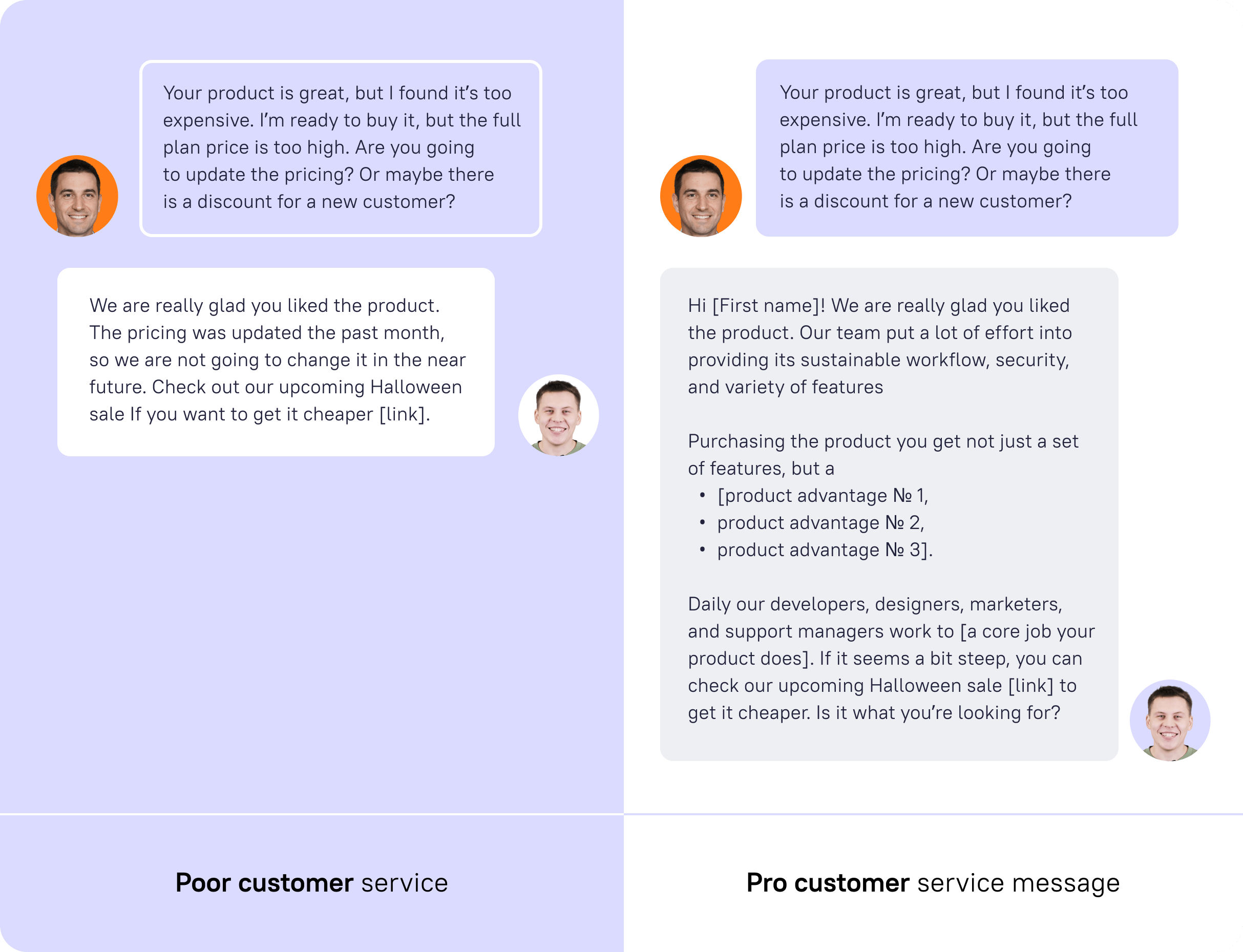
There will always be someone who doesn’t like you, your job, product, much less its price. The true art of customer service is convincing them to purchase. That was Kevin’s next achievement.
Customer’s request example:
Hi! Your solution is excellent, but I found it’s too expensive. I’m ready to buy it, but the full plan price is too high. Are you going to update the pricing? Or maybe there is a discount for a new customer?
The task was clear. This scenario assumed Kevin explaining the value it can bring to the customers. What do they pay for: elements of the chosen plan, tool advantages?
An example of poor service response:
Hi! We are happy you liked the product. The pricing was updated last month, so we are not going to change it in the near future. Check out our upcoming Halloween sale If you want to get it cheaper [link].
The offered solution seems quite fair: Wanna discount ─ wait for the sale. But it doesn’t solve the reason for the request ─ a lack of value understanding .
An example of a pro service agent message:
Hi [First name]! We are happy you liked it. My colleague put much effort into providing its sustainable workflow, security, and various features. By purchasing the service, you get not just a set of features but a [advantage №1, advantage №2, advantage №3]. Daily our developers, designers, marketers, and support managers work to [a core job your tool does]. If it seems steep, you can check our upcoming Halloween sale [link] to get it cheaper. Is it what you’re looking for?
It will help customers understand your product’s value and price.

Customer situation 12: The refund request
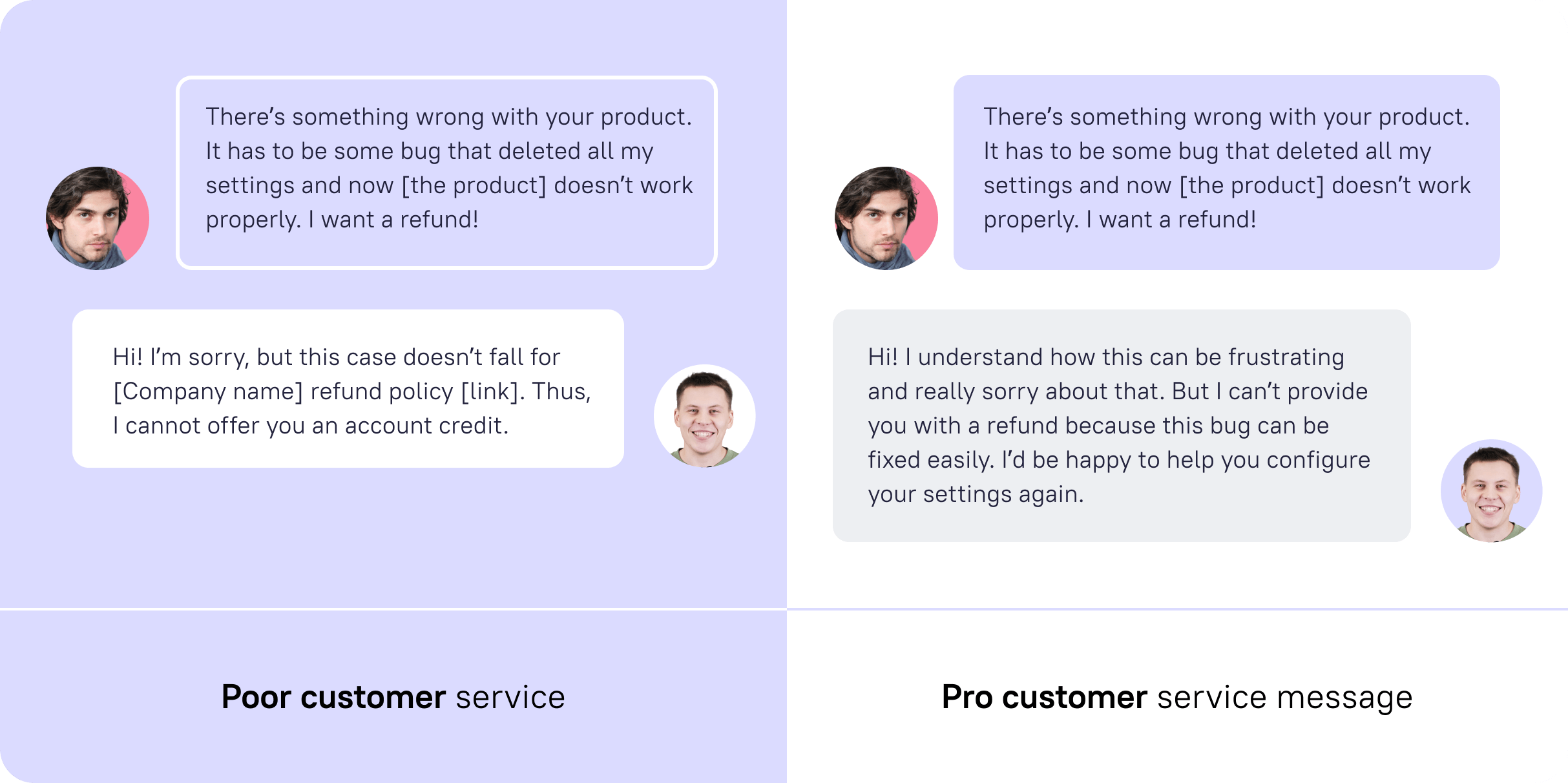
The rest of the week promised to be easy… but not for Kevin. This time he had to deal with a customer asking for his money back. Usually, it’s a relatively easy task, except when you can’t provide a refund.
There’s something wrong with your product. Some bug must have deleted all my settings and now [the product] doesn’t work properly. I want a refund!
Even if the tool settings were wrong, it still worked. So a refund wasn’t an option. That was written in the user agreement. Thus, Kevin had to find an alternative solution.
An example of poor service agent response:
Hi! I’m sorry, but this case doesn’t fall for [Company name] refund policy [link]. Thus, I cannot offer you an account credit.
An example of a pro service agent response:
H i! I understand how this can be frustrating and really sorry about that. But I can’t provide you a refund because this bug can be fixed easily. I’d be happy to help you configure your settings again.
This message doesn’t end on the refuse. A little empathy and desire to help do magic: there’s no customer aggression, no need for a refund.
- Consult the team
Here is how we do this when comparing Dashly with Intercom, Drift, LiveChat:
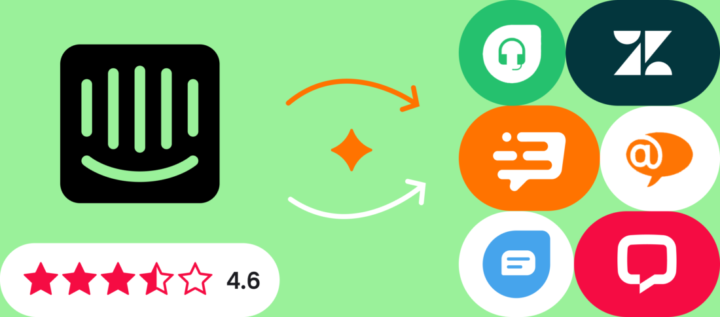
Client request 13: Shipping delay
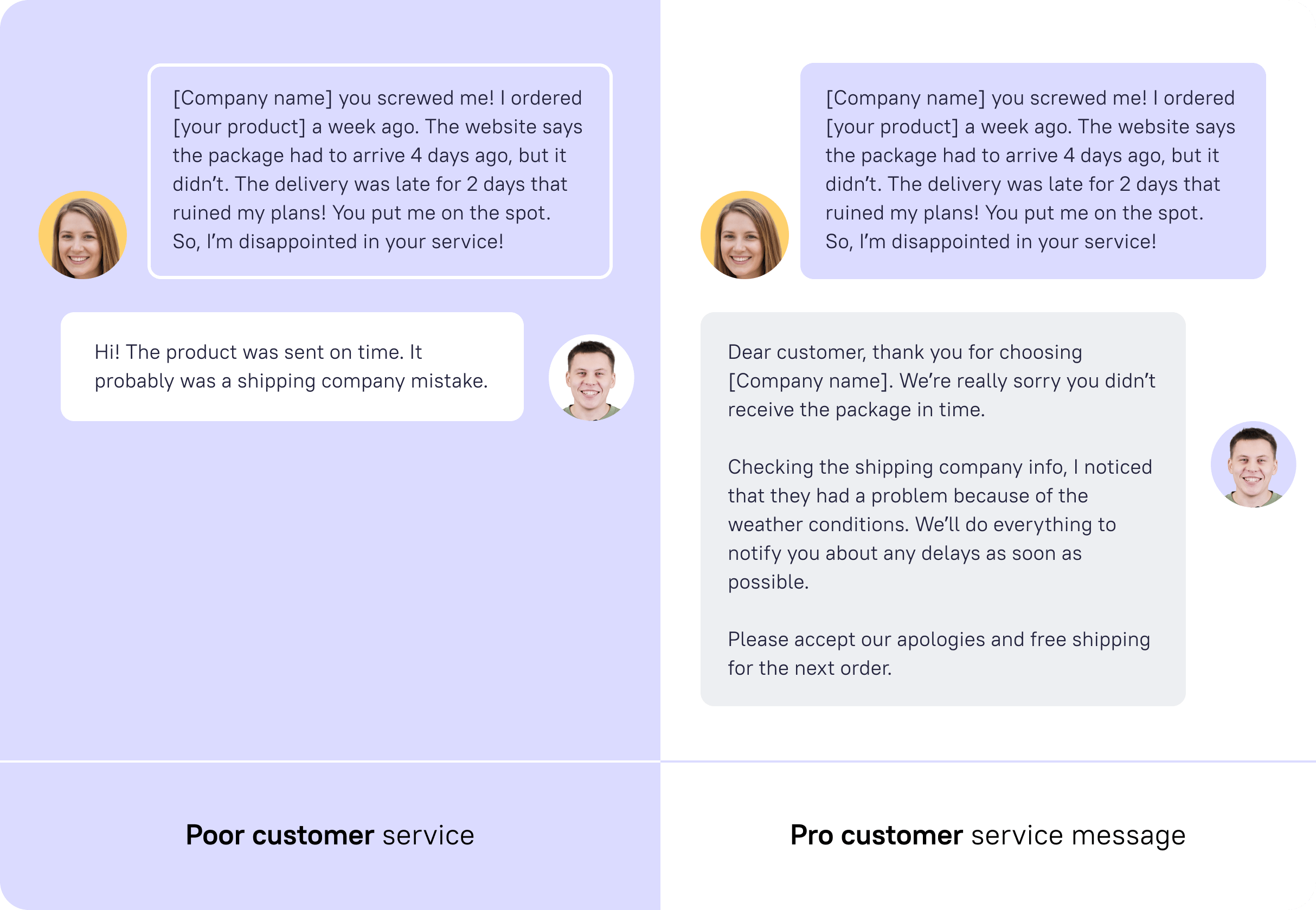
Minutes stench into hours, days — into years. Waiting for the ordered item can be torture. Unsurprisingly, even a day’s shipping delay makes people crazy. That’s why Kevin’s company is so careful about this process. But a quarantine made its amendments.
A customer ordered [a product] for his brother’s birthday. The website says about the three days shipping, which was perfect for preparing the gift for the celebration. But the package arrived two days later after the deadline. It hadn’t damaged the party, but the same cannot be said of the customer’s mood.
[Company name], you screwed me! I ordered [your product] a week ago. The website says the package had to arrive 4 days ago, but it didn’t. The delivery was late for two days which ruined my plans! You put me on the spot. So, I’m disappointed with your service!
How to make this customer happy?
Hi! The item was sent on time. It probably was a shipping company mistake.
That is true. But does it make this customer happy? That’s why Kevin chose another tactic…
Dear customer, thank you for choosing [Company name]. We’re really sorry you didn’t receive the package in time. Checking the shipping company info, I noticed they had a problem because of the weather conditions. We’ll do everything to notify you about any delays as soon as possible. Please accept our apologies and free shipping for the next order.
Sounds better, heh? It changes nothing but can provide a better customer experience.
- Explain what happened
- Tell how you are going to fix the situation
- Offer compensation
- End on a positive note
The customer is satisfied. The company image is saved. But what if the problem is on your side?
Client request 14: Quality issues
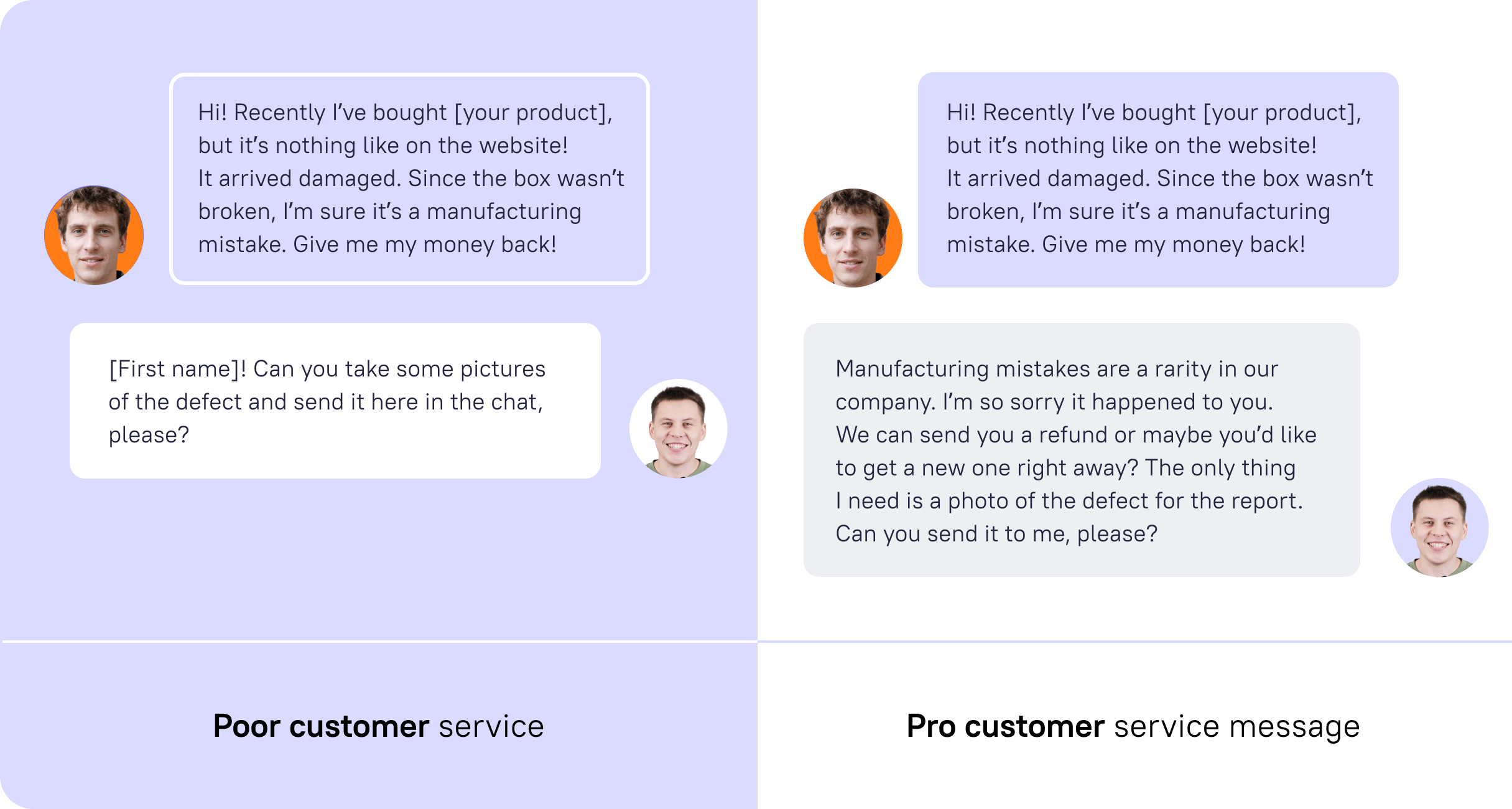
You may know this Expectation vs Reality frustration feeling. The website images tell about the perfect high-quality product, but it’s nothing like the one that had arrived. It’s the usual case in retail. But now it had happened to Kevin’s next customer.
Hi! Recently I’ve bought [your product], but it’s nothing like on the website! It arrived damaged. Since the box wasn’t broken, I’m sure it’s a manufacturing mistake. Give me my money back!
Seems like it’s your fault. Time to save the customer and the company’s image.
An example of poor agent response copy:
Hi [First name]! Can you take some pictures of the defect and send them here in the chat, please?
Asking for proof is ok, but not in the first sentence. This makes you feel like you don’t believe the customer.
If you wanna proof, argue it by a need for a report. Like Kevin did.
An example of a pro agent response:
Hi [First name]! Manufacturing mistakes are a rarity in our company. I’m so sorry it happened to you. We can send you a refund, or would you like to get a new one right away? The only thing I need is a photo of the defect for the report. Can you send it to me, please?
Thus, you apologize for the customer’s frustrating experience and offer an alternative solution.
But what if it was a customer who made a mistake? And this time, it really was so. Kevin checked the photos and noticed that [the product] was in use. So that wasn’t a manufacturing mistake, but a customer who ruined it.
Kevin had to use a ninja-like finesse to explain this to a customer.
An example of a poor response:
Checking the photos you sent, I noticed you’ve used [a product]. I’m afraid I can’t help you in this case.
I’m afraid the issue appears to stem from (the mistake customer made). If you look at the ‘terms of use’ brochure in the product’s set, you’ll find the directions on how to [do the thing the customer mistake in] right. Trust me. I’ve been there before! That thing can be tricky. But the only solution I can offer you, in this case, is 10% OFF for the following order. Let me know if you need my help.
This script demonstrates more empathy to a customer through the detailed ‘Why-Not’ explanation and proofs.
- If an item can be fixed, offer a solution
- Avoid blaming tone
- Teach them how to do/use [the things they did wrong] right
And now ‘the cream of the crop’ among complex scenarios: Brace yourself, the irate customers are coming.
The most difficult of service scenarios 15: Angry customer
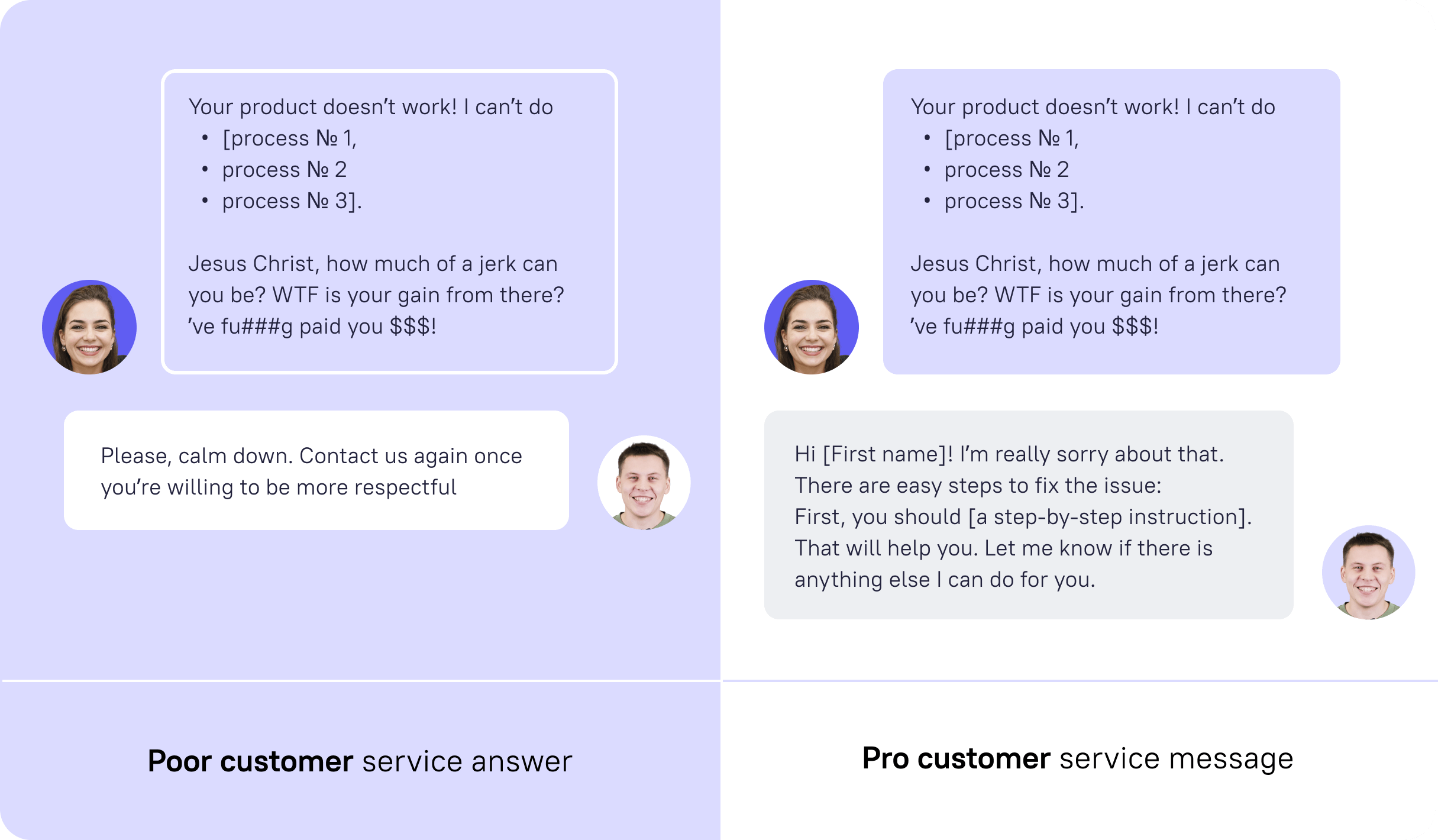
In nearly every problematic case I mentioned above was an irate customer. Dealing with each of them, Kevin was polite. But there is a line between anger and abuse.
Angry customer’s request example:
Your solution doesn’t work! I can’t do [process №1, process № 2, process №3]. Jesus Christ, how much of a jerk can you be? WTF is your gain from there? I’ve fu###g paid you $$$!
An example of a poor customer service response:
‘Please, calm down. Contact us again once you’re willing to be more respectful.’ Operator disconnects.
Neither warning nor chances for the customer to excuse and explain the details.
An example of a pro customer service response:
Hi [First name]! I’m really sorry about that. There are easy steps to fix the issue: First, you should [a step-by-step instruction]. That will help you. Let me know if there is anything else I can do for you.
It’s another when anger is directed at a company or you personally without connection to an issue.
Abusive customer request example:
Go to hell! Your service is a piece of sh#t just like you!!!!
An example of a pro customer service message:
Hi [First name], we are really sorry to hear about your frustration! Let us know if there is anything we can do to make you feel better.
If it doesn’t work:
I’m really willing to listen to your issue and solve it. But if you continue using such aggressive language, I’ll end this conversation.
That was the most difficult customer Kevin dialed with this week. I think you’ll agree, he deserved rest. Moreover, I’d say he deserved an extra day off.
- Show that you understand the customer’s situation
- Ask for the details to cool down the customer
Save your agents time and mental health with Dashly AI chatbot. It can be a first line of qualifying angry client request and then route them to the relevant agent
There’s not just a story about a terrible week. It’s a great experience you can use for role-playing scenarios to improve your customer service . Since angry customer scenarios are quite similar, you can quickly adapt these customer service examples and use them in retail, pharmacy, healthcare, etc.
Customer service agents like Kevin are modern knights. They help struggling customers and defend the honor (image) of a company. Pre-made scripts based on popular customer service scenarios are their weapon and assistant to refer to in uncertain situations. Customer service scenarios’ role-play is their regular training to deal with dragons angry customers.
Optimize the work of your customer support with Dashly AI Sign up for a free Dashly trial to implement these customer service scenarios immediately. Use them as a base to learn an AI chatbot on how to answer FAQs or store the script examples in the ‘Saved Replies’ section to dramatically reduce customer service response time.
FAQ on customer service scenarios
At Dashly, when we face customer service scenario questions, we don’t just wing it—we use these gems to train our agents and our nifty AI chatbot. We learn from the toughest bad customer service scenarios to ensure top-notch experiences. Our chatbot can already nail those simple Qs like a boss. Want to see an example? Swing by our article for a sneak peek at how we do it.
Customer service scenarios are like real-world simulations that our team uses to flex their problem-solving muscles. Picture customer service role play scenarios where agents and our AI chatbot practice their Jedi-like support skills. These drills are key—by running through these tailored customer service scenarios, we save our managers time and level up support, equipping both human agents and bots to handle the curveballs customers throw our way with ease and grace.
Our approach to customer service training is dynamic and data-driven, rooted in real-life customer service training scenarios. We leverage our knowledge base to clue in agents and our AI chatbot on navigating scenarios for customer service, specifically honing in on challenging customer service scenarios like refund issues or delivery slowdowns. When new situations arise—maybe a conflict that wasn’t in the script—we update our chatbot immediately, ensuring it’s prepped to handle any scenario thrown its way with flawless accuracy.
An example of customer service scenarios for role plays could be simulating a dissatisfied customer reporting a product defect, with one person acting as the customer and the other as the service rep, navigating through resolution steps. Find more examples in this article.
A customer service scenarios worksheet is essentially a detailed guide often presented as a PDF document. It’s packed with pre-written conversations that outline various tough customer service situations and the best responses to them. For instance, the PDF might offer a step-by-step script for dealing with a heated product return dispute, guiding the service rep through calming the customer, addressing their concerns, and offering a viable solution. Always looking to sharpen your service skills? Our article has these worksheets ready for download, giving you the exact wording you’ll need to smoothly navigate challenging customer interactions.

Subscribe to Dashly newsletter
Join the community of 13,000 pros who get expert insights on marketing, support, and sales in a weekly newsletter

30 Customer Service Assistant Interview Questions and Answers
Common Customer Service Assistant interview questions, how to answer them, and example answers from a certified career coach.

In a world where the customer experience can make or break a business, having exceptional Customer Service Assistants on board is more important than ever. As you prepare for your upcoming interview, it’s essential to understand that potential employers are not only looking for candidates with strong communication skills but also those who display empathy, problem-solving abilities, and an unwavering commitment to helping customers.
In this article, we will delve into some of the most common questions asked during Customer Service Assistant interviews, along with tips and sample answers to help you present yourself as the ideal candidate and secure that much-desired position.
1. What do you believe is the most important aspect of customer service?
The heart of customer service lies in understanding the needs and expectations of customers. When interviewers ask this question, they want to know if you can identify and prioritize the key elements that contribute to a positive customer experience. Your answer should reflect your ability to empathize with customers, actively listen to their concerns, and promptly find solutions—all while maintaining a professional and friendly demeanor.
Example: “I believe the most important aspect of customer service is empathy. Being able to put yourself in the customer’s shoes and genuinely understand their concerns or frustrations allows you to provide tailored solutions that meet their needs. Empathy helps build trust between the customer and the company, which ultimately leads to a positive experience for both parties.
Active listening also plays a significant role in delivering exceptional customer service. It ensures that we fully comprehend the customer’s issue and can address it effectively without making assumptions. Combining empathy with active listening enables us to create meaningful connections with customers and leave them feeling valued and satisfied with our support.”
2. Can you provide an example of a time when you went above and beyond for a customer?
The essence of exceptional customer service lies in the willingness to go the extra mile for the customer. By asking this question, interviewers want to gauge your dedication, creativity, and ability to take initiative in making a customer’s experience extraordinary. Your response will showcase your problem-solving skills and your commitment to satisfying customers, which are essential qualities for a customer service assistant.
Example: “Certainly! I recall an instance when I was working as a Customer Service Assistant at a retail store. A customer approached me, looking for a specific item that we had unfortunately run out of stock. The customer mentioned it was a gift for their spouse’s birthday and they were unable to find it anywhere else.
Instead of simply apologizing and suggesting they try another store, I took the initiative to check our inventory system for other nearby locations. I found that one of our sister stores had the item in stock. I called the store to confirm its availability and asked them to reserve it for the customer. Then, I provided the customer with directions to the store and even offered to call ahead so the staff there would be expecting them.
The customer was extremely grateful for my efforts and left our store with a smile on their face. This experience reinforced the importance of going above and beyond to ensure customer satisfaction and create positive experiences that reflect well on the company.”
3. How would you handle a situation where a customer is unhappy with their purchase or experience?
Empathy and problem-solving abilities are key qualities of a great customer service assistant. Interviewers want to know if you can put yourself in the customer’s shoes, understand their concerns, and find a resolution that satisfies both the customer and the company. Handling unhappy customers is a significant part of the job, and your ability to navigate these situations is a strong indicator of your potential success in the role.
Example: “When faced with an unhappy customer, my first priority is to actively listen and empathize with their concerns. I would let the customer express their frustrations without interrupting them, as this helps them feel heard and understood. Once they’ve shared their experience, I would apologize for any inconvenience or dissatisfaction they have encountered.
After understanding the issue, I would take appropriate action to resolve it promptly. This could involve offering a refund, replacement, or alternative solution based on the company’s policies and the specific situation. Throughout the process, I would maintain open communication with the customer, ensuring they are informed of any updates and that their needs are being addressed. Ultimately, my goal is to turn a negative experience into a positive one by demonstrating genuine care and commitment to resolving their concerns.”
4. Describe your experience using customer relationship management (CRM) software.
Familiarity with CRM software is an essential requirement for many customer service roles. By asking this question, interviewers want to gauge your level of experience and proficiency with these tools. They want to know if you can effectively use CRM systems to track customer interactions, manage data, and streamline communication to better serve customers and improve the overall customer experience.
Example: “During my previous role as a customer service representative, I gained extensive experience using CRM software, specifically Salesforce. My daily tasks involved logging customer interactions, tracking their inquiries and concerns, and updating their contact information. This allowed me to maintain an organized record of each customer’s history with the company, which was essential for providing personalized support.
Furthermore, I utilized the CRM system to schedule follow-up calls or emails, ensuring that customers received timely responses to their issues. The software also helped me identify trends in customer feedback, allowing our team to address recurring problems more effectively. In summary, my experience with CRM software has been invaluable in streamlining customer service processes and enhancing overall customer satisfaction.”
5. What strategies do you use to stay organized and manage multiple tasks at once?
In the dynamic world of customer service, it’s essential to keep track of numerous responsibilities and handle multiple tasks simultaneously. Interviewers ask this question to gauge your time management and organizational skills, as well as your ability to prioritize tasks and ensure that everything gets done efficiently and effectively. Demonstrating your strategies for staying organized and multitasking will help showcase your ability to excel in a fast-paced, customer-focused environment.
Example: “To stay organized and manage multiple tasks simultaneously, I rely on a combination of time management techniques and digital tools. First, I prioritize my tasks based on urgency and importance using the Eisenhower Matrix method. This helps me focus on high-priority tasks while ensuring that less urgent tasks are not neglected.
I also utilize digital tools like task management apps to create to-do lists and set reminders for deadlines. These tools help me keep track of my progress and ensure that nothing slips through the cracks. Additionally, I allocate specific time blocks during the day for different tasks, which allows me to maintain a structured workflow and avoid multitasking inefficiencies. This approach has consistently helped me stay organized and effectively manage multiple responsibilities in fast-paced customer service environments.”
6. How do you maintain a positive attitude when dealing with difficult customers?
A positive attitude is key to providing exceptional customer service, even when faced with challenging situations. Interviewers ask this question because they want to know how you manage your emotions, remain patient, and stay focused on providing a solution, all while ensuring the customer feels heard and respected. Your response demonstrates your ability to keep a level head, diffuse tense situations, and maintain professionalism under pressure.
Example: “Maintaining a positive attitude when dealing with difficult customers is essential in providing excellent customer service. To achieve this, I remind myself that the customer’s frustration is not directed at me personally but rather at the situation or issue they are facing. This perspective helps me stay empathetic and focused on finding a solution to their problem.
Another strategy I use is active listening, which involves giving my full attention to the customer, acknowledging their concerns, and asking clarifying questions if needed. This approach demonstrates respect for the customer and often diffuses tension, allowing us to work together towards resolving the issue. After each challenging interaction, I take a moment to reset mentally and refocus on the next customer, ensuring that I continue to provide exceptional service throughout my shift.”
7. Have you ever had to deal with an irate customer? If so, how did you handle it?
Customer service roles often involve managing challenging situations and emotions, and sometimes that includes dealing with irate customers. Employers want to know if you have the necessary skills to diffuse tension, empathize with the customer, and maintain a professional demeanor even in the face of frustration. Your ability to handle such situations can make a significant difference in customer retention and satisfaction.
Example: “Yes, I have encountered irate customers in my previous role as a customer service assistant. In one particular situation, a customer was extremely upset about receiving a damaged product. To handle the situation, I first allowed the customer to express their frustration and concerns without interrupting them. This helped them feel heard and acknowledged.
Once they had finished explaining the issue, I empathized with their situation by expressing my understanding of how disappointing it must be to receive a damaged item. Then, I calmly explained our company’s return policy and assured them that we would replace the damaged product at no additional cost. Throughout the conversation, I maintained a professional and respectful tone, which ultimately helped defuse the situation. The customer appreciated the prompt resolution and left satisfied with our response.”
8. What steps do you take to ensure that you fully understand a customer’s needs before offering assistance?
Empathy and active listening are key qualities for a customer service assistant. By asking this question, the interviewer wants to gauge your ability to put yourself in the customer’s shoes and truly understand their concerns. Your answer should demonstrate that you’re able to ask the right questions, listen attentively, and clarify any ambiguities before offering a solution, ensuring a more personalized and effective customer experience.
Example: “When interacting with a customer, my first priority is to actively listen and empathize with their situation. I allow them to fully explain their issue without interrupting, as this helps me gather all the necessary information while also making the customer feel heard and valued. During this process, I take notes on key points they mention to ensure that I don’t miss any important details.
Once the customer has finished explaining their needs, I ask clarifying questions to address any ambiguities or gaps in understanding. This step not only ensures that I have a comprehensive grasp of their concerns but also demonstrates to the customer that I am genuinely interested in helping them find the best solution. With a clear understanding of their needs, I can then confidently offer assistance tailored to their specific situation, ultimately leading to a more satisfying experience for both the customer and myself.”
9. In your opinion, what role does empathy play in providing excellent customer service?
Empathy is the key to understanding and connecting with customers on an emotional level. When you’re able to put yourself in their shoes, you can better anticipate their needs, address their concerns, and create a positive experience for them. Interviewers want to know if you recognize the value of empathy in customer service and whether you can apply it effectively in your interactions with customers, ultimately leading to higher satisfaction and loyalty.
Example: “Empathy plays a vital role in providing excellent customer service, as it allows us to genuinely understand and connect with the customers’ feelings and needs. When we approach interactions with empathy, we can better identify the root cause of their concerns and offer tailored solutions that address their specific issues.
Moreover, empathetic communication helps build trust and rapport between the customer service assistant and the customer. This positive relationship not only leads to higher satisfaction levels but also fosters long-term loyalty towards the company. In essence, empathy is a key component in delivering exceptional customer experiences and maintaining strong customer relationships.”
10. Can you describe a time when you successfully resolved a customer complaint?
Customer satisfaction is the heart of a customer service role, and interviewers want to know that you have experience addressing and resolving customer issues in a positive manner. By asking about a specific instance, they hope to gain insight into your problem-solving skills, empathy, and ability to navigate challenging situations while maintaining a professional demeanor. Your response will demonstrate your ability to turn potentially negative situations into positive outcomes, which is essential in a customer service position.
Example: “Certainly, I recall an instance when a customer approached me with a complaint about a defective product they had purchased from our store. The customer was visibly upset and frustrated, as the item was meant to be a gift for their child’s birthday.
I began by empathizing with the customer and acknowledging their frustration. I assured them that we would find a solution together. After gathering all necessary information about the purchase, including the receipt and details of the defect, I quickly checked our inventory for a replacement. Fortunately, we had the same item in stock, so I offered to exchange it immediately. Additionally, I provided a small discount on their next purchase as a gesture of goodwill and apologized for any inconvenience caused.
The customer appreciated my prompt response and understanding attitude, which helped turn a negative experience into a positive one. They left the store satisfied with the resolution and even thanked me for my assistance. This situation reinforced the importance of active listening, empathy, and quick problem-solving skills in providing exceptional customer service.”
11. How do you handle situations where you need to enforce company policies that may not be popular with customers?
Enforcing company policies, especially those that might not be well-received by customers, is a delicate balancing act in customer service. Interviewers want to ensure that you not only understand the importance of adhering to these policies, but also have the ability to communicate them effectively and empathetically to customers—maintaining good relationships and minimizing any potential negative impact on the company’s reputation.
Example: “When enforcing company policies that may not be popular with customers, I always approach the situation with empathy and clear communication. First, I make sure to actively listen to the customer’s concerns and acknowledge their feelings. This helps build rapport and shows them that I genuinely care about their experience.
Once I have a good understanding of their issue, I calmly explain the relevant policy in a way that is easy for the customer to understand, emphasizing the reasons behind it and how it ultimately benefits all customers. If possible, I try to offer alternative solutions or compromises within the boundaries of the policy. In cases where there’s no room for flexibility, I remain firm but respectful, ensuring the customer knows that my priority is to provide fair and consistent service to everyone. This approach has helped me maintain positive relationships with customers while upholding company standards.”
12. Are you comfortable working in a fast-paced environment with high call volumes?
The question is designed to gauge your ability to handle the constant pressure and demands of a customer service role, especially in a busy setting. It’s important for employers to know that you can maintain your composure, multitask, and deliver excellent service even when faced with a high volume of calls and inquiries. Your adaptability and stress management skills are key factors they’re looking for in their ideal candidate.
Example: “Absolutely, I am comfortable working in a fast-paced environment with high call volumes. In my previous role as a customer service representative at a telecommunications company, we often experienced peak periods where the call volume was significantly higher than usual. During these times, I learned to manage my time efficiently and prioritize tasks effectively to ensure that each customer received prompt assistance.
I understand that maintaining composure and staying focused under pressure is essential for providing excellent customer service. To achieve this, I make sure to stay organized, listen attentively to customers’ concerns, and address their issues promptly while remaining patient and empathetic. This approach has allowed me to successfully handle high call volumes without compromising the quality of service provided to our customers.”
13. What methods do you use to build rapport with customers over the phone or via email?
Establishing rapport is essential to creating a positive customer experience and resolving issues effectively. By asking this question, interviewers want to gauge your ability to connect with customers in a genuine way, even through remote communication channels. Your answer will demonstrate your interpersonal skills and your commitment to making customers feel valued, supported, and understood.
Example: “Building rapport with customers over the phone or via email is essential for providing excellent customer service. When interacting over the phone, I focus on using a friendly and empathetic tone of voice to convey warmth and understanding. I also make sure to actively listen to their concerns, ask open-ended questions, and use their name throughout the conversation to create a personal connection.
For email communication, I pay close attention to my writing style, ensuring that it’s clear, concise, and professional while still maintaining a friendly tone. I address the customer by their name and personalize the message by referring to specific details they’ve shared. Additionally, I always proofread my emails before sending them to ensure there are no errors, as this demonstrates respect for the customer and helps maintain a positive impression of the company. These methods have proven effective in building rapport and fostering strong relationships with customers in my previous roles.”
14. How do you prioritize tasks when assisting multiple customers simultaneously?
The ability to efficiently prioritize and handle multiple customer requests at once is a key skill for any customer service assistant. Interviewers ask this question to gauge your multitasking abilities, time management skills, and how well you can maintain a high level of customer satisfaction. They want to ensure that you can provide prompt and effective assistance to all customers without compromising the quality of your service.
Example: “When assisting multiple customers simultaneously, I prioritize tasks based on the urgency of each customer’s needs and the complexity of their requests. First, I quickly assess the situation to determine which issues require immediate attention, such as time-sensitive inquiries or critical problems that could significantly impact the customer experience. I address these high-priority concerns first while ensuring that other customers are aware that I will attend to them shortly.
For less urgent matters, I efficiently manage my time by multitasking when appropriate, such as answering a simple question for one customer while waiting for information from another source to resolve a different issue. Throughout this process, I maintain clear communication with all customers, keeping them informed about the progress of their requests and setting realistic expectations for resolution times. This approach allows me to effectively balance the needs of multiple customers while providing exceptional service to each individual.”
15. Describe a time when you received constructive feedback from a supervisor. How did you respond?
This question highlights your ability to accept feedback and learn from it, which is crucial for personal and professional growth. Interviewers want to know how you handle criticism and if you’re able to take that feedback to improve your performance. Demonstrating the ability to learn from constructive criticism shows a level of maturity and adaptability that is valuable in any workplace, especially in customer service where you’ll regularly receive feedback to enhance your problem-solving and communication skills.
Example: “During my time as a customer service assistant at a retail store, I received constructive feedback from my supervisor regarding my approach to handling difficult customers. She observed that while I was generally patient and empathetic, there were instances where I could have been more proactive in offering solutions or escalating the issue to a manager when necessary.
I appreciated her insight and took it as an opportunity for growth. I asked her for specific examples of situations where I could have acted differently and requested additional guidance on how to better handle such scenarios. Over the next few weeks, I made a conscious effort to apply her suggestions in my interactions with customers. As a result, I noticed an improvement in my ability to resolve issues more efficiently and effectively, leading to increased customer satisfaction. This experience taught me the value of being open to feedback and using it as a tool for personal and professional development.”
16. What techniques do you use to remain calm under pressure?
Keeping composed during high-pressure situations is a key skill for any customer service professional. In the midst of handling multiple tasks, managing difficult customers, or addressing unexpected challenges, it’s important to maintain a level head. Interviewers ask this question to gauge your ability to handle stress and ensure that you can provide excellent service even when under pressure. They want to know that you have strategies in place to stay calm, focused, and professional during challenging moments.
Example: “To remain calm under pressure, I employ two main techniques: prioritization and mindfulness. When faced with multiple tasks or challenging situations, I first prioritize my responsibilities based on urgency and importance. This helps me focus on what needs to be addressed immediately while keeping the bigger picture in mind.
Mindfulness plays a significant role in maintaining composure during high-pressure moments. I practice deep breathing exercises and remind myself that it’s essential to stay present and focused on the task at hand. This approach allows me to maintain a clear head, make better decisions, and provide excellent customer service even when things get hectic.”
17. How do you keep up-to-date with changes in products, services, and company policies?
Staying current with new information is essential in a customer service role. As a customer service assistant, you are expected to have the most up-to-date knowledge about the company’s products, services, and policies. Employers want to know that you have a proactive approach to staying informed and are able to adapt to changes quickly, ensuring you can provide accurate and reliable information to customers when they need it most.
Example: “As a customer service assistant, it’s essential to stay informed about changes in products, services, and company policies to provide accurate information to customers. One way I keep up-to-date is by regularly attending team meetings and training sessions organized by the company. These gatherings often cover updates on new product launches, modifications to existing offerings, or policy adjustments.
Another method I use is actively engaging with internal communication channels, such as newsletters, emails, or intranet announcements. This helps me stay aware of any ongoing developments within the organization. Additionally, I maintain open lines of communication with my colleagues and supervisors, which allows us to share knowledge and clarify any uncertainties regarding changes. This proactive approach ensures that I am always well-informed and prepared to assist customers effectively.”
18. Can you provide an example of a time when you had to adapt to a new process or system quickly?
Adaptability is a key trait in customer service roles, as changes in policies or technologies are not uncommon in this field. Employers want to know that you can quickly and effectively adjust to new situations, learn new processes or systems, and continue to provide excellent customer support. Your ability to adapt demonstrates flexibility, a willingness to learn, and the ability to handle change in a fast-paced environment.
Example: “Certainly! In my previous role as a customer service assistant, our company decided to implement a new CRM system to streamline the process of managing customer interactions. The transition required us to learn and adapt quickly to ensure minimal disruption in our daily tasks.
I took the initiative to thoroughly study the new system’s features and functionalities by attending training sessions and reviewing available resources. I also practiced using the software during off-peak hours to familiarize myself with its interface and capabilities. This proactive approach allowed me to adapt swiftly to the new system, enabling me to continue providing efficient and effective support to our customers throughout the transition period. Additionally, my familiarity with the system made me a valuable resource for my colleagues who needed assistance or guidance during the initial stages of implementation.”
19. What measures do you take to protect customer privacy and confidentiality?
In today’s digital age, customer privacy and confidentiality are of utmost importance. Employers want to know that you are conscious of the responsibility you have when handling sensitive customer information. Demonstrating that you’re aware of the necessary steps to protect this data not only shows your dedication to customer service but also your commitment to your company’s overall reputation and success.
Example: “As a customer service assistant, I understand the importance of protecting customer privacy and confidentiality. To ensure this, I strictly adhere to company policies and guidelines regarding data protection and information sharing. When handling sensitive customer information, I make sure to access it only through secure systems and never discuss or disclose such details with unauthorized personnel.
Furthermore, when assisting customers over the phone or via email, I verify their identity by asking for specific information before discussing any account-related matters. This helps prevent unauthorized access to their accounts and maintains trust between the customer and our organization. In summary, my approach to safeguarding customer privacy involves following established protocols, using secure channels, and exercising caution while handling sensitive information.”
20. How do you handle situations where you don’t know the answer to a customer’s question?
Navigating uncertainty is a key part of customer service. Interviewers want to know if you’re prepared to handle situations where you may not have all the answers right away, and they’re looking for evidence that you can think on your feet, stay calm under pressure, and use your resources effectively. Your response should demonstrate your ability to problem-solve, communicate proactively, and maintain a professional demeanor even when faced with challenging questions.
Example: “When faced with a situation where I don’t know the answer to a customer’s question, my priority is to maintain transparency and ensure that the customer feels supported. First, I would acknowledge their query and let them know that I’m not certain of the answer but will find out for them promptly.
I would then consult available resources such as internal knowledge bases or reach out to colleagues who might have the information needed. If it takes longer than expected, I’d keep the customer updated on my progress to show that I’m actively working on their issue. Once I’ve found the correct information, I would relay it to the customer and make sure they’re satisfied with the response. This approach demonstrates my commitment to providing accurate information while maintaining a positive customer experience.”
21. Describe your experience handling returns, exchanges, or refunds.
Employers in customer service roles are keen on understanding your ability to handle one of the most common and sometimes challenging aspects of the job – processing returns, exchanges, and refunds. This question helps the interviewer gauge your experience, problem-solving skills, and ability to maintain a positive and professional demeanor while ensuring customer satisfaction and adhering to company policies.
Example: “As a customer service assistant at a retail store, I frequently handled returns, exchanges, and refunds. My primary responsibility was to ensure that the process was smooth and efficient for both the customers and the store. When processing these transactions, I would first verify the item’s condition and confirm that it met our return policy requirements. If everything was in order, I would proceed with the return or exchange by updating the inventory system and issuing a refund or credit as needed.
During this process, I always made sure to maintain a positive attitude and empathize with the customer’s situation. I understood that they might be disappointed or frustrated, so my goal was to provide them with a satisfactory resolution while adhering to company policies. This approach helped me build trust with customers and contributed to a positive shopping experience, which ultimately supported the store’s reputation and customer retention efforts.”
22. What strategies do you use to upsell or cross-sell products and services to customers?
Upselling and cross-selling are important aspects of customer service, as they contribute to increasing sales revenue and enhancing customer satisfaction. Employers want to know that you possess the right skills and mindset to recognize opportunities for upselling or cross-selling and can do so in a way that benefits the customer. Sharing your strategies demonstrates your ability to balance business objectives with the genuine desire to help customers find the best solutions for their needs.
Example: “When it comes to upselling or cross-selling, I believe that understanding the customer’s needs and preferences is key. First, I actively listen to the customer and ask relevant questions to identify their requirements and any pain points they might have. This helps me gain insights into which additional products or services could genuinely benefit them.
Once I have a clear understanding of their needs, I tailor my approach by highlighting the features and benefits of the suggested product or service that directly address those needs. I emphasize how the upsell or cross-sell can enhance their experience or solve a problem they’re facing. Throughout the conversation, I maintain a friendly and helpful tone, ensuring that the customer feels valued and understood rather than pressured into making a purchase. This customer-centric approach not only increases the chances of successful upselling or cross-selling but also fosters trust and long-term loyalty.”
23. How do you ensure that your communication with customers is clear and concise?
Clarity and concision are key when it comes to customer service, as they can prevent misunderstandings and lead to quicker resolutions. Interviewers want to know if you possess the skills to effectively convey information to customers, avoiding unnecessary confusion and frustration. Your ability to communicate in a clear and concise manner can directly impact customer satisfaction and the overall success of the company.
Example: “To ensure clear and concise communication with customers, I first actively listen to their concerns or questions, allowing them to fully express themselves without interruption. This helps me understand the core issue they are facing. Then, when responding, I use simple language and avoid jargon that might confuse the customer. I also try to break down complex information into smaller, more digestible pieces.
Another technique I employ is confirming my understanding of their concern by paraphrasing it back to them before providing a solution. This not only demonstrates empathy but also ensures we’re on the same page. Lastly, I always ask if they have any further questions or need clarification, ensuring that our conversation has addressed their needs effectively and efficiently.”
24. Are you comfortable working in a team environment? Can you provide an example of successful teamwork?
Collaboration is key in the world of customer service, and interviewers want to ensure that you can function effectively in a team setting. As a customer service assistant, you’ll often rely on your teammates for support, share information, and work together to resolve complex issues. By asking for an example of successful teamwork, the interviewer is looking for evidence that you can communicate, cooperate, and contribute positively to a group dynamic, ultimately leading to a better customer experience.
Example: “Yes, I am very comfortable working in a team environment. In fact, I believe that teamwork is essential for providing exceptional customer service and resolving issues efficiently. A successful example of teamwork from my previous role as a Customer Service Assistant involved handling a high volume of calls during a holiday promotion. Our team was experiencing an influx of inquiries, which required us to work together closely.
To manage the situation effectively, we quickly established a system where each team member focused on specific types of inquiries based on their expertise. This allowed us to streamline our responses and ensure customers received accurate information promptly. Additionally, we maintained open communication within the team, sharing updates and seeking assistance when needed. As a result, we were able to handle the increased call volume without compromising the quality of our service, leading to positive feedback from both customers and management.”
25. What role does active listening play in providing excellent customer service?
Active listening is a cornerstone of providing excellent customer service because it shows that you genuinely care about the concerns and needs of the customer. By understanding the root of their issue, you can better tailor your response and provide the most appropriate solutions. Interviewers ask this question to gauge your empathy and communication skills, as well as your ability to handle difficult situations with finesse and professionalism.
Example: “Active listening is a fundamental aspect of providing excellent customer service. It allows us to fully understand the customer’s concerns, needs, and expectations by paying close attention to their words, tone, and body language. This helps in identifying the root cause of their issue and enables us to offer tailored solutions that address their specific problem.
Moreover, active listening demonstrates empathy and respect towards the customer, making them feel valued and heard. This fosters trust and rapport between the customer and the service provider, which ultimately leads to higher satisfaction levels and positive experiences for both parties. In essence, active listening not only aids in resolving issues effectively but also contributes to building long-lasting relationships with customers.”
26. Describe a time when you had to handle a high-pressure situation while maintaining exceptional customer service.
As a customer service assistant, you’re on the front lines of dealing with both routine and unexpected situations. Inevitably, you’ll face high-pressure scenarios where you’ll need to balance addressing urgent issues and maintaining a calm, professional demeanor. Interviewers want to ensure that you can handle these situations with grace and efficiency, keeping customer satisfaction as a top priority even when under stress. Sharing a specific example demonstrates your ability to navigate challenging circumstances while still providing excellent service.
Example: “I recall a time when I was working as a customer service assistant at a busy retail store during the holiday season. The store was packed with customers, and we were short-staffed due to some last-minute call-outs. A customer approached me with an issue regarding a product they had purchased that turned out to be defective.
Despite the high-pressure situation and long lines of waiting customers, I remained calm and focused on providing exceptional service to this particular customer. I listened attentively to their concerns, apologized for the inconvenience, and assured them that I would find a solution. I quickly checked our inventory for a replacement item, but unfortunately, it was out of stock. To resolve the issue, I offered the customer a full refund or the option to choose another similar product at no additional cost.
The customer appreciated my prompt attention and willingness to go above and beyond to address their concern. They opted for the alternative product and left the store satisfied. This experience taught me the importance of staying composed under pressure and prioritizing customer satisfaction even in challenging situations.”
27. Have you ever had to deal with a language barrier when assisting a customer? If so, how did you handle it?
Language barriers can be a common challenge in customer service roles, especially when assisting a diverse clientele. Interviewers want to know if you have experience navigating such situations and how you employ patience, creativity, and resourcefulness to ensure a positive experience for the customer, even when communication isn’t seamless. Your response will demonstrate your adaptability and commitment to providing excellent service regardless of potential obstacles.
Example: “Yes, I have encountered language barriers while assisting customers in my previous role as a customer service assistant. In such situations, I would first try to understand the customer’s concern by using simple words and phrases, along with gestures if we were face-to-face. If that didn’t work, I would utilize translation tools or apps to help bridge the communication gap.
However, if the language barrier still persisted, I would seek assistance from a colleague who spoke the customer’s language or connect the customer with a dedicated support line for their specific language, if available. My primary goal was always to ensure that the customer felt heard and supported, despite the language differences.”
28. What steps do you take to maintain a professional demeanor during challenging interactions with customers?
Maintaining a professional demeanor is essential in the customer service field, as it can help diffuse tense situations and leave a lasting positive impression on customers. Interviewers want to ensure that you have the emotional intelligence and self-control to remain calm, collected, and professional when dealing with challenging customers, even under pressure. This helps maintain a strong brand image and customer satisfaction.
Example: “Maintaining a professional demeanor during challenging interactions with customers is essential for effective customer service. The first step I take is to actively listen and empathize with the customer’s concerns, which helps me understand their perspective and shows them that I genuinely care about resolving their issue.
When faced with difficult situations, I remind myself not to take any negative comments personally, as they are often directed at the situation or company rather than me as an individual. This mindset allows me to stay calm and focused on finding a solution. Additionally, I practice clear communication by speaking slowly, using positive language, and reiterating the customer’s concerns to ensure we’re on the same page. If necessary, I don’t hesitate to ask for assistance from my supervisor or colleagues to provide the best possible resolution for the customer. These steps have consistently helped me maintain professionalism and effectively handle challenging customer interactions.”
29. How do you stay motivated during repetitive tasks or periods of low customer interaction?
Remaining motivated and engaged during tasks that might seem monotonous or during slow periods is a critical skill in customer service roles. Employers want to ensure that you can maintain your focus, productivity, and positive attitude even when the job may not be particularly exciting or challenging. This question helps them gauge how well you can handle the less glamorous aspects of the job and continue providing excellent customer service.
Example: “Staying motivated during repetitive tasks or periods of low customer interaction is essential for maintaining productivity and delivering consistent service. To keep myself engaged, I set personal goals and mini-challenges to complete the tasks more efficiently while ensuring accuracy. This not only helps me stay focused but also allows me to continuously improve my skills.
During quieter periods, I take advantage of the downtime by organizing my workspace, reviewing product information, or identifying areas where I can contribute to improving processes within the team. These activities help me stay proactive and ensure that I am well-prepared when customer interactions increase again. Ultimately, staying motivated in these situations comes down to recognizing the value of each task and using the time effectively to enhance both my performance and the overall customer experience.”
30. In your opinion, what sets apart great customer service from merely good customer service?
Employers ask this question because they want to know that you can discern between different levels of customer service and recognize the value of going above and beyond for their customers. They’re looking for someone who understands the impact of exceptional customer service on customer satisfaction, loyalty, and ultimately, the success of the business. By gauging your perspective on this, they can determine if you’re the right fit for their customer service team and their company culture.
Example: “Great customer service goes beyond simply addressing a customer’s immediate needs or concerns. It involves anticipating their future requirements and proactively offering solutions that enhance their overall experience with the company. While good customer service may resolve an issue at hand, great customer service aims to create lasting positive impressions and build strong relationships with customers.
A key aspect of delivering exceptional customer service is empathy. This means genuinely understanding the customer’s perspective, actively listening to their concerns, and showing genuine care for their satisfaction. Additionally, great customer service professionals are proactive in identifying potential issues before they escalate and take the initiative to address them. They also consistently follow up with customers to ensure their ongoing satisfaction and gather valuable feedback for continuous improvement. In summary, great customer service not only resolves problems but also fosters trust, loyalty, and long-term engagement with customers.”
30 Order Picker Interview Questions and Answers
30 administrative secretary interview questions and answers, you may also be interested in..., 30 construction consultant interview questions and answers, 30 vice president of sales interview questions and answers, 30 kennel technician interview questions and answers, 20 common sap project manager interview questions and answers.

- Business Decision Makers
- News and product updates
- Dynamics 365 Customer Insights
Introducing Microsoft Customer Experience Platform: A solution for connected customer experiences
- By Alysa Taylor, Corporate Vice President, Azure & Industry
- Rik van der Kooi, Corporate Vice President, Microsoft Advertising
- Microsoft Customer Experience Platform
- Content type
- Data management
Engaging with customers in today’s world is multifaceted, spanning everything from generating that initial spark of interest, to closing a sale and nurturing the relationship, to delivering exceptional ongoing service and support. Today, those experiences are often disconnected, and customer relationships are fragmented. On top of that, our expectations as customers have risen dramatically.
We expect that brands know enough about our preferences to provide high-quality interactions with us. We also prefer our experiences with a brand to be personalized and consistent across every touchpoint. However, this expectation is met with our own wariness about sharing personal information and fear that our data will be misused, or that we will be inundated with a barrage of advertisements, emails, and intrusive outreach. Yet, it is a balance, and most of us are receptive to content that is relevant to us at the right moment.
As we’ve worked with large enterprise customers around the world, their marketing leaders consistently stress that to meet today’s customer expectations and deliver privacy-aware, consent-enabled personalization, they need insights from multiple, diverse data sources—something they struggle with because data about their customers is often locked in silos.
This is why we are introducing the Microsoft Customer Experience Platform , a customer engagement solution that gives you control of your customer data to deliver connected experiences. With full ownership of your data, you can connect directly to your customers—on your own terms. Rich out-of-the-box AI and insights enable you to better predict customer intent, accelerate your time to market, and deliver the right content on the right channel at the right moment. And, with AI-orchestrated journeys, you can engage your customers in powerful new ways, delivering connected experiences across every customer touchpoint.
Own your customer relationships
As the industry faces the imminent deprecation of third-party cookies and the continued fragmentation of digital identities, having a strong customer data platform is essential. Marketers need to build holistic customer profiles and protect them with robust privacy and security controls—all in real time. With Microsoft Customer Experience Platform, you can power customer data unification and understanding, enrich customer data with privacy-friendly insights from multiple sources, and ensure compliance, all while honoring your customer’s consent.
Data privacy and security, especially in the pharmaceutical industry, is top of mind for companies and customers alike. This is the reason Walgreens and Boots Alliance, Inc. chose Microsoft to gain a unified, 360-degree view of their customers and deliver a world-class digital experience. Using Microsoft Dynamics 365 Customer Insights, Walgreens and Boots Alliance, Inc. is now able to deliver more engaging and tailored healthcare and shopping experiences, while protecting the privacy choices of patients and customers.
Create raving fans
Driving down customer acquisition costs and increasing lifetime value is a top priority for every business. And today’s marketers need granular data, scalable technology, and sophisticated analytics to achieve these goals. AI makes it easier to identify trends and insights to reveal new opportunities, but the average campaign led by data sciences can take months to execute, with a large portion of this time spent collecting data, cleaning it up, and running predictive models.
The Microsoft Customer Experience Platform helps you understand the intent, journeys, and behavior of customers on your web and mobile properties to optimize funnels and trigger personal experiences. With Microsoft, marketers have access to powerful out-of-the-box AI and pre-built models to predict key customer attributes like lifetime value, churn, lookalike, and interests, all designed to accelerate your time to market and deliver results.
Chipotle serves millions of customers a year and wanted to gain a deeper understanding of individual customer preferences and how they change over time. They needed to put multiple sources of customer data to work for them, including a loyalty program with more than 17 million members, point-of-sale data, a customer care center, and digital platforms. To accomplish this, Chipotle needed a comprehensive customer data platform to drive business insights and improve their return on marketing efforts. Today, Chipotle can gather and analyze longitudinal data in a more effective way to track key performance indicators such as repeat visitors, customer lifetime value, and customer sentiment. With greater insight into customer behaviors and marketing analytics, Chipotle can now directly target customers with messages that appeal to them—at times when they’ll be most receptive.
Engage in new ways
Customers today want real connections with brands that go beyond simple personalization. They want high-quality experiences that improve the way they live and work. To maximize reach and ROI, marketers must think beyond a linear customer journey and connect experiences across marketing, commerce, sales, and service. This requires precise use of customer data, integration into line-of-business applications, and seamless activation across a growing number of customer touchpoints.
The Microsoft Customer Experience Platform provides AI-orchestrated journeys so you can acquire and retain high-value prospects based on their interactions across advertising, email, mobile, social media, custom channels, and in-person touchpoints. With the integration between Dynamics 365 Customer Insights and Microsoft Advertising, you can easily activate your audience segments, expand your target lists with lookalike audiences and auto-generated remarketing. You can distribute these segments into Microsoft Advertising and other ad platforms without barriers, further extending your reach by meeting customers where they are.
Leatherman , the originator and category leader in high-quality multi-tools, pocket tools, and knives, sought a solution to meet their growing D2C (Direct to Consumer) communication needs. Leatherman leveraged customer journey orchestration to curate a more personalized customer journey and to create user experience continuity with their online store. The team was able to create a multi-touchpoint journey which allowed them to engage their customers across their commerce and marketing solutions using real-time custom events. This journey was executed every time a customer signed up or started to check out on their website. This allowed Leatherman to seamlessly activate new customers and to create opportunities for continued engagement along the way.
When decision journeys bring customers to your retail website, Microsoft PromoteIQ helps you monetize that interest. This was the goal when the world’s largest home improvement retailer, Home Depot , partnered with PromoteIQ to enrich customer engagement on its e-commerce site in the U.S. Managing and scaling these vendor-funded digital marketing efforts generated incremental revenue for Home Depot while also giving Home Depot’s vendor partners enhanced marketing controls to drive better conversion, increase visibility and learn from real-time performance insights.
Tap into a rich ecosystem of partners and digital agencies
Microsoft is excited to be working with a growing list of digital agencies to help organizations more efficiently unlock their data, predict customer intent, and deliver impactful end-to-end journeys.
“We are excited about the Microsoft Customer Experience Platform and how Microsoft continues to invest in this space. It has never been more important to have the right capabilities to unlock data to more effectively engage customers, to predict customer intent in the moment, and to deliver connected end-to-end experiences across the entire customer lifecycle.”—David Mitchell, CTO, VMLY&R.
“The advantages of digital transformation go well beyond a simple cost-benefit analysis. The announcement today of the Microsoft Customer Experience Platform gives businesses an end-to-end platform that encompasses transformation across infrastructure, data, and artificial intelligence to create real-time predictive customer experiences that create deeper understanding to deliver the right experience and brand behaviors and preferences clients want.”—Adam Good, Executive Director, Marketing Technology WPP Australia and New Zealand.
“Over the next few years, we’ll see the impact of the changes we’ve been through. We’re invested in experience because as we move to cloud, we’ll have data to make those experiences equitable, personalized, sustainable, & simple. Microsoft’s CX Platform helps pull it all together to make what’s next.”—José Reyes, PwC Partner, Chief Creative Officer and Experience Center Leader.

Learn how to create tailored, delightful customer journeys with Microsoft Customer Experience Platform that safely leverage and protect your customer data while inspiring trust and loyalty. We help you get the most out of your data by connecting with customers on your own terms, applying rich AI capabilities to glean the best insights, and engaging in powerful ways across the customer journey.
All of this is made possible with the combined power of products like Microsoft Advertising , Dynamics 365 Customer Insights , Dynamics 365 Marketing , Dynamics 365 Commerce , Microsoft Promote IQ , Microsoft Clarity , Microsoft Azure Synapse Analytics , and Microsoft Azure Purview . Find out more at Microsoft Customer Experience Platform and Microsoft Ignite breakout webinar.
1- PWC, Experience is everything: Here’s how to get it right

Related posts

2024 release wave 1: Transforming experiences with Microsoft Copilot and Dynamics 365

Microsoft unveils AI features for manufacturers at Hannover Messe 2024

2024 release wave 1 kicks off with hundreds of AI-powered capabilities for Microsoft Dynamics 365 and Microsoft Power Platform

Revolutionizing marketing workflows with Copilot in Dynamics 365 Customer Insights
More From Forbes
Winning together: top 5 best practices to ensure customer success.
- Share to Facebook
- Share to Twitter
- Share to Linkedin
Romil Bahl is the President and CEO at KORE.
Why is the customer experience so important? Prioritizing the customer experience (CX) is crucial for any company's success. Organizations that are "customer experience-driven" consistently demonstrate stronger customer relationships, increased loyalty, higher retention rates, innovation, collaboration and overall growth compared to their competitors. Focusing on the customer's success—with a specific customer success group distinct from customer support—is intricately linked to the quality of the CX your company delivers, resulting in happier employees and superior performance throughout the customer life cycle.
Know Your Customer (KYC)—And Yourself
Having a thorough understanding of your customers—their strategic priorities, operational challenges and expectations—is key to building a solid foundation for the relationship. Do your research! Ask lots of questions! Knowing your customers is key to ensuring their success—and yours—which means knowing the customer's strategy and business priorities, and staying up to date with company news, acquisitions, mergers, changes in leadership, etc. Knowing your customer also means knowing yourself. Having a solid understanding of your own company's unique value proposition is vital to facilitate collaboration between teams and ensure high-quality CX becomes a core company value.
Getting to know your customer means getting to know the team you're interacting with. Invest the time to learn key players on a personal level—i.e., their objectives and how they measure success—and make sure any information exchanged remains confidential. It's also important to learn your customer's audience or end customers and how they plan to reach them. Regular communication is key to fortifying trust, so ensure you keep customers informed. Follow through on all commitments made to the customer, striving always to exceed their expectations.
Build A Robust Voice Of The Customer (VoC) Framework
Personalization and human touch are vital components of a successful CX strategy. Establishing adequate listening posts and ensuring effective closure of feedback loops are essential practices. Feedback gathered from surveys and other listening posts should be carefully analyzed to drive improvement initiatives based on data-driven insights. Regularly collect feedback to understand the customer's evolving needs and figure out where improvements need to be made on your end. Establish apex bodies like a customer advisory board to solicit feedback from key customers to enrich your offerings and product road maps.
iOS 17.5.1: Apple Fixes Frustrating iPhone Photos Glitch
Trump prosecutor fani willis easily wins her democratic primary while judge in georgia case reelected, google chrome under attack do this one thing now.
Learn from one another and continuously improve. Use customer feedback to make product or service improvements to enhance the overall customer experience. And remember, the customer relationship isn't a one-way street. Learning from customer feedback and adjusting accordingly is a great way to not only maintain and improve your relationship with current customers but also to grow in such a way that enables your business to become even more attractive to potential customers.
Ensure Effective Communication
Take a proactive approach to monitor and support customer well-being. Regularly touch base with them to track progress and address any potential issues early on. Keeping customers informed and engaged is crucial for preventing problems before they arise.
Additionally, be sure to celebrate victories! Many of us get accustomed to focusing on the goals we didn't meet rather than the ones we did. Celebrating customer victories helps build the relationship and can even smooth things over if you need to address concerns down the road.
However, remember that excessive communication can become counterproductive. A good rule of thumb is to reach out only when you have valuable information to share. Daily email blasts lacking new or relevant insights can often do more harm than good.
Finally, empathize with your customers by putting yourself in their shoes. Visualize the customer journey from your own perspective. Consider questions: What outcomes would satisfy me if I were the customer in this situation? What might frustrate me? How frequently would I prefer to be updated? You can also foster a sense of community by encouraging and facilitating connections among your customers so they can exchange knowledge and best practices.
Let Data Lead The Way
Numbers don't lie. A free office lunch cannot make up for the fact that goals need to be met. Quantifiable metrics are a great way to present customer success tangibly. Don't just tell customers how you're delivering on your promises—show them. Set KPIs to measure success and schedule QBRs to discuss them. Promising the moon and stars might feel great in the moment, as it often elicits a positive reaction; however, if you promise deliverables that exceed your current bandwidth, or in a timeline that's not feasible, the trust between you and the customer will diminish. If you want a customer to stick with you through thick and thin, honesty is the best policy. Set clear expectations and be transparent about what customers can expect from your team.
Strive To Provide Exemplary Customer Service
Ensure effective onboarding by providing clear guidance and support to help customers get started quickly. Offer continuous support through multiple channels such as email, phone, and chat, and ensure prompt responses.
Additionally, ensure you are attentive to escalations, which should start with the CEO. I know I respond to any customer notes immediately. Furthermore, be sure to offer comprehensive training and educational resources, including webinars and documentation, to help customers fully utilize your product or service. Enhance the knowledge portal and promote self-service options alongside personalized assistance to streamline access and responsiveness, fostering a "first-time-right" mindset.
Ultimately, the customer relationship is a symbiotic one, wherein what you put into the CX you deliver is what you get back. Empowering employees to make decisions in the customers' best interest and prioritizing long-term relationships fosters a sense of trust and collaboration that helps both teams meet their goals. Challenge both individual and cross-functional teams to deliver the best service possible to make the CX a cornerstone of the company's identity, as doing so will ensure lasting results not only for the customer's team, but also for yours.
Forbes Technology Council is an invitation-only community for world-class CIOs, CTOs and technology executives. Do I qualify?

- Editorial Standards
- Reprints & Permissions
Customer experience (CX) defines a customer’s journey with a company, including both direct and indirect touchpoints. Businesses that place the emotional needs of the buyer persona at the forefront of the CX strategy fosters great relationships. Forrester reports that CX is a high priority for about 75% of global business and technology professionals and their organizations. However, finding ways to increase customer engagement and brand loyalty can be a challenge. Here are seven customer experience trends that can help business leaders elevate their companies and improve their CX strategies.
Get the ‘AI for Customer Service’ guidebook
A new generation of consumers creates a need for new approaches to customer relationships. While sustainability is a growing value aligned to business, the way companies approach customer-centric sustainability efforts ought to be different for their younger consumers.
A brand needs to implement sustainability as part of its identity to better connect with this new age of consumers. Gen Z and Millennial customers are 27% more likely to purchase from a company than older generations, if they believe that the brand cares about its impact on people and the planet. Even better, if the company’s product or solution is higher quality because of sustainable contributors, the brand might exceed customer expectations.
Reformation is a trendy clothing company that uses their commitment to sustainability as part of their business strategy. Unlike most e-commerce sites, Reformation has a dedicated navigation for customers to explore their sustainability efforts. The section headline of the site is their tagline, “ Being naked is the #1 most sustainable option. We’re #2 .” Along with punchy marketing, the brand details exactly how they’re providing sustainable products. They site their production process, material sourcing information, product care information and even their sustainability reports. By providing transparency and communicating their mission, Reformation became known for their commitment to social good among the younger generations.
A customer interaction with a business often goes through multiple touchpoints before that customer decides to engage with the brand. By implementing an omnichannel CX strategy, companies can expedite this process through interacting with their customer base in different places like social media apps, streaming platforms, e-commerce sites and more.
It is important to understand customer behaviors on various channels. For example, brand recognition on a podcast episode is great for awareness, but how many times do you click out of a podcast to purchase something? It may not be the channel for driving the digital customer experience; however, it might be one touchpoint in the customer journey. Adjust messaging to best fit different platforms and adapt marketing strategies to create a seamless omnichannel experience for your customers.
A company that has a consistent omnichannel strategy is Disney. Along with a memorable logo and the slogan “The most magical place on earth,” Disney keeps the spirit of its brand alive across the various platforms they serve. The founder, Walt Disney, wanted to create a seamless experience for customers that emphasizes the themes of family, fun and entertainment throughout all messaging.
Today, this strategy is visible in the My Disney Experience tool, which places the control in the hands of the customer to create their dream Disney trip. Keeping in mind a customer-centric omnichannel strategy, Disney considers each interaction that a child might have with the brand when positioning their messaging. This includes movies, TV ads, in-store costumes and in-person character experiences.
The name states the benefit itself, loyalty programs reward customers for their continued business, but they are also shown to increase customer retention. A total of 79% of customers are more likely to do business with a company because of their loyalty program. Many businesses are even personalizing their programs, adding a hierarchy of loyalty status, to highlight their most loyal customers. Given the correlation between customer retention and customer loyalty, it is important that companies have a proactive approach to improving on their loyalty program benefits.
Beauty retail giant Sephora is known for their Beauty Insider Program . Free to join, this program recognizes shoppers into tiers based on their annual store spending—Insiders, VIB and Rouge. Each tier rewards shoppers for their spending by equating points amount to a given dollar, for example Insiders get one point for every dollar spent. Along with a free birthday gift, all members get access to free, trial-sized products. As you move up the tiers more rewards are given spanning from early access to new product launches, higher discounts, more birthday perks, makeup training classes and even complimentary full-sized products.
Customers want to have control over their interactions with a company. AI-powered chatbots allow customers unlimited access to information through messaging. Also, optimizing search on webpages makes for an easier digital CX. Businesses should provide more of these self-service options for their customer experience—like booking appointments, order tracking and customer support bots. Allowing your customer base access to this information gives them the functions to control their customer journey. Access to more information allows your customers to feel trusted, which is the foundation Airbnb build their business on.
For many reasons—building trust, including customers in decision-making and creating a belonging culture—Airbnb has great customer loyalty. The company connects strangers renting their properties with people looking to stay in different locations across the world. This model sounds like it can invite disaster; however, by providing a trusted 24/7 customer support program, Airbnb upholds their CX. The company uses an omnichannel experience, through providing bots, live agents, social media messaging, in-app messaging and 24/7 phone and email support. Also, the Airbnb Help Center includes a plethora of resources at the customer’s disposal. They can choose their tailored experience, whether they’re a guest, host, experience host or travel admin. Along with optimized search, the help center includes blogs, FAQs, contact information and topic level organization.
As stated, emotional connection with customers is a foundational element of CX. Using data, companies can implement hyper-personalization into their CX strategy. Enterprises can collect predictive analytics from customer relationship management (CRM) systems to better personalize experiences. CRM systems provide 360-degree customer data—from sales, marketing and other functions—that can inform features like product recommendations, virtual cart reminders, SMS stock alerts and even greeting customers by name when shopping online.
How can businesses differentiate their personalization efforts to better connect with their customers? Improving the hyper-personalization of CX was identified as a top use case by 42% of AI decision-makers. Through technology like generative AI, companies can better identify trends in individual’s behavior and create personalized experiences. AI is not a new territory for eBay. The company has been using the technology to create better experiences for both sellers and shoppers.
Along with their personalized shopping assistant, Shop Bot, eBay announced the release of a generative AI powered-listing tool for sellers. The new tool, which is identified by eBay as a new “ magical listing experience ,” can extract information pictures that are provided by the seller to create descriptions and optimize the selling experience. Another example of how this tool works is that a seller can give their item a title and use generative AI to get recommended categories and other information that describes the item. Overall creating a more streamlined listing process for eBay sellers.
Just as AI can help with hyper-personalization, it can also help businesses to develop new experiential marketing strategies that better connect with customer expectations. IBV reported that 78% of global executives have an approach to scale generative AI into customer and employee experiences. Through creating memorable experiences, businesses can develop a more emotional connection to customers. Even exploring and understanding new technologies like virtual and augmented reality might help businesses create an immersive experience for their customers.
One example of this is IKEA teaming up with Apple’s iOS 11 and ARkit to launch IKEA Place to equip their customers to be better interior designers. The app allows for furniture to be placed virtually in their residence via AR technology through their iPhone. According to IKEA the accuracy is at 98%; this allows customers to picture their products in their personal space before purchasing and eliminates the need to travel to a store location.
Customers are willing to share personal information, especially knowing it can provide real-time solutions and hyper-personalization. In fact, 50% of customers are willing to share personal information to help create a tailored CX. These metrics can create advancements to relationships, products and service experiences with a business. However, customers want to know how their data will be used and they want to trust that the company can protect their personal information against data breaches. It is important for companies to share usage and privacy intentions with clear messaging so users can better understand how their data is benefiting their customer journey.
Listen now: Using AI for Marketing
A customer’s needs vary depending on the individual, and generative AI can support businesses in pleasing as many customers as possible through hyper-personalization. A proactive company implements a modern CX strategy that is accompanied by new technologies. IBM has been helping enterprises apply trusted AI in this space for more than a decade. Generative AI has further potential to significantly transform customer and field service with the ability to generate more human-like, conversational responses. IBM Consulting puts customer experience strategy at the center of your business, helping you deliver consistent and intelligent customer care with conversational AI.
IBM watsonx™ Assistant is a market-leading, conversational AI platform that is designed to help you overcome the friction of traditional support and deliver exceptional experiences. IBM watsonx and IBM Consulting’s deep expertise in customer journey mapping, design, platform implementation and data and AI can help you harness best-in-class technologies to implement transformation across the customer lifecycle.
Read: Key components of a winning customer experience strategy
Explore consulting services for customer experience (CX)
Get our newsletters and topic updates that deliver the latest thought leadership and insights on emerging trends.
Customer Service Scripts: 20 Easy-To-Use Templates For Your Support Team
Updated: December 28, 2023
Published: April 19, 2023
Support reps use customer service scripts in the same way that actors use scripts for movies.

Similar to canned responses , scripts provide guidance. They structure the flow of the conversation, and they tell agents what to say and when to say it.

Customer service scripts can be extremely useful as long as there's room for reps to adapt based on the circumstances.
Learn more about how to use scripts for customer service, and check out some examples.
Table of Contents
What are customer service scripts?
Benefits of customer service scripts, customer service script samples.
Customer service scripts, also referred to as call center scripts, help guide agents through customer calls from start to finish. They outline what to say, where to direct customers, and how to respond to different support scenarios.
Scripts help to streamline customer service interactions and to reduce errors in communication.
Let's explore some other benefits of using call scripts for customer service.
Consistent Customer Service Communications
Improved workflows and quicker response times, easy-to-use training template for new agents.
.png)
45 Customer Service Scripting Templates
45 templates to help you determine your customer service responses.
- Live Chat Support Script Templates
- Phone Support Script Templates
- Social Media Support Script Templates
- Email Support Script Templates
You're all set!
Click this link to access this resource at any time.
Scripts allow all agents to follow the same guidelines for customer communications. This means that all support experiences are uniform and accurate.
Your agents are more efficient when using a script. These talking points take the guesswork out of customer interactions which leads to faster resolutions.
Customer service scripts make it easier to onboard new agents. They can quickly reference the templates as they get up to speed on how different types of conversations should go.
Drawbacks of Using Customer Service Scripts
The major downside of using customer service scripts is lack of flexibility. Scripts are great, but they don't account for deviations during the conversation.
Here are some of the other drawbacks of sticking to the script:
- Agents may sound robotic or lack empathy for unique customer situations.
- Interactions are limited, so the customer experience isn't personalized.
- Reps don't feel empowered to go off-script to satisfy customer needs.
Still, customer service scripts can provide value if you use them in the right way.
We've compiled 20 customer service script examples that agents can use in a variety of scenarios — from starting the conversation to diffusing an angry customer.
Take a look at the full list below.
Greeting New Customers
- Follow up: Sure, I can help you with that. I just need your [Account Details], and we can get started.
- Follow up: Great, nice to meet you [Customer Name]. What can I do for you today?
Greeting Existing or Returning Customers
- Follow up: OK, let's get started. I have your account information pulled up. Can you please verify your order number/[Other Account Detail]?
- Follow up: OK, let's pick up where we left off during our last conversation.
Problem-Solving
Troubleshooting common issues.
- Follow up: Thank you. Before we continue, are there any steps you've already taken to try and resolve this?
- Follow up: Thanks for the additional information. I'll help you fix this as quickly as possible. First, try to [First Troubleshooting Step].
Sharing Helpful Resources
- Follow up: To navigate to our knowledge base, type [URL] into your browser. Then, [Follow These Steps] to find [Resource].
- Follow up: Sounds like a plan. Can you please confirm the email address we have on file?
Holds and Transfers
Putting a customer on hold.
- Follow up: Thank you for holding. I was able to access your account. I see [Issue] in our system, and I have a few steps we can try to fix it.
- Follow up: Thanks for your patience. I confirmed [Requested Information]. Is there anything else I can help you with today?
Transferring a Customer to Another Agent
- Follow up: It was great speaking with you. I'll go ahead and transfer you to [First Name] to get this resolved.
- Follow up: [Explain Transfer Details] — e.g., You'll be placed on a brief hold, and then you'll be connected with [First Name] from [Department].
Angry Customers
Apologizing for a mistake.
- Follow up: Can you please confirm [Account Details], so I can take a look on my end?
- Follow up: Here's what we can do for you: [Solution, Incentive, etc.]
Diffusing the Situation
- Follow up: It sounds like your issue is [Recap of Issue]. Here's how I'm going to solve that for you: [List of Specific Next Steps].
- Follow up: For starters, let's fix the problem. Then, I'd like to talk about what else we can offer you to show our appreciation.
Conclusions
Following up on unresolved issues.
- Follow up: Thanks again for your time, and enjoy the rest of your day.
- Follow up: Thank you for reaching out to [Company]. Have a great day.
Ending a Successful Conversation
- I'm so glad we were able to resolve your issue. If there's anything else we can do to help, we're here [Days/Hours]. Enjoy the rest of your day.
- Thanks so much for reaching out to us today. It was great speaking with you. Please don't hesitate to contact us if you need additional assistance. Have a great day.
The Bottom Line
Customer service scripts are helpful tools that support teams can use to streamline customer interactions. Just remember to give your agents the freedom to meet customers where they are — and in the moment.

Don't forget to share this post!
Related articles.

The Ultimate Guide to Training for Customer Service & Support

The Top 5 Most Important Customer Service Standards, According to Consumers

10 Customer Service Principles Every Great Support Rep Should Follow

Customer Service & Support Training: 45 Free Resources

13 Body Language Tips That Can Make or Break Your Customer Service

30 Employee Engagement Ideas & Activities Your Team Will Actually Enjoy
![customer service experience assignment Customer Service Culture: 7 Effective Ways to Build It [+ Examples]](https://blog.hubspot.com/hubfs/customer-service-culture%20%281%29.webp)
Customer Service Culture: 7 Effective Ways to Build It [+ Examples]

How to Provide White-Glove Customer Service
![customer service experience assignment What Is a Customer Service Self-Evaluation? [+Examples]](https://blog.hubspot.com/hubfs/customer-service-self-evaluation.jpg)
What Is a Customer Service Self-Evaluation? [+Examples]

How DISC Personality Tests Can Help New Service Reps
Map out your customer support response strategy with these free templates.
Service Hub provides everything you need to delight and retain customers while supporting the success of your whole front office
Registration Form

- Add a Listing
- Jobs/Resume
- Housing/Offices
- Local Services
- Events/Travel
EXPERIENCE AUTO SALES PERSON WITH EXCELLENT CUSTOMER SERVICE SKILLS NEEDED - Los Angeles, CA

- Privacy Policy
- Terms of Use
- Advertise With Us
All users of our online services are subject to the Privacy Statement and agree to be bound by the Terms of Service. Please review. ArmenianBD.com , the ArmenianBD.com logo, and all other ArmenianBD.com marks contained herein are trademarks of ArmenianBD.com. © 2008 - 2024 ArmenianBD.com. All rights reserved.
The NEW Frontier is here! Learn More

Announcing 'The New Frontier': Transparent Pricing, No Change Fees, and Enhanced Customer Experience
Introducing the 'for less' price guarantee: ensuring you always get the best deal.
DENVER – May 17, 2024 -- Frontier Airlines ( NASDAQ: ULCC ) today introduced sweeping changes to its product and customer service offerings, ushering in 'The New Frontier' for the airline. This evolution in Frontier's approach to travel is all about improving what customers can expect – from more transparent pricing and no change fees to an enhanced customer experience. This transformation underscores Frontier's commitment to providing exceptional value and a superior travel experience.
The New Frontier includes:
- *New* Clear, Upfront Pricing and Options: New Economy, Premium, and Business options include benefits like no change fees, bags, seat assignments, and more.
- *New* No Change Fees: Zero change or cancellation fees for Economy, Premium, and Business customers, offering greater flexibility.
- *New* Expanded Customer Benefits and Support: Flight credit expiration extended to 12 months, enhanced live phone support, and more.
- *New* 'For Less' Price Guarantee: Customers who find a lower price elsewhere can receive 2,500 FRONTIER Miles .
"Today marks the beginning of a new era for Frontier - one with transparency in our prices, no change fees and the lowest total price," said Barry Biffle, Chief Executive Officer, Frontier Airlines. "This is 'The New Frontier' and we are committed to offering more than the lowest fares - we deliver the best price for all the options you want and the customer support you need, when you need it. No gimmicks, just really low prices and good customer service."
New, Transparent and Budget-Friendly Options
Frontier now provides four distinct options – Basic, Economy, Premium, and Business – each clearly presented at the start of the booking process. These options are designed to meet various customers’ needs and budgets, offering significant savings and transparent choices for an enhanced travel experience.
- Business: Designed for travel luxury, this option offers UpFront Plus seating with additional space and comfort (subject to availability), including a guaranteed empty middle seat at the front of the aircraft. This premium option also includes a carry-on bag, two checked bags with an increased 50-pound weight allowance, and first-to-board priority boarding (Board First) with guaranteed overhead bin space.
- Premium: Built for comfort, this option offers a premium seat assignment (subject to availability), along with a carry-on bag and first-to-board priority boarding (Board First) with guaranteed overhead bin space.
- Economy: Provides all the essentials for a streamlined travel experience with a carry-on bag and a standard seat assignment, offering a balance between affordability and convenience.
- Basic: Perfect for budget travelers, this option includes a personal item, with additional amenities available for purchase, providing flexibility and savings.
New Options Comparison Table:
These new pricing options will only be available at flyfrontier.com and will soon also be available on Frontier’s mobile app. Premium and UpFront Plus seating is subject to availability, and if these seating options are unavailable, the customer will be provided access to the next best seat that is available. Changes to your itinerary are subject to any difference in fare and options prices.
No Change Fees
Frontier Airlines is boosting travel flexibility by eliminating change and cancellation fees for customers who select Economy, Premium, or Business bundles, underscoring Frontier’s commitment to meeting customer expectations for flexible, stress-free travel options.
"We've changed, and now it's free to change," remarked Biffle. "This enhancement is a key part of our promise to make travel with Frontier as flexible and worry-free as possible. We understand that plans can change, and we want to ensure that when they do, our passengers can adjust their bookings without the stress of additional fees."
Key Enhancements to Customer Service:
- Extended Validity of Flight Credits: Frontier has increased the validity of flight credits issued on or after May 17 from three to twelve months, giving customers greater flexibility.
- Additional Support Options: Frontier is reintroducing live phone support for customers within 24 hours of their flight or those with Elite status. Further, a new callback service will soon be available for other inquiries, ensuring that expert assistance is just a call away.
- Improved Communication and Technology: This year, Frontier is enhancing both its technology and communication. We’re upgrading our app and website to simplify your travel planning, and improving how we keep you updated on travel days with more frequent SMS and email notifications, ensuring a smoother journey every step of the way.
A Bold New 'For Less' Price Guarantee
Frontier is also introducing the “For Less” guarantee, reinforcing its commitment to providing the best value in air travel. If a customer finds a lower price for a comparable flight on the same route and date, Frontier will award the customer 2,500 FRONTIER Miles after they have completed their journey with Frontier. This guarantee ensures that customers always receive the best deal possible when flying with Frontier. More details are available here .
"We are proud to introduce our 'For Less' Price Guarantee, ensuring that Frontier always offers the best value in air travel," said Biffle. "If you find a lower price elsewhere, we'll reward you with 2,500 FRONTIER Miles . This guarantee is part of our commitment to ensuring you always travel with confidence.”
Terms & Conditions:
Bundle Features
Personal Item, Carry-On Bag, Checked Bags: Size and/or weight limits apply.
Choose your Seat: (Subject to availability) UpFront Plus seats located at the front of the aircraft feature additional space and comfort, including a guaranteed empty middle seat and extra legroom. Premium seats feature extra legroom. Preferred seats are located towards the front of the aircraft for faster boarding and deplaning. Standard seats are available in the remainder of the cabin.
No Change or Cancel Fees with Economy, Premium or Business Bundles: Changes to your itinerary are subject to any difference in fare and options prices. If your new itinerary is lower in value than your original itinerary, there will be no residual value available to you once you have made the change. If you cancel your itinerary, you will retain the value of your itinerary as a travel credit. Changes or cancellations must be made prior to your flight’s scheduled departure time. If you fail to check-in or to board your flight within the required time (check-in: 60 minutes prior to scheduled departure time; boarding: 20 minutes prior to scheduled departure time), your ticket will be deemed a No-Show Cancellation and cancelled. All subsequent flights, including return flights, on the itinerary, will also be treated as No-Show Cancellations. Please reference the Contract of Carriage for more details.
Board First: To guarantee overhead bin space for one carry-on bag, customers must board with the Board First group in advance of Zone 1.
Bundle pricing
Available only for new bookings at FlyFrontier.com. To receive promotional launch pricing, flight and bundle must be purchased by 11:59 pm Eastern time on May 23, 2024 and bundle must be purchased at the time of flight purchase. Price shown is per passenger, per direction.
For Less Guarantee
· The other airline’s flight must be for same dates and similar times and must be the same type (direct, non-stop, connection, etc.)
· The lower price must be found within 48hrs after booking on Frontier and must be submitted prior to midnight on the day before travel on Frontier.
· The lower price must be available to the general public on an airline website with prices listed in the same currency as Frontier.
· A Frontier agent must be able to replicate the lower rate found.
· The lower priced product must include everything that is included in the Frontier product. Products included must be substantially the same and seat products must have matching characteristics.
· The 2,500 Miles Reward applies to Economy, Premium, and Business bookings only. Ancillary items must be the same as found within the bundled option purchased on your Frontier booking:
· You must have a confirmed booking for the matching Frontier flight.
· Miles can only be claimed once per FRONTIER Miles account per calendar year.
· Miles will only be awarded after completing travel on the applicable Frontier flight.
· Terms are subject to change.
· For complete details, https://signup.flyfrontier.com/forlesspriceguarantee

IMAGES
VIDEO
COMMENTS
16. Use customer service templates. While personalization is key to high-level customer service, that doesn't mean you can't use templates to streamline your responses. Consider using email and chat response templates that save time on typing out things like greetings, introductions, and sign-offs.
Focus on reducing first reply time and making sure your customers feel like a priority. It's one of the most important things you can do to provide excellent customer service. 5. Build a culture of caring. Ultimately, providing a great customer experience comes down to the people.
To assess customer service representatives, exercises that test troubleshooting, decision-making, communication, and comprehension skills are used during interviews. These exercises include hypothetical scenarios, essay questions, and verbal and written tasks. The following exercises will help you assess customer service or customer support ...
The Innovative Customer Service Techniques course is created and presented by customer service expert Jeff Toister and consists of a short 45-minute video. Your employees can access the course through a seven-day free trial or join LinkedIn Learning's paid membership. 6. Bonus: Business Courses by Treehouse.
Creating a reputation for customer service experience that ticks all those boxes isn't easy, but it can be managed by following a four-part strategy: 1. Use AI to supplement human empathy. 2. Ensure agents are firing on all cylinders. 3. Understand and fix pain points before they arise. 4.
These are the 12 most essential customer service skills that businesses should implement. 1. Active Listening. First, customers want to be heard, especially when they aren't happy or have a ...
6. Ask the interviewer a question. Use this question to learn more about the organization's approach to customer service. For example, you may ask how your experience aligns with situations that employees often experience. Another option may be to check for understanding about your interpretation of their philosophy.
1. The customer calls, emails, or messages, your service team. Customer interactions have to begin somewhere. And, whether you realize it or not, these first moments have a major impact on the customer experience. The better your introduction is, the smoother the conversation will go. Think about it.
3. Highlight your achievements. 4. Show your personality. 5. Prepare for follow-up questions. 6. Here's what else to consider. If you are applying for a job that requires customer service skills ...
A great customer experience means a higher chance of recommendations. Consumers who have a good customer service experience are more likely to recommend your brand to other people. Our own XM Institute found that consumers who rate a brand's service as "good" are 38% more likely to recommend that company to others.
Example: A customer contacts a dermatologist by phone (with a headset) if they're in the car and running late for their appointment but prefers to email or text for appointment confirmations and administrative questions. 9. Resourcefulness. Resourcefulness is a useful customer service skill in problem-solving.
Most customer service positions will be focused on one (or at most two) methods of communication. The most common are in-person, phone support, email support, and chat support, but social media is gaining in popularity as well. This question evaluates how you'll do in whichever medium the role is focused on.
Next, assign client and agent roles. Here's a couple of customer service scenario examples (the possibilities are endless, though): The client asks an unusual question or makes a request. The agent has to decline it. Then, the client gets angry and demands to speak to a manager. The client asks about a service.
Sample answers: Bad answer: "I've never worked in customer service before, but I'm really good with people. I think I could figure it out pretty quickly." This answer is bad because it doesn't address the question directly. The interviewer wants to know if you have experience in customer service and how it relates to the job you're applying for.
Argues and uses inflammatory language with customers. Becomes frustrated when customers ask too many questions. Displays sarcasm and alienates those looking for help. Demonstrates condescending behavior when dealing with overly demanding callers. Has little patience for customers with "dumb questions".
Here are 21 common customer service scenarios with example responses you can use to improve your customer service skills: 1. Suggestion for improvement. Sometimes, customers contact the customer service department to suggest ways to improve the product they've purchased. When you answer this question, you can offer to communicate the request to ...
Customer service skills are traits and practices that equip you to address customer needs and foster a positive experience. In general, customer service skills rely heavily on problem-solving and communication.Customer service is often considered a "soft skill," including traits like active listening and reading both verbal and nonverbal cues. In this article, we discuss the definition of ...
The 13 Most Popular Role-Play Scenarios. Here are 13 examples of role-play scenarios with typical sample responses in customer service: The impatient customer. A product fails to meet expectations. The angry customer. The frugal customer. Onboarding training request. When you don't know the answer.
Customer Service Assessment Tests. 23 tests. 264 questions. A majority of jobs include working with customers or clients in some capacity, so many people find themselves in need of the skills necessary for these roles. This guide details the kind of tests that may be required when applying for a customer service role, and how best to prepare ...
12 a customer feedback from which would allow collection of: a. Details of customers to establish a database b. Responses to questions enquiring about the product and services you provide in your service area c. Additional comments or feedback from customers d. Special preferences of a customer Answer- Customer feedback form
15 tricky customer service cases to practice. Speaking about a rough week, I meant 15 customer service situations Kevin dialled with. It'll be honest to nominate him for the title of customer support knight after this story. Believe me, there's a lot to learn 👇. 1. Customer requested a product feature. 2.
4. Describe your experience using customer relationship management (CRM) software. Familiarity with CRM software is an essential requirement for many customer service roles. By asking this question, interviewers want to gauge your level of experience and proficiency with these tools.
Engaging with customers in today's world is multifaceted, spanning everything from generating that initial spark of interest, to closing a sale and nurturing the relationship, to delivering exceptional ongoing service and support. Today, those experiences are often disconnected, and customer relationships are fragmented. On top of that, our expectations as customers have risen dramatically. We
Ensure effective onboarding by providing clear guidance and support to help customers get started quickly. Offer continuous support through multiple channels such as email, phone, and chat, and ...
Here are seven customer experience trends that can help business leaders elevate their companies and improve their CX strategies. IBM Newsletters Subscribe today. Get the 'AI for Customer Service' guidebook. Trend 1: Sustainability for customer satisfaction. A new generation of consumers creates a need for new approaches to customer ...
Reps don't feel empowered to go off-script to satisfy customer needs. Still, customer service scripts can provide value if you use them in the right way. Customer Service Script Samples. We've compiled 20 customer service script examples that agents can use in a variety of scenarios — from starting the conversation to diffusing an angry customer.
Job Description: EXPERIENCE AUTO SALES PERSON WITH EXCELLENT CUSTOMER SERVICE SKILLS NEEDED Experienced used car sales person wanted for a very well location in the Valley. Must be experienced in buying and selling cars Must be knowledgeable in sales paperwork and customer service for more details and information please contact 818-398-3886. Phone Number:
President Biden has made improving customer experience a key part of his management agenda. He issued an executive order on the topic in his first year in office and has continued to emphasize the ...
3. Describe a time you collaborated with a peer to solve a problem. Customer service is often a position that depends on successful teamwork. The hiring manager may want to know if you're comfortable working with others and have the communication skills necessary to complete team projects together.
DENVER - May 17, 2024 -- Frontier Airlines (NASDAQ: ULCC) today introduced sweeping changes to its product and customer service offerings, ushering in 'The New Frontier' for the airline.This evolution in Frontier's approach to travel is all about improving what customers can expect - from more transparent pricing and no change fees to an enhanced customer experience.